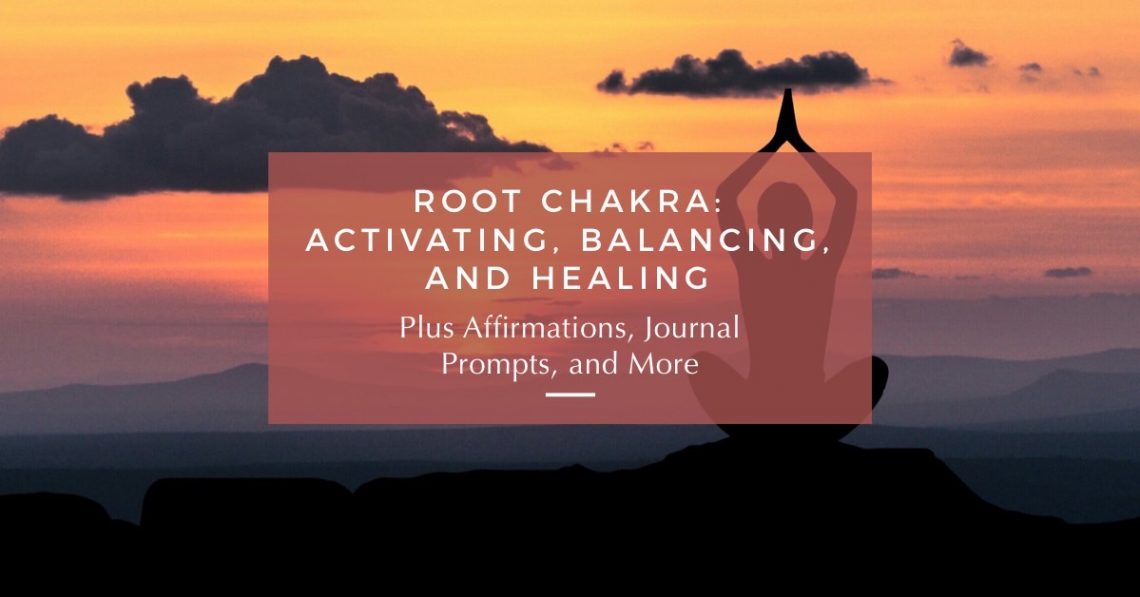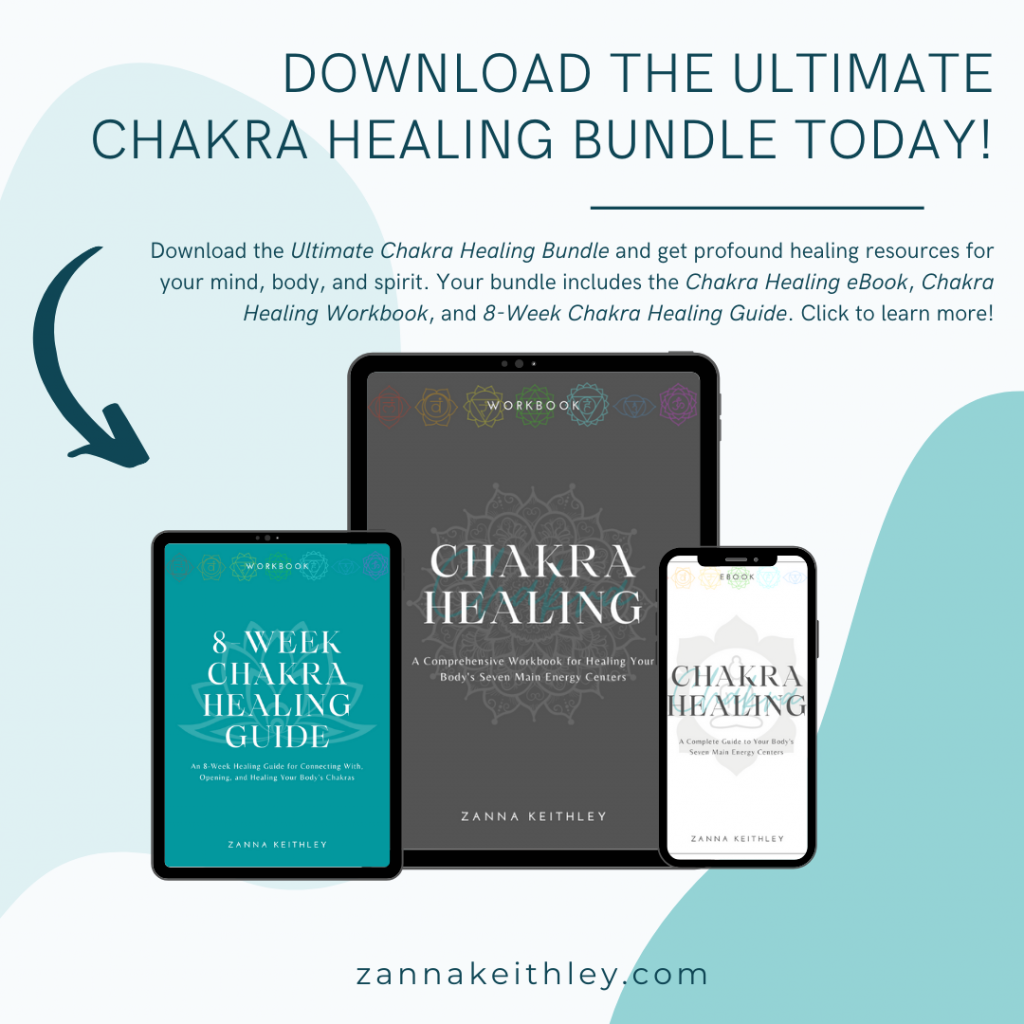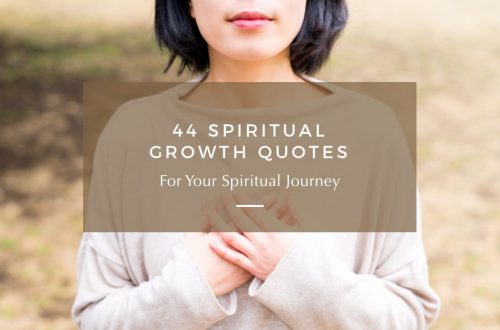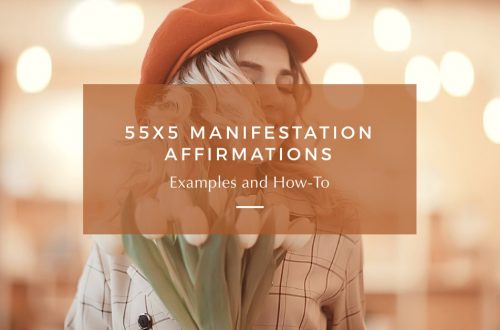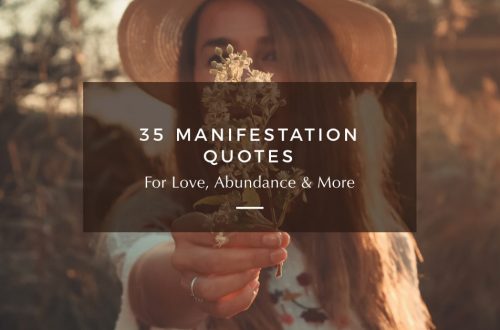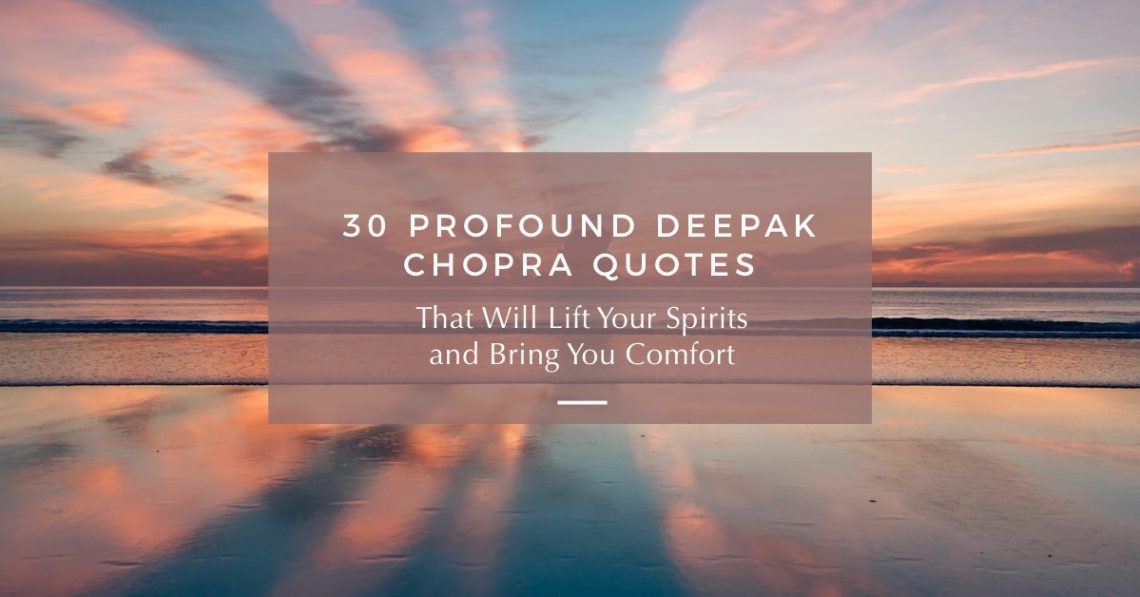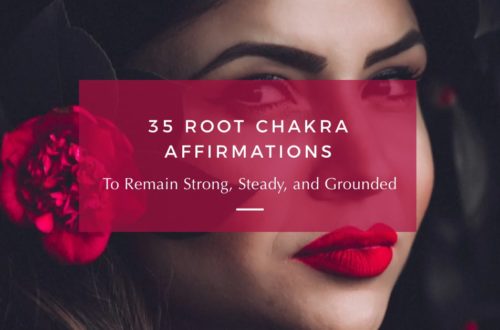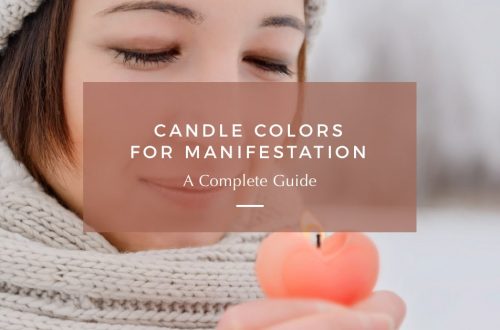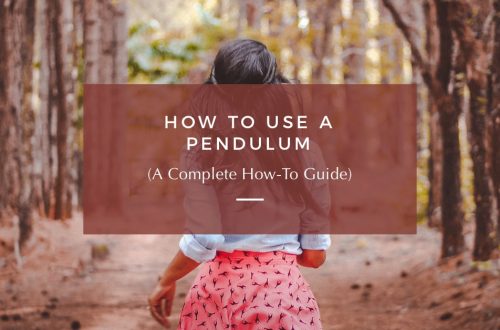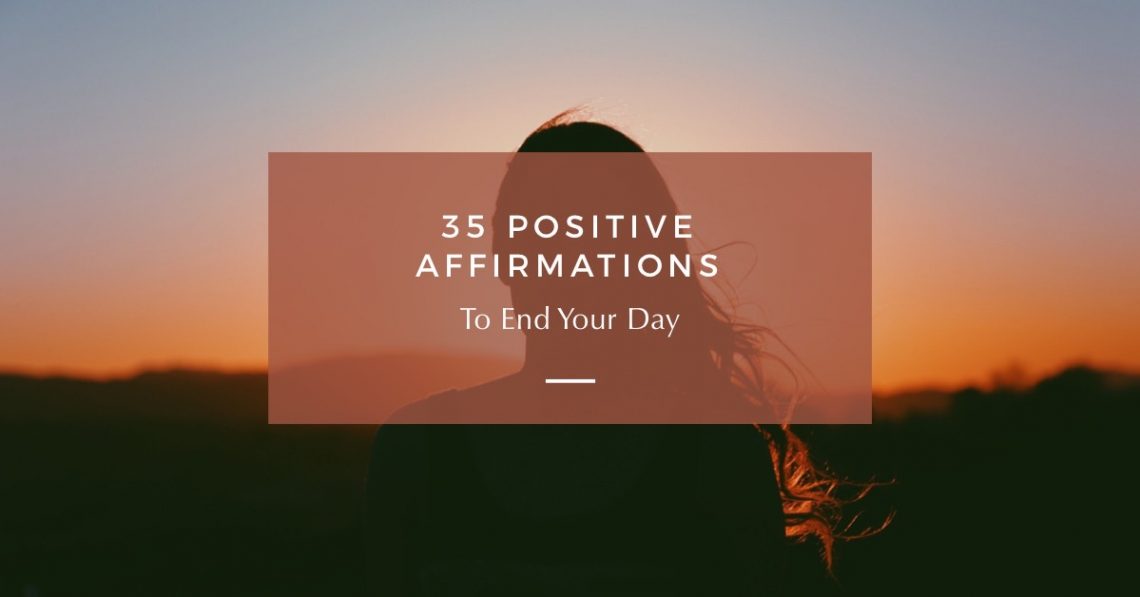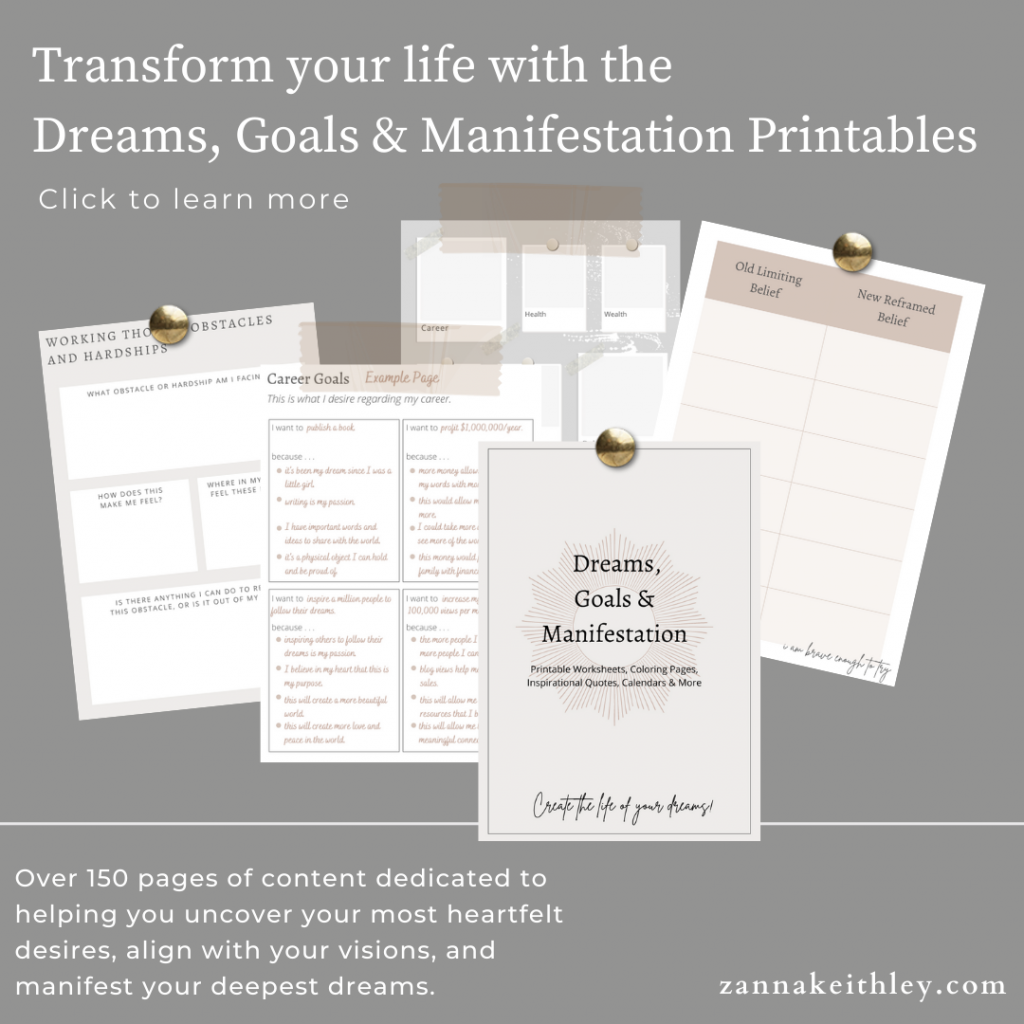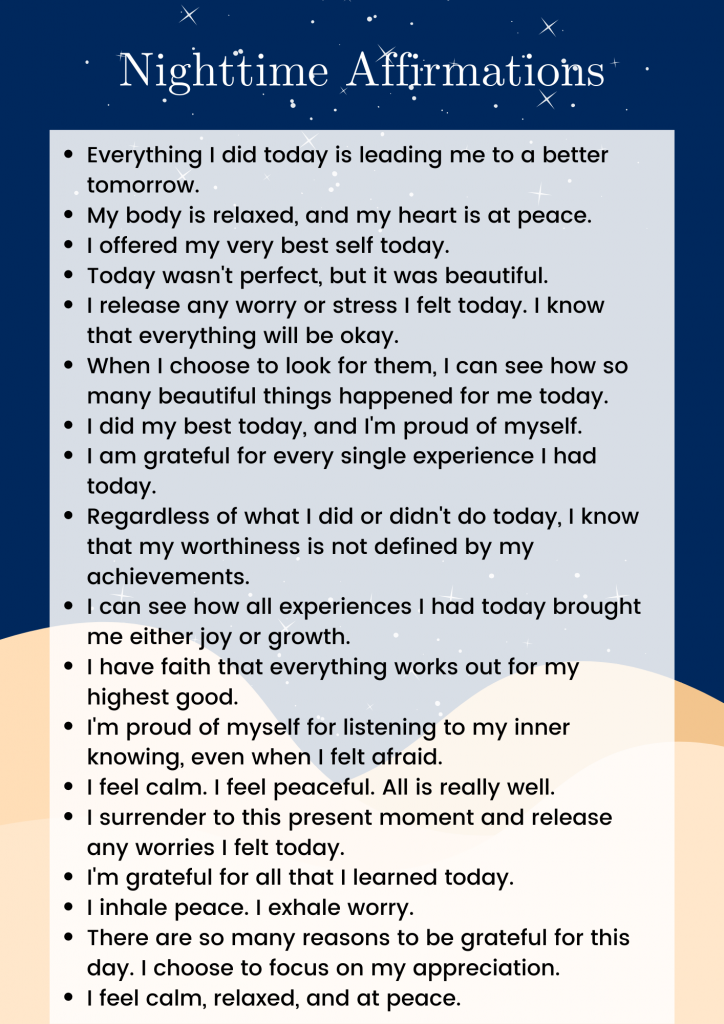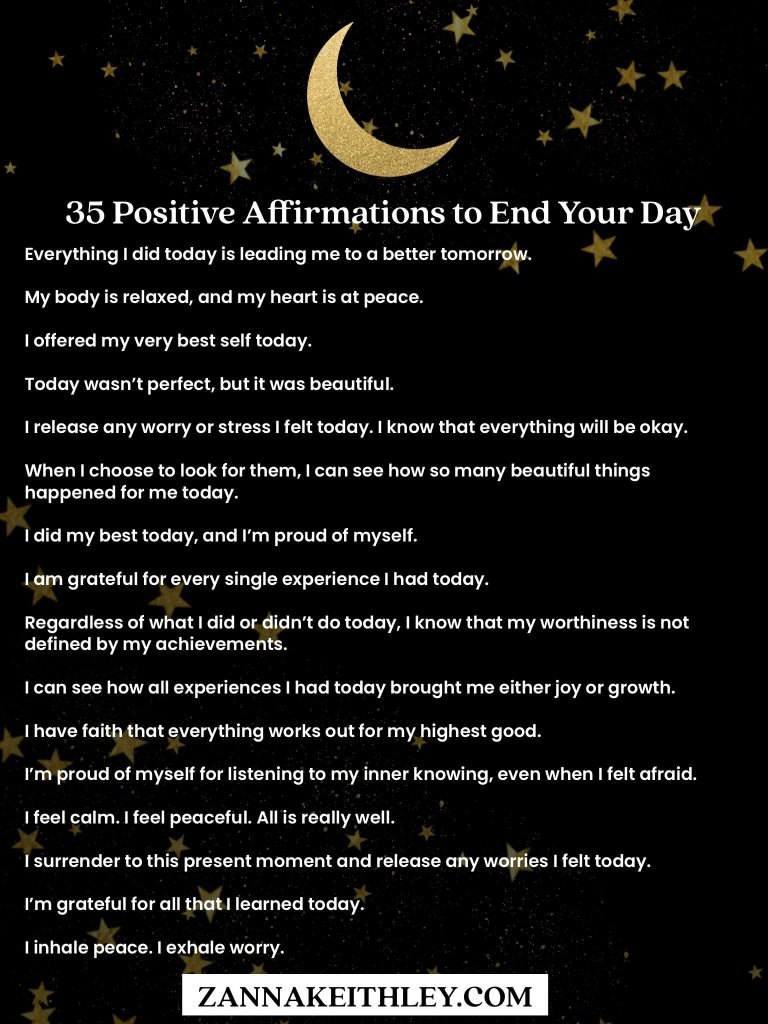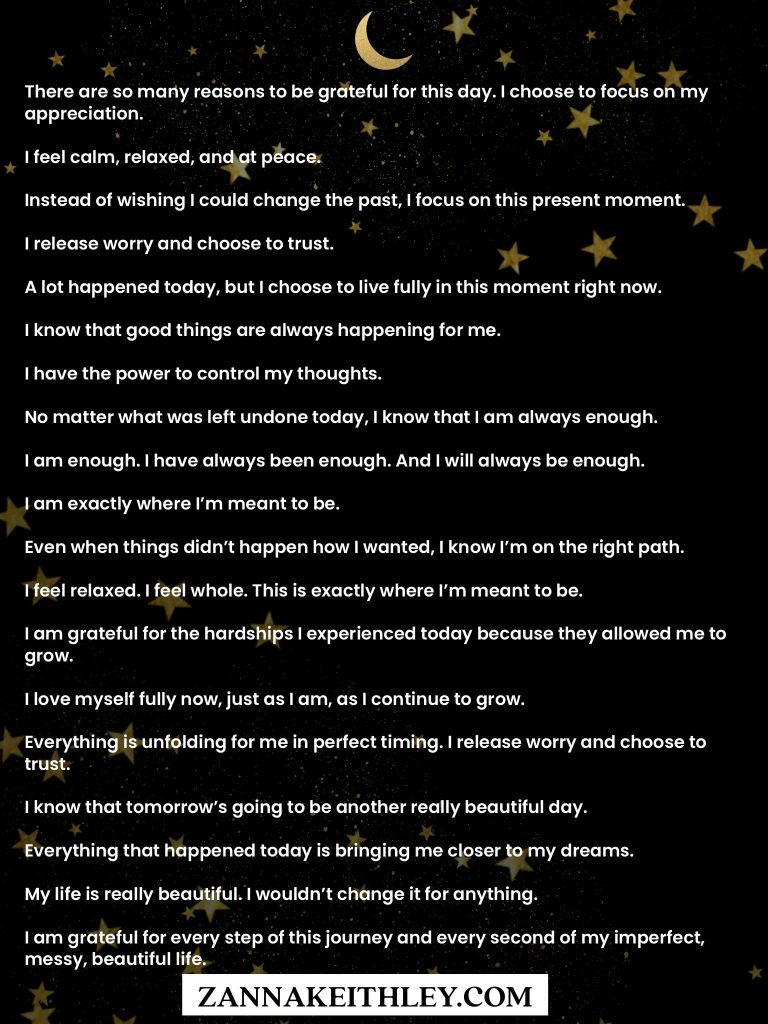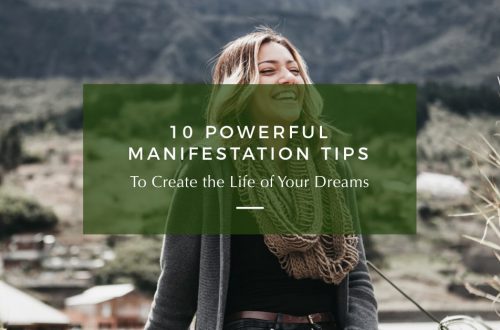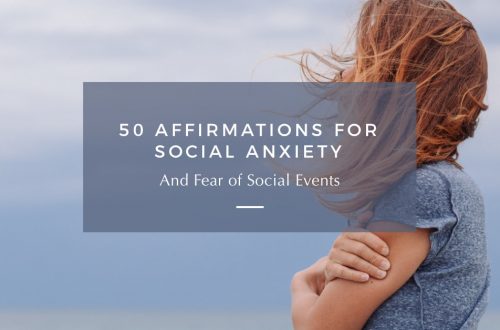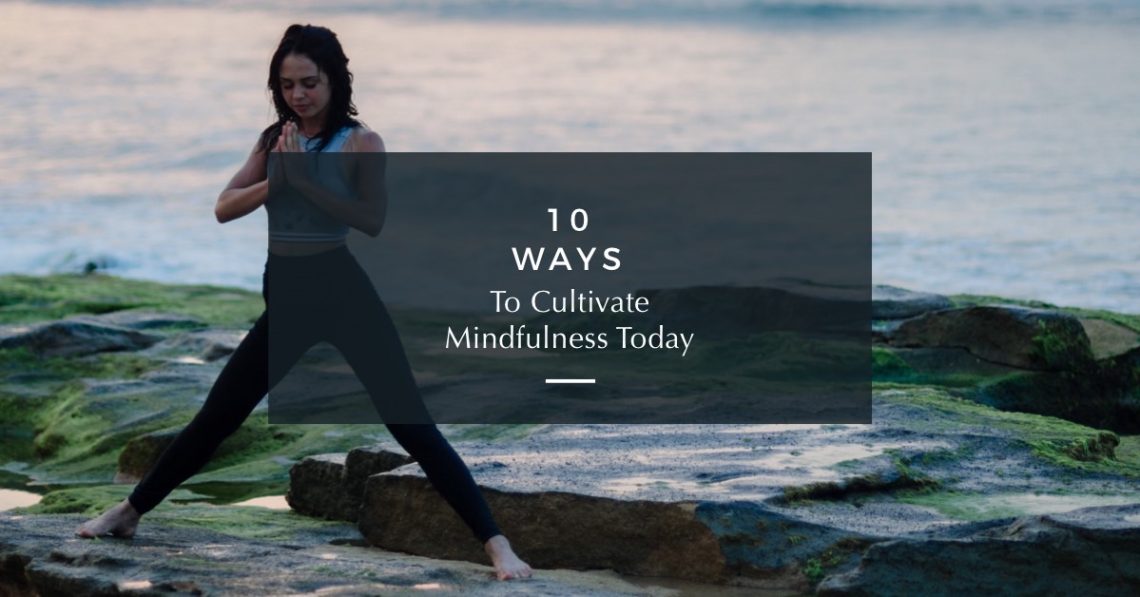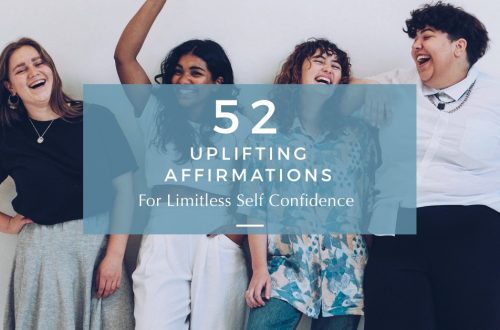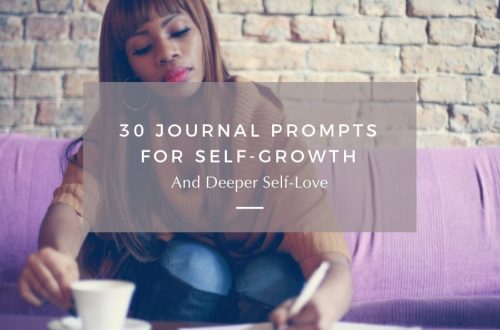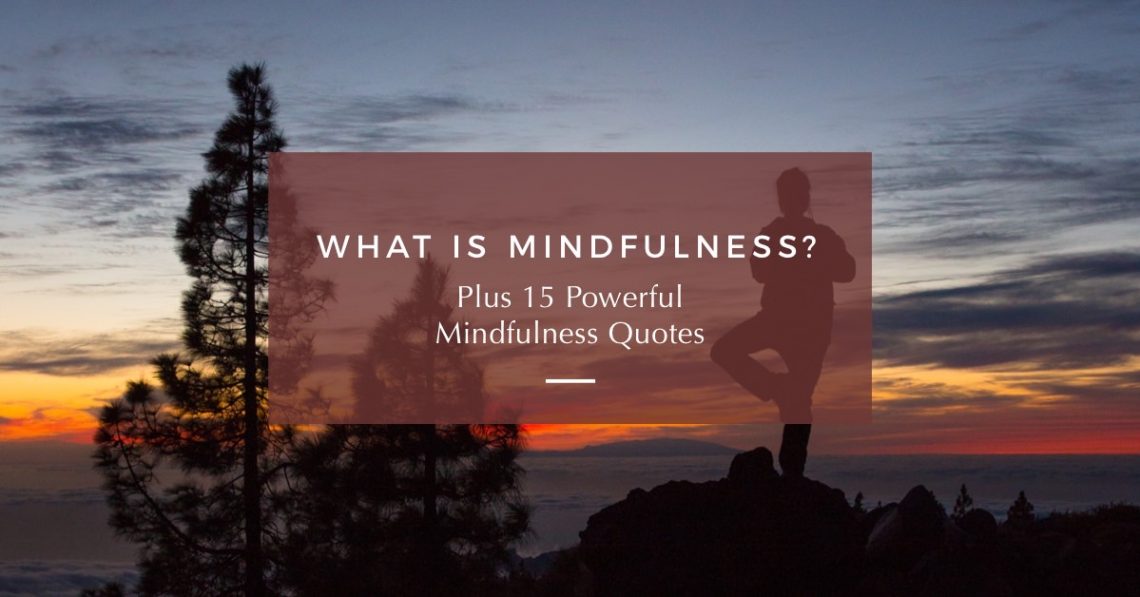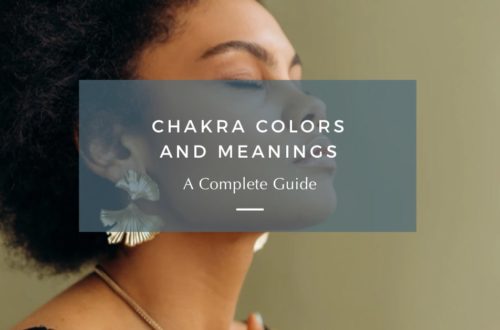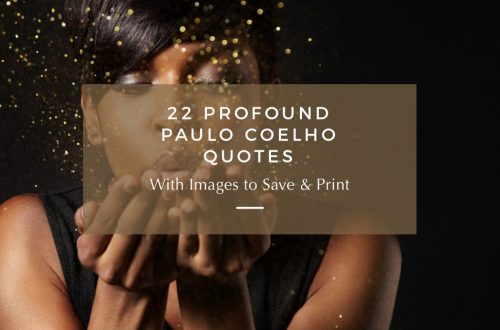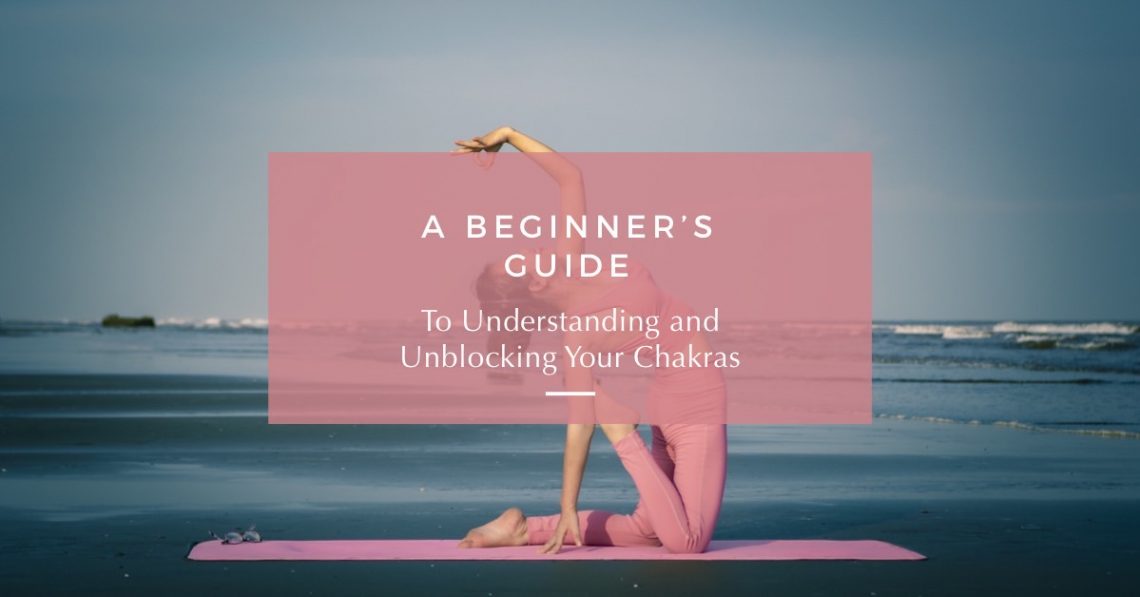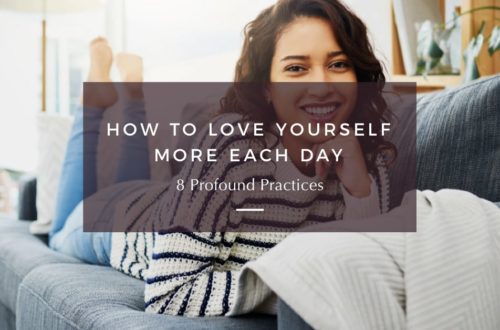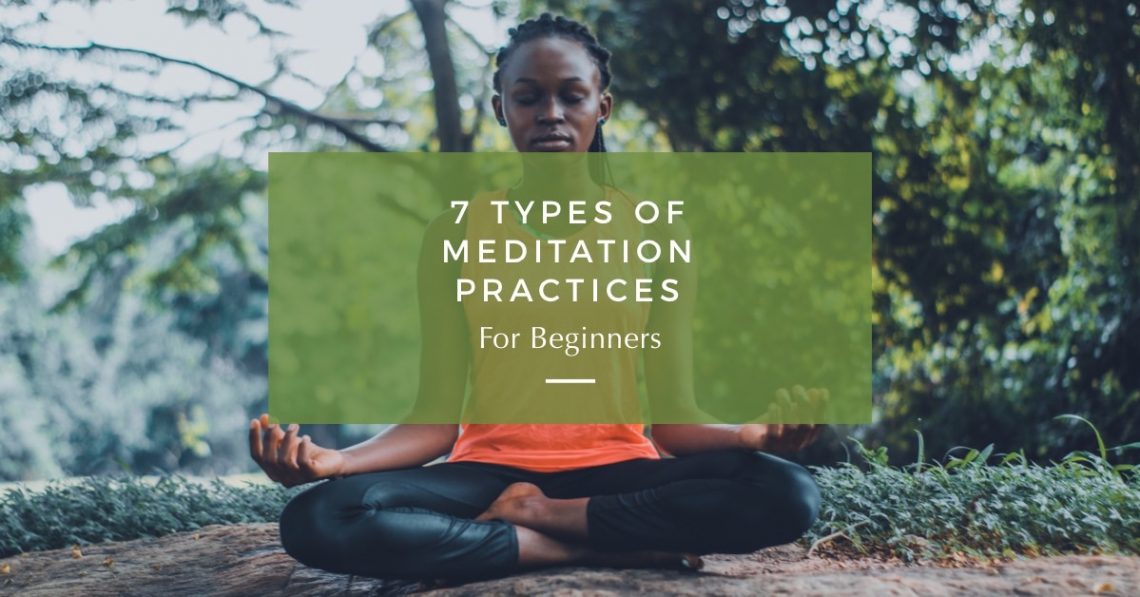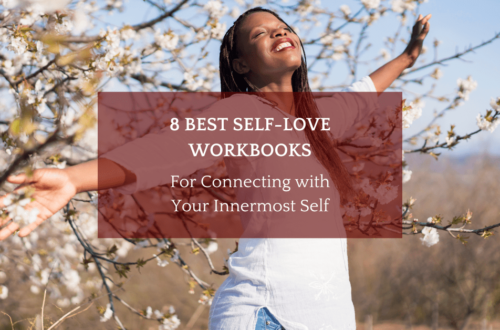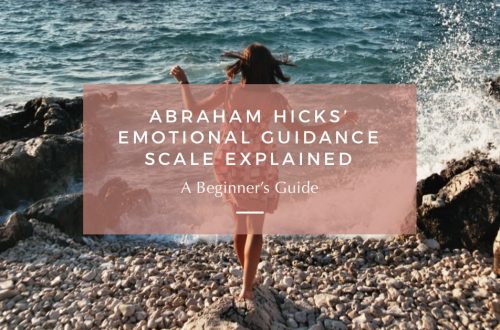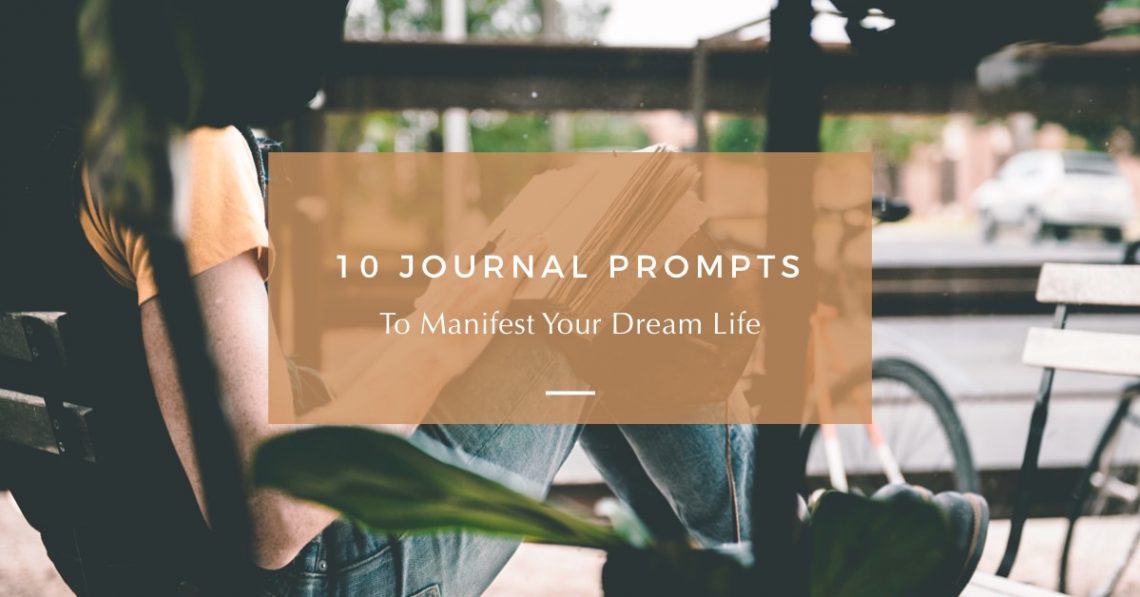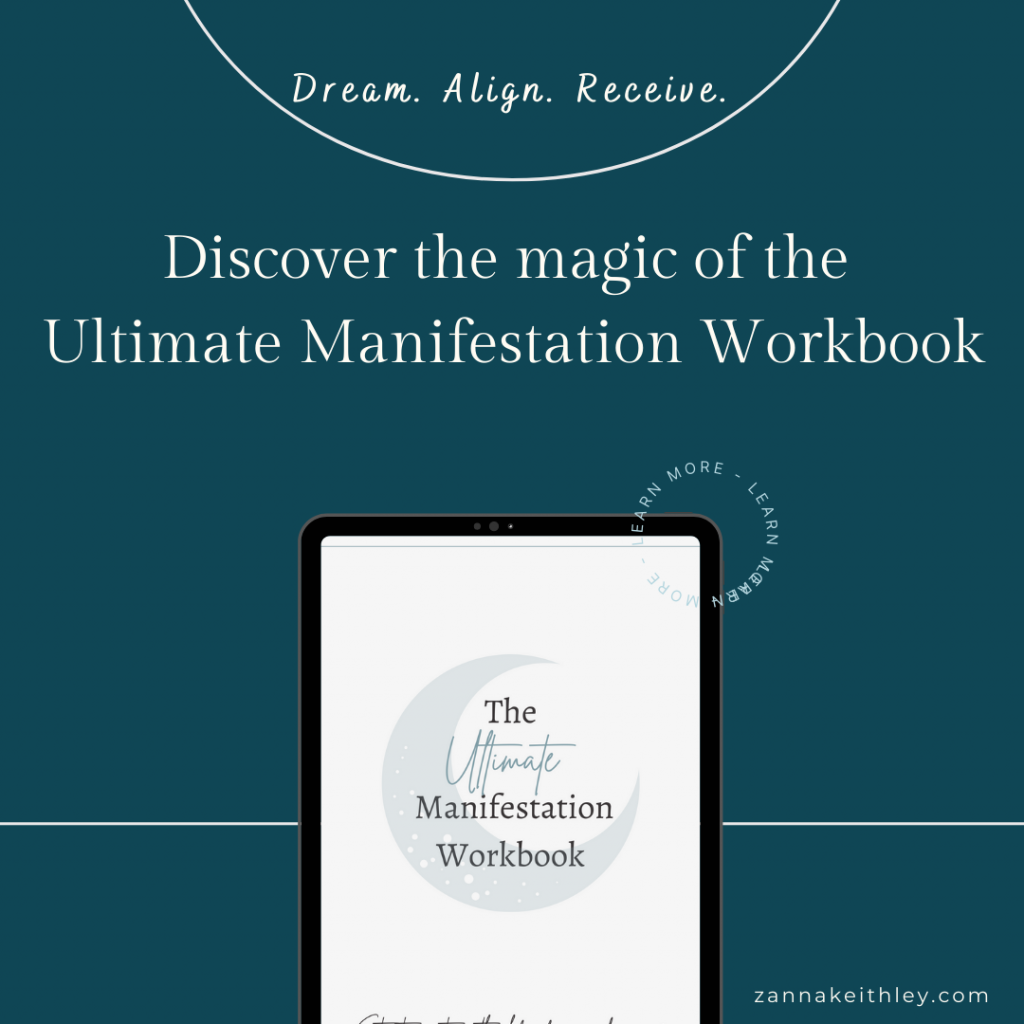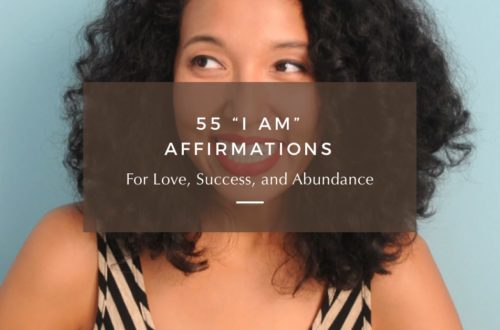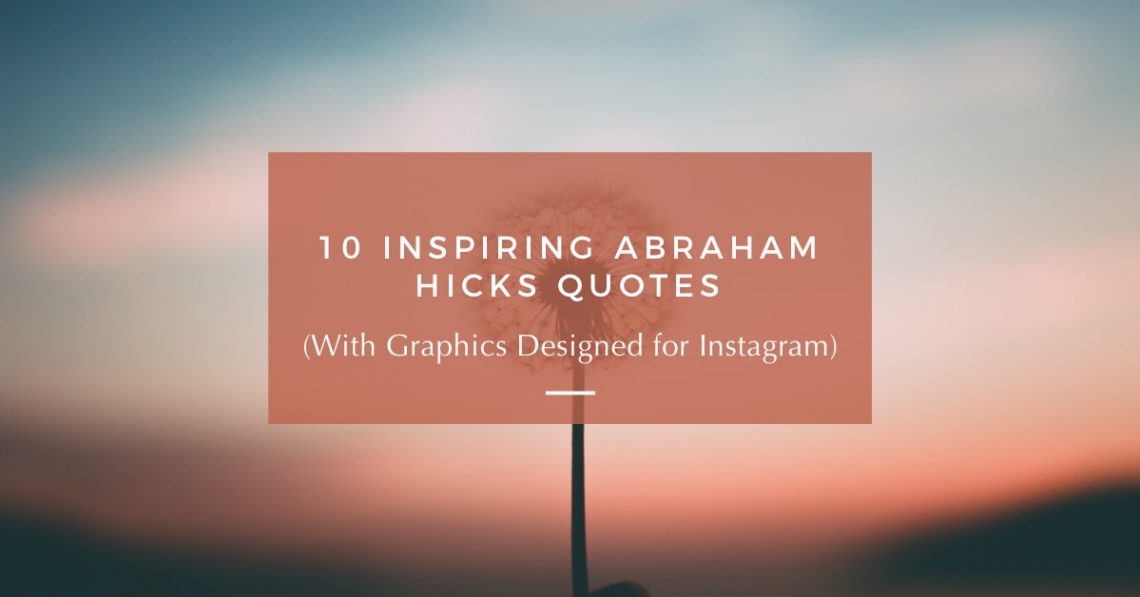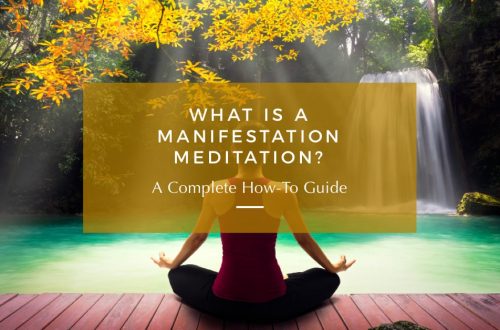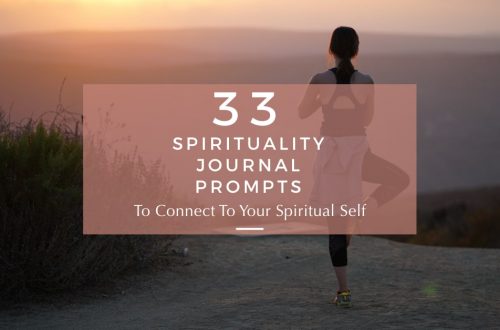-
What is the Root Chakra? Activate, Balance, and Heal
This post is dedicated to all things root chakra, your body’s first energy center. This is the first of a seven-part series on the seven main chakras. For more information on chakras, including what a chakra is and an overview on the seven chakras, check out A Beginner’s Guide to Understanding and Unblocking Your Chakras.
Be sure to scroll to the bottom of this page for some awesome freebies! You’ll receive 35 free printable affirmations and 30 journal prompts to open and heal the root chakra. Don’t miss these powerful healing tools!
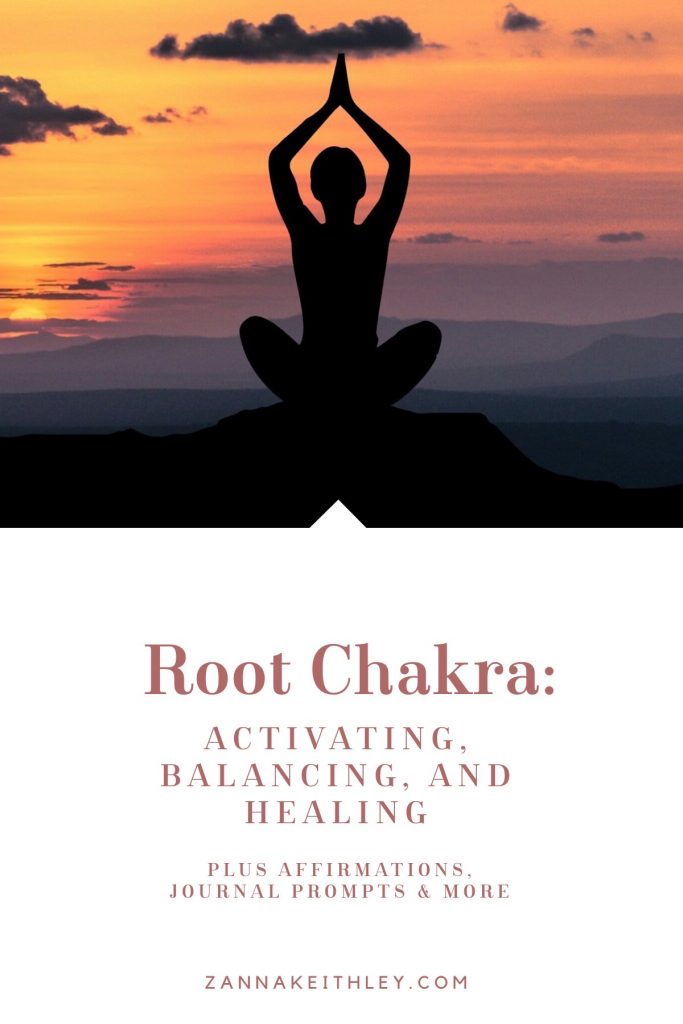
Pin this for later! Root Chakra: Activating, Balancing, and Healing Discover More About Chakras
Discover more about chakras using the links below, plus get journal prompts and affirmations for each of your body’s main energy centers! And for deeper insight into chakras as well as guidance on profound chakra healing, check out my Ultimate Chakra Healing Bundle, which includes a Chakra Healing eBook, Chakra Healing Workbook, and 8-Week Chakra Healing Guide. You can also discover more in my online shop.
What is the Root Chakra?
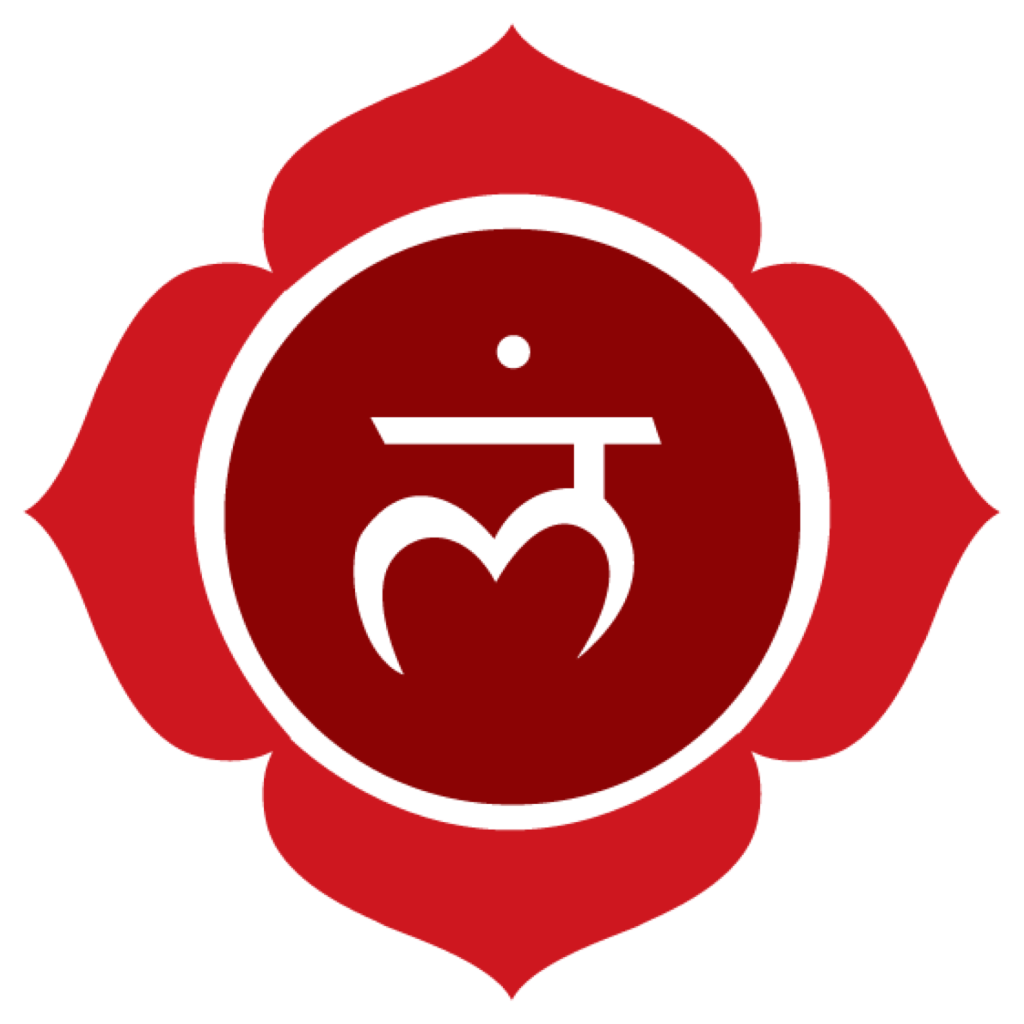
To begin a series on chakras, it’s fitting to start with the root chakra for many reasons.
For one, it’s often called the “1st” chakra. Located at the base of your spine, the root chakra is the lowest energy center on your body. When you hear someone refer to 1st chakra, 2nd chakra, 3rd chakra, etc., this means they’re usually starting with this lowest energy center and working upwards.
But even deeper than that, the root chakra is your foundation. You can think of this like a foundation of a house, holding the house up and keeping it safe and secure. You might also compare it to the roots of a tree, keeping the tree steady, stable, and supported.
Without this strong foundation keeping these structures upright, any strong gust of wind could knock it down at any moment.
This is the same for us.
Why Balancing the Root Chakra is Important
We may not think of ourselves as having foundations because we are constantly moving.
However, even though we’re on the move, most of the time, we have one or more body parts, most often our feet, connected to the ground. This is our physical foundation.
Beyond our physical foundation, we have a foundation of basic needs we need to survive. You might think of Maslow’s Hierarchy of Needs here. At our most basic level, before anything else, we have physiological and safety needs, such as food, water, warmth, rest, security, and safety.
So without a solid foundation to support us, it would be difficult, likely even impossible, to fully meet our other needs such as intimate relationships and creativity.
This is why it makes sense to start with the root chakra. Because without a balanced root chakra, it would be nearly impossible to find balance in our other energy centers. Likely, some would become overstimulated while others would become understimulated.
It’s important to remember that even though these seven main chakras are all separate energy centers, they act as one complete system. When one is out of balance, it’s likely this will affect one or more of the others.
In this post, we’re going to cover all things related to the root chakra: signs of balance and imbalance, affirmations, journal prompts, how to heal an imbalanced root chakra, and various associated attributes.
Root Chakra Attributes
- Sanskrit Name: Muladhara (Mula: “root”; Adhara: “support” or “base”)
- Location: Base of spine
- Color: Red
- Body Parts: Legs, tailbone, kidneys, prostate, bladder, colon
- Symbol: Lotus with four petals
- Element: Earth
- Mantra: LAM
- Gemstones: Obsidian, Hematite, Bloodstone, Red Jasper, Black Tourmaline, Garnet, Onyx, Smoky Quartz
- Essential Oils: Cedarwood, rosemary, sandalwood, basil, and patchouli. (Earthy scents.)
Signs of a Balanced Root Chakra
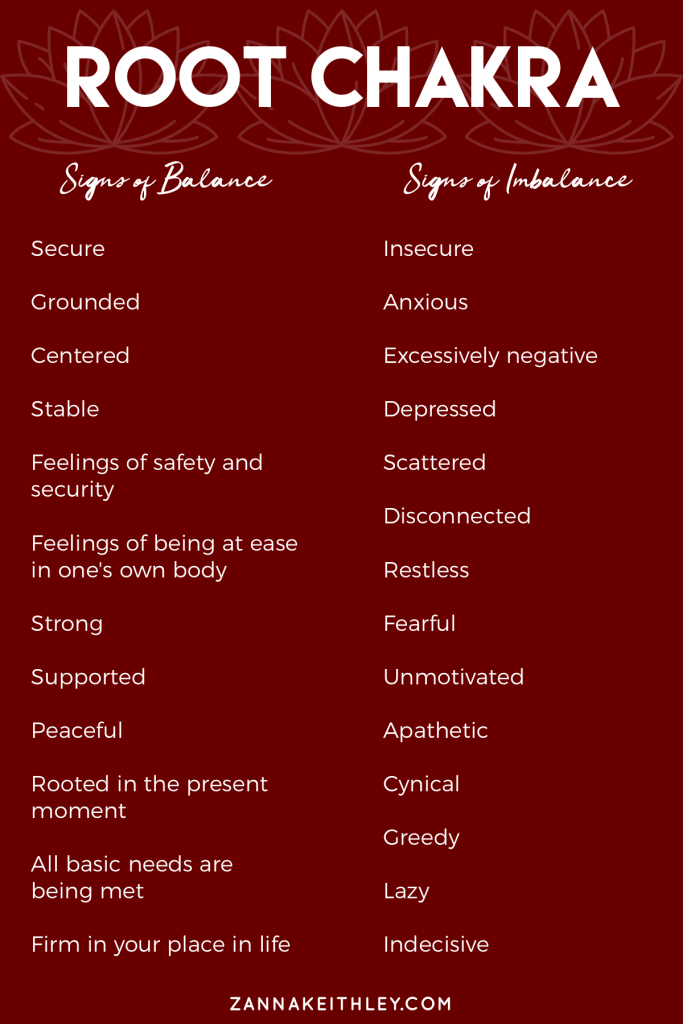
A balanced root chakra is associated with feelings of steadiness, security, safety, and ease. Again, you can think of yourself as a tree with your roots firmly holding your place in the ground. The wind may come, but it will not bend or break your solid foundation.
We also associate a balanced root chakra with how our mind and spirit feel inside our body. Generally speaking, there’s a sense of safety in one own’s body. You can move with ease and feel secure just as you are.
Here’s a list of signs and feelings attributed to a balanced root chakra:
- Secure
- Grounded
- Centered
- Stable
- Feelings of safety and security
- Feelings of being at ease in one’s own body
- Strong
- Supported
- Peaceful
- Rooted in the present moment
- All basic needs are being met
- Firm in your place in life
Signs of an Imbalanced Root Chakra
As we associate a balanced root chakra with feelings of safety, stability, and ease in our bodies, an imbalanced root chakra results in feelings of instability, restlessness, and fear. This can manifest in many ways. For instance, when the COVID-19 pandemic started, one of the main news headlines was how people were hoarding items such as toilet paper. While this seemed unreasonable and greedy, believe it or not, it actually makes sense.
You see, the pandemic shattered a lot of people’s safe and stable foundations. Because of this, many overcompensated by trying to gain back a feeling of stability. Hoarding and greed are two ways we overcompensate when our foundations are shattered. So by hoarding extra toilet paper and food items, this was an attempt by many to restabilize their shaky foundations.
Here’s a list of signs and attributes of an imbalanced root chakra:
- Insecure
- Anxious
- Excessively negative
- Depressed
- Scattered
- Disconnected
- Restless
- Fearful
- Unmotivated
- Apathetic
- Cynical
- Greedy
- Lazy
- Indecisive
Physical Signs of an Imbalanced Root Chakra
An imbalanced root chakra doesn’t just affect our emotions; it affects our physical body as well. As this energy center is located at the base of the spine, an imbalance of energy most often affects the body parts and organs in the surrounding areas.
I just want to note that I often see “eating disorders” listed under the physical symptoms, and I listed it below, but as many of us know, an eating disorder is much, much more than a physical thing. This also involves our mental and emotional health. When our foundations aren’t stable, food is often used as a means for taking back control. Undereating and restricting food is often a way for one to exercise control over their lives, especially when it feels like the external world is completely out of control. Overeating can also be a result of an unsteady foundation, especially overeating comfort foods, as one looks for an easy way to bring themselves comfort in the midst of uncertainty.
But no two stories are ever the same, and I don’t want to oversimplify something as complex as an eating disorder. Here is more information about eating disorders from the National Eating Disorders Association.
These are some of the physical ailments you may experience with an imbalanced root chakra:
- Constipation
- Digestive Issues
- Eating Disorders
- Lower Body Pain
- Sciatica
- Anemia
- Numbness
Root Chakra Affirmations
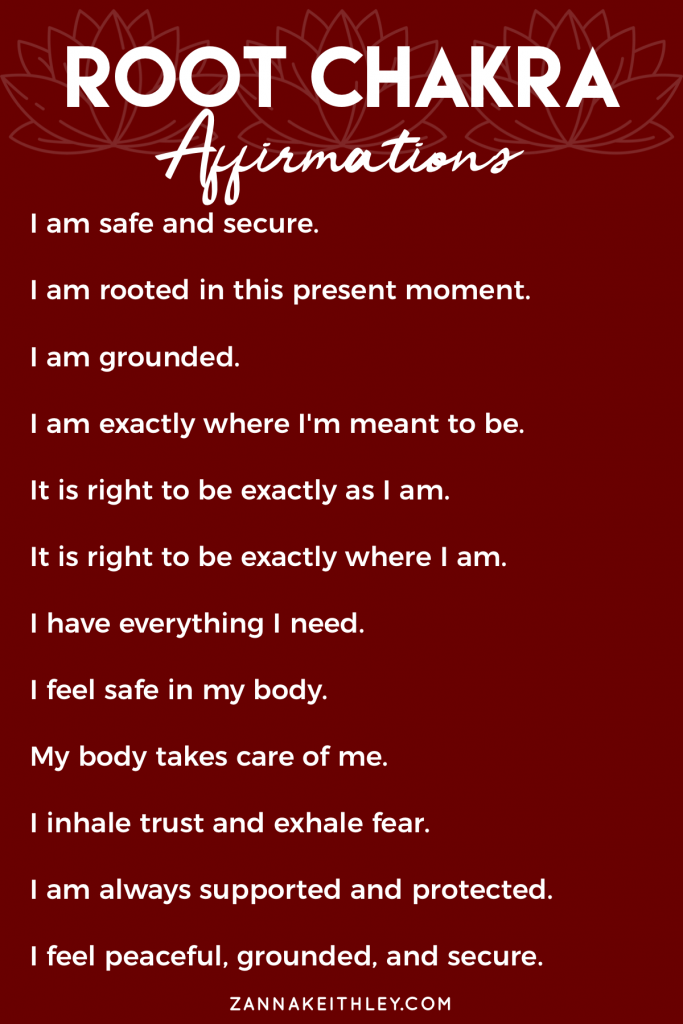
I absolutely love affirmations and try to incorporate them into as many areas of my life as possible. And luckily, it’s really pretty easy. Affirmations can be used pretty much anytime: when you first wake up, while you’re in the shower, as you’re commuting to work, while you’re waiting in line at the grocery store, or before you go to bed at night.
To make the most of root chakra affirmations, first set the intention to balance your root chakra, and be intentional with your words. One of my favorite ways to use affirmations is to incorporate them into journaling, or even by keeping a journal solely for affirmations. The key here is to always use the present tense and to feel the positive emotions associated with the words as you repeat or write them down.
And for more grounding root chakra affirmations, check out my post, 35 Root Chakra Affirmations to Remain Strong, Steady, and Grounded. And be sure to scroll to the bottom of this page to get your free printable affirmations and journal prompts!
Affirmations
- I am safe and secure.
- I am rooted in this present moment.
- I am grounded.
- I am exactly where I’m meant to be.
- It is right to be exactly as I am.
- It is right to be exactly where I am.
- I have everything I need.
- I feel safe in my body.
- My body takes care of me.
- I inhale trust and exhale fear.
- I am always supported and protected.
- I feel peaceful, grounded, and secure.
Root Chakra Journal Prompts
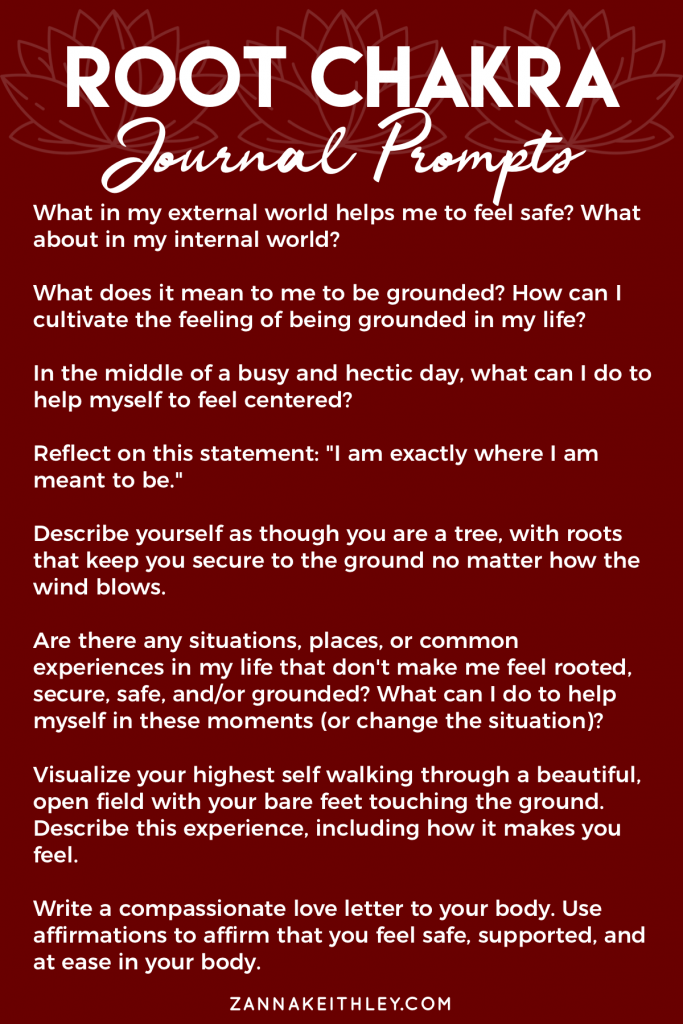
Journaling is one of my favorite self-care practices, and it’s a great method for healing chakras and realigning your energy. I like to journal for thirty minutes first thing after I wake up so I can set my intentions for the day and start the day off with some positivity. However, everyone’s journaling practice is different and personal to them. Choose the time that works best for you, and allot as much or as little time as you can allow, even if it’s just ten minutes.
And for more powerful journal prompts, check out 30 Journal Prompts to Open and Heal the Root Chakra.
Journal Prompts
- What in my external world helps me to feel safe? What about in my internal world?
- What does it mean to me to be grounded? How can I cultivate the feeling of being grounded in my life?
- In the middle of a busy and hectic day, what can I do to help myself to feel centered?
- Reflect on this statement: “I am exactly where I am meant to be.”
- Describe yourself as though you are a tree, with roots that keep you secure to the ground no matter how the wind blows.
- Are there any situations, places, or common experiences in my life that don’t make me feel rooted, secure, safe, and/or grounded? What can I do to help myself in these moments (or change the situation)?
- Visualize your highest self walking through a beautiful, open field with your bare feet touching the ground. Describe this experience, including how it makes you feel.
- Write a compassionate love letter to your body. Use affirmations to affirm that you feel safe, supported, and at ease in your body.
Activating & Healing the Root Chakra
Below are 8 powerful practices for root chakra healing. For deeper insight into how to open, balance, and heal the root chakra, check out my post, Root Chakra Healing: Open & Balane the Root Chakra.
Color Therapy
When you feel like one of your chakras is imbalanced, color therapy is one of the most common and prominent ways to bring that energy center back into balance. Color therapy is immersing yourself in the color associated with that chakra. For the root chakra, this means immersing yourself in all things red. Eat red food. Wear red clothes. Light red candles. (If they’re earth-scented, that’s even better.) If possible, surround yourself with as many red items in your immediate environment as possible. You could even have some painting materials on hand for these moments. Let your inner creative come out and paint an image entirely in the color red.
Journaling
Affirmations journaling is especially powerful in these moments. Affirm to yourself that you are safe and secure and exactly where you are meant to be. You can also use any of the journaling prompts above. I also like to visualize that I’m my highest and most authentic self and write as my highest self. For the root chakra specifically, you can write as your highest and most centered self living your safest, most grounded life. Describe the feelings of being secure in your body as well as feeling secure in the present moment.
Walk Barefoot in the Dirt
The root chakra is associated with the earth, so this is the perfect time to immerse yourself in nature and let your bare feet touch the ground. Of course, this may be more difficult for some depending on where you live. If possible, try to find a place to immerse yourself in nature for a bit. Our nature is truly our foundation, so this allows us to (no pun intended) get back to our roots.
Yoga
Each chakra has associated yoga poses to help heal imbalanced energy. For an imbalanced root chakra, choose poses that allow you to feel balanced and safe. Some poses might include Mountain Pose, Downward Dog, Tree Pose, Lunge Pose, and Warrior II.
Here’s a great video from Yoga With Adriene specifically dedicated to the root chakra.
Meditation
For an unguided root chakra meditation, visualize a glowing red light at the base of your spine. See that light get brighter as you inhale and bigger as you exhale. You might also visualize a red lotus flower at the base of your spine.
Here are some root chakra guided meditations using the free Insight Timer app:
- Root Chakra Love by Hannah Devries
- Root Chakra Therapy by Cory Cochiolo
- Root Chakra Meditation by Sarah Da Silva
Affirmations
I mentioned this one in the journaling section, but if you’re unable to sit down and write, repeating affirmations either silently or aloud is a powerful practice. You can do this while you’re getting ready for the day, showering, commuting to work – anytime, really. You could also combine this with other practices on the list, such as taking a walk in nature.
Gemstones
Use crystals associated with the root chakra to activate this energy center. A powerful way to receive the healing power of the crystal is to hold it during meditation. You can also carry crystals around with you during the day. A few examples of gemstones associated with the root chakra are obsidian, hematite, onyx, bloodstone, red jasper, black tourmaline, and garnet.
Here’s a few more posts to help you get started with using crystals and gemstones to heal the chakras:
Essential Oils
Use earth-scented essential oils, such as cedarwood, rosemary, sandalwood, basil, and patchouli.
With any of the practices above, don’t forget to be intentional with your actions. For instance, if you light candles or use essential oils, do so with the intention to heal or activate your root chakra. Then, let these intentions be your guide as you take the next right step in balancing your energy centers.
For more information on how to use essential oils to heal the chakras, check out my post, A Guide to Essential Oils for Chakra Healing.
And there you have it: how to activate, balance, and heal the root chakra, plus journal prompts and affirmations to help you on your journey!
For more more chakra resources, plus uplifting affirmations and self-love encouragement, be sure to follow me on Pinterest and Instagram!
Are you ready for your freebies? Download your printables below!

Pin this for later! Root Chakra: Activating, Balancing, and Healing 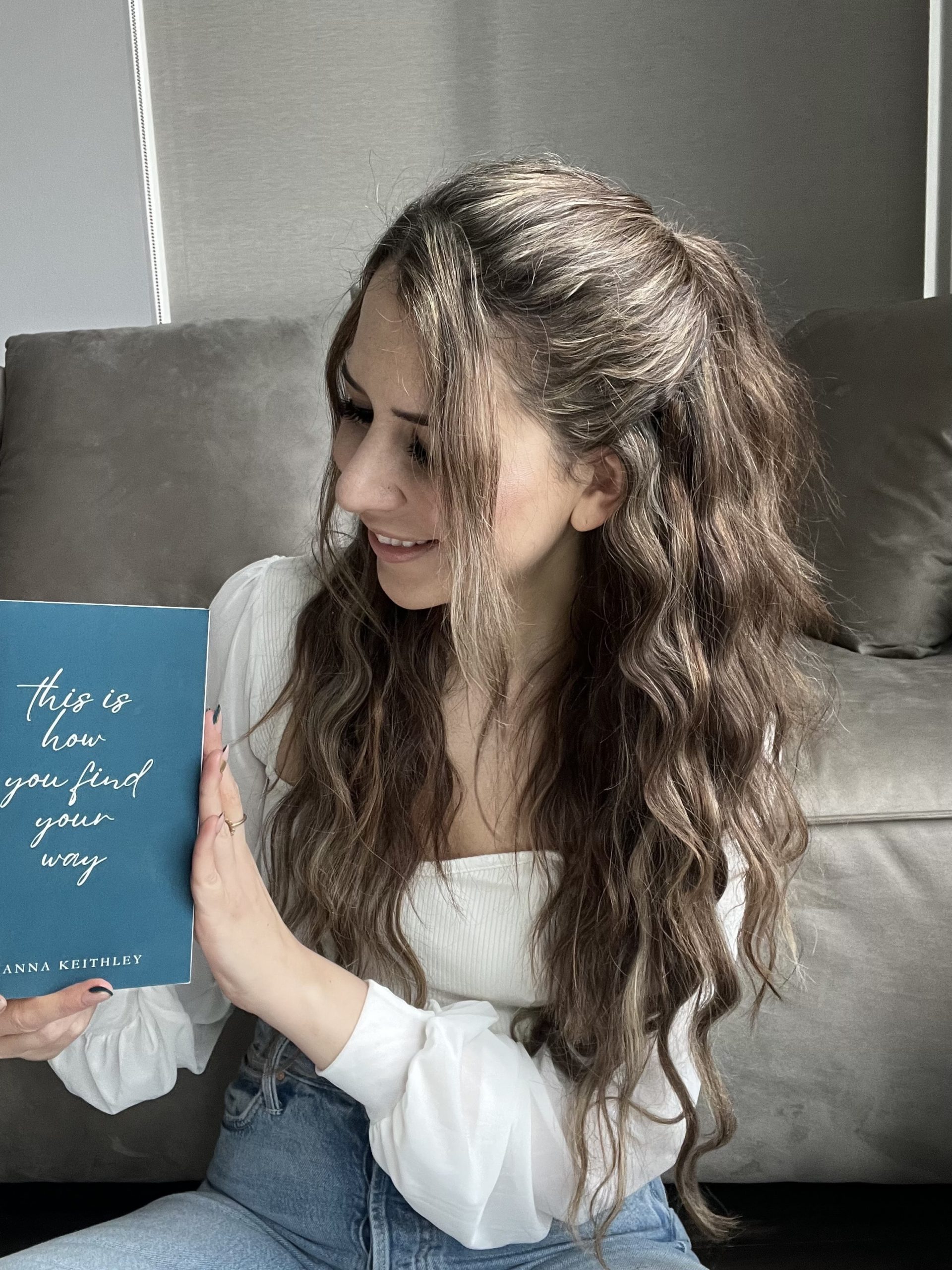
Zanna Keithley is an author, poet, and social media content creator who writes short prose dedicated to inspiring readers to follow their dreams, trust their intuition, and create beautiful and fulfilling lives. You can find her original writing on Instagram @zannakeithley.
-
30 Most Profound Deepak Chopra Quotes
Below, I share 30 of my all-time favorite Deepak Chopra quotes. No matter where you are in life and how you’re feeling, each beautiful quote is meant to uplift, inspire, encourage, and bring comfort to your mind, body, and spirit.

30 Profound Deepak Chopra Quotes Deepak Chopra is an author, public speaker, alternative medicine advocate, and leader in the New Age movement. His words have inspired millions to go after their dreams, live their truths, and cultivate deep relationships between their own minds, bodies, and spirits.
Personally, I find Deepak Chopra’s quotes comforting, inspiring, and often, they’re the exact words I need to hear. I have a handful of writers I can turn to when I’m unable to find the words within myself to lift myself out of a funk, or when I need to gather the courage to step forward onto an unfamiliar path, and he’s at the top of that list.
So when I thought about whose words I wanted to share with you here, I didn’t give it a second thought.
Below are 30 of my all-time favorite Deepak Chopra quotes, meant to comfort, uplift, inspire, and hopefully resonate within you. Feel free to save, share, and turn to these words when you need an extra dose of comfort, inspiration, and love.
Deepak Chopra Quotes
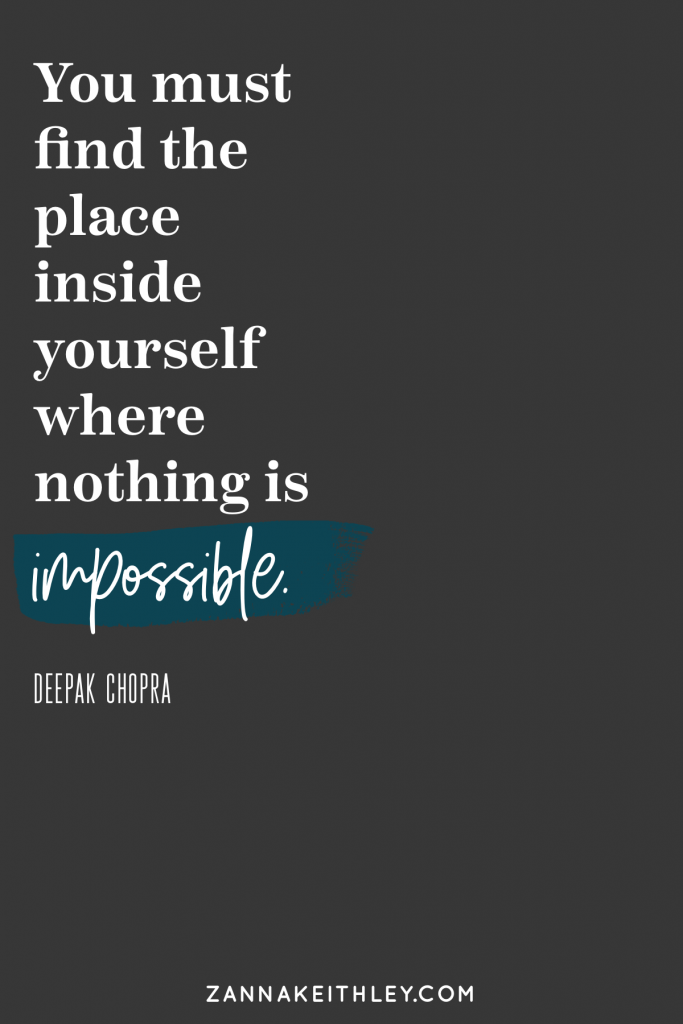
1. “You must find the place inside yourself where nothing is impossible.” 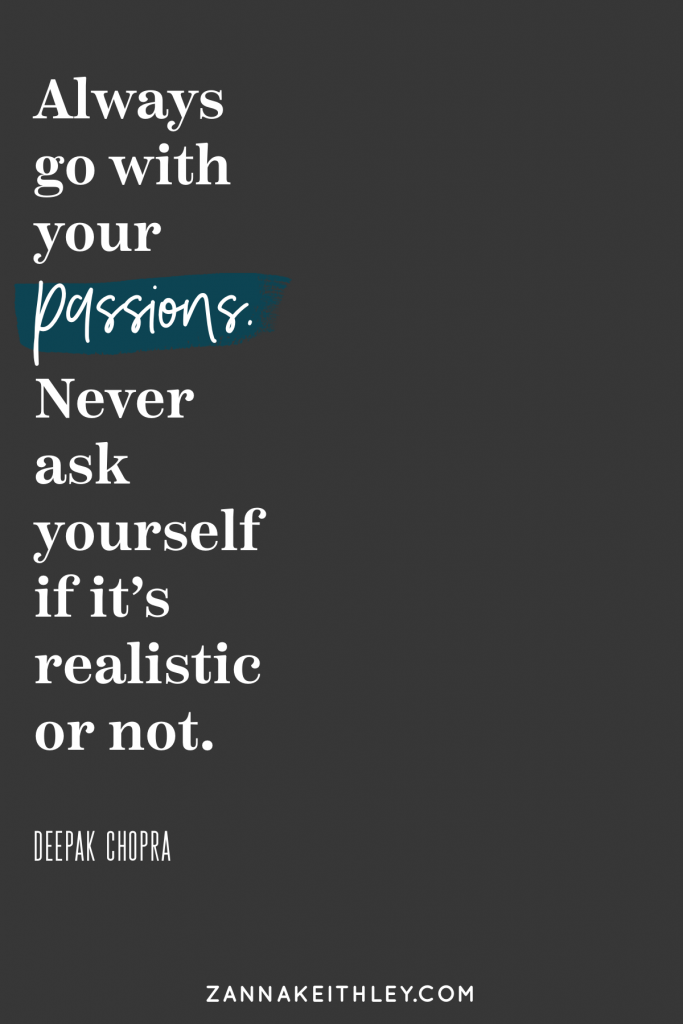
2. “Always go with your passions. Never ask yourself if it’s realistic or not.” 3. “You alone are the judge of your worth and your goal is to discover infinite worth in yourself, no matter what anyone else thinks.”
Deepak Chopra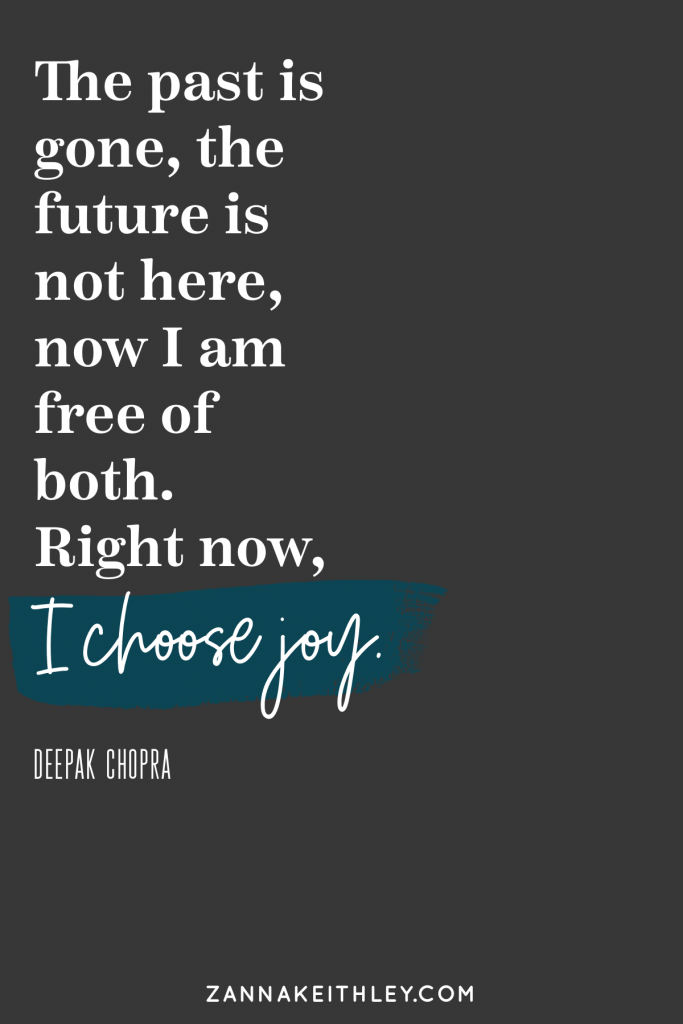
4. “The past is gone, the future is not here, now I am free of both. Right now, I choose joy.” 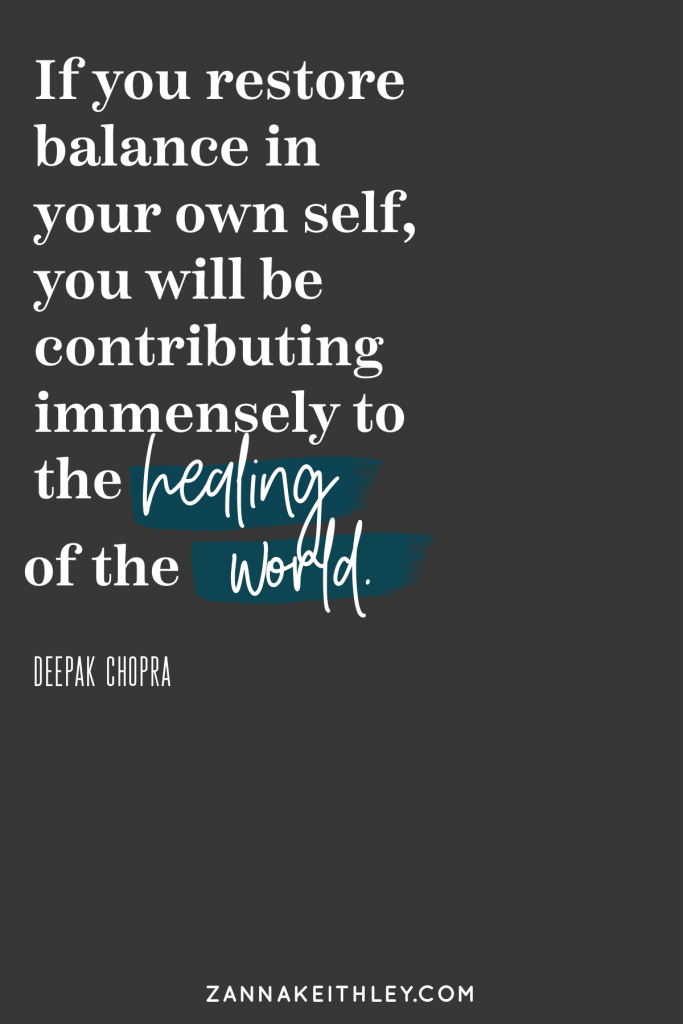
5. “If you restore balance in your own self, you will be contributing immensely to the healing of the world.” 6. “In the process of letting go you will lose many things from the past, but you will find yourself. It will be a permanent Self, rooted in awareness and creativity. Once you have captured this, you have captured the world.”
Deepak Chopra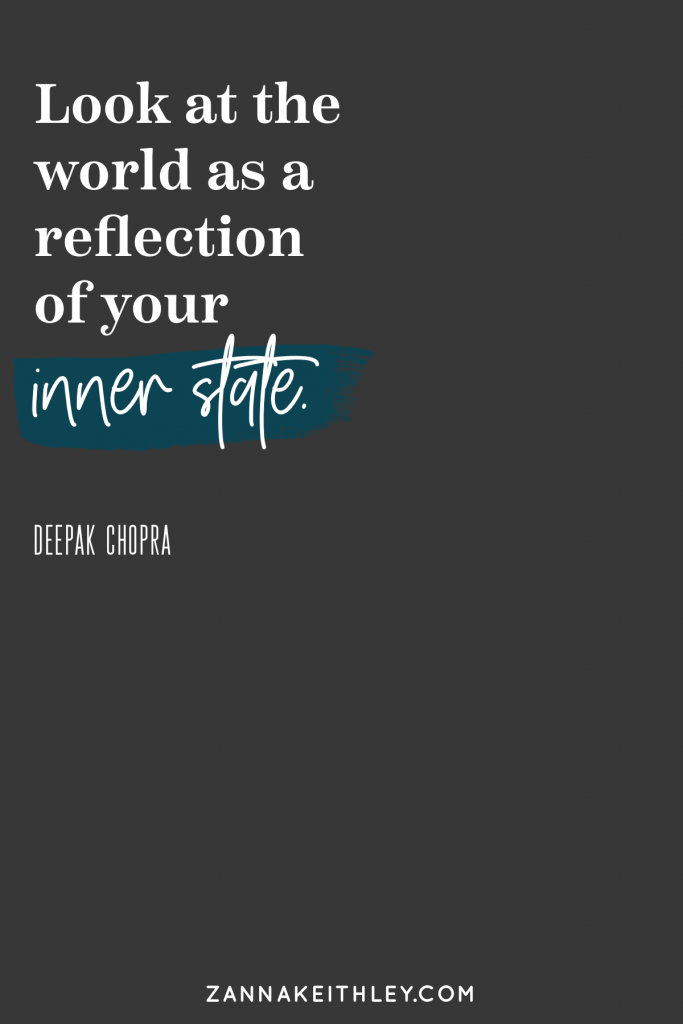
7. “Look at the world as a reflection of your inner state.” 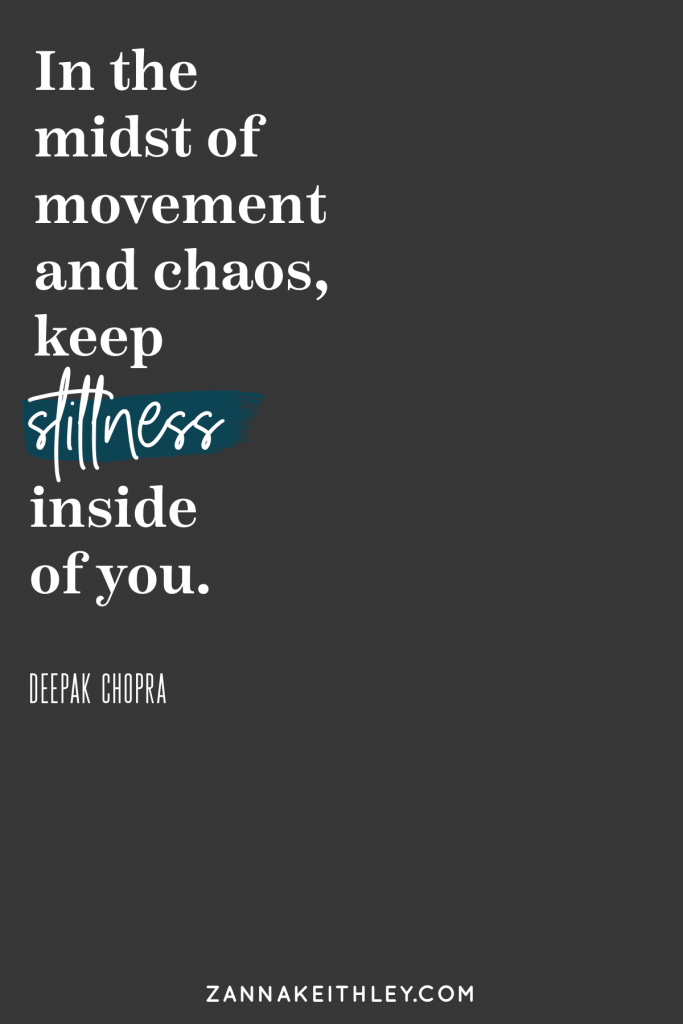
8. “In the midst of movement and chaos, keep stillness inside of you.” 9. “When you expand your awareness, seemingly random events will be seen to fit into a larger purpose.”
Deepak Chopra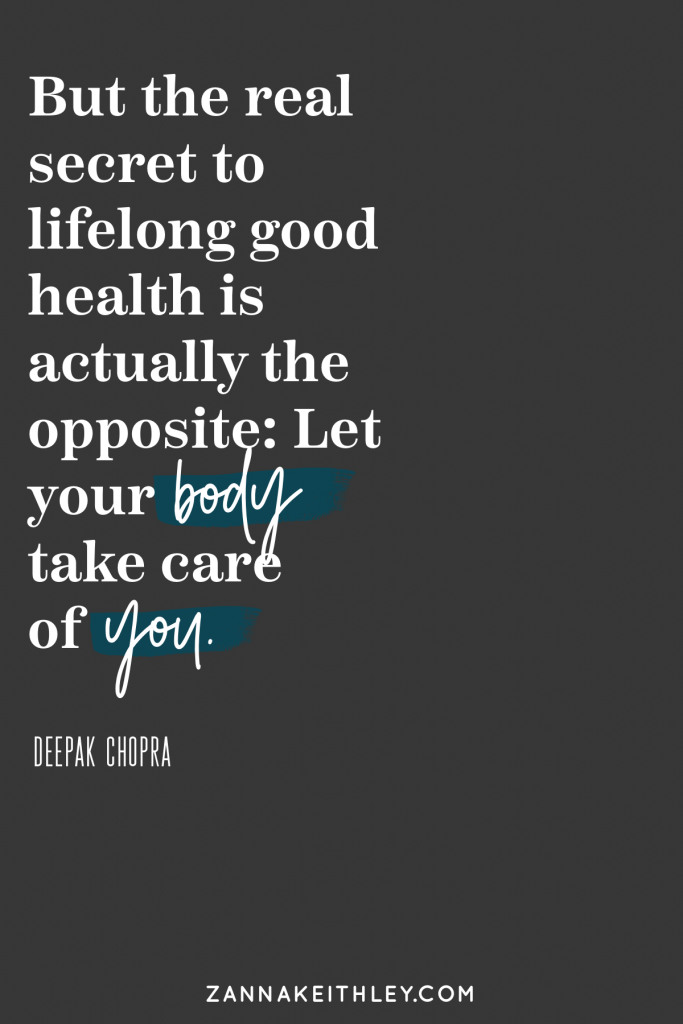
10. “But the real secret to lifelong good health is actually the opposite: Let your body take care of you.” 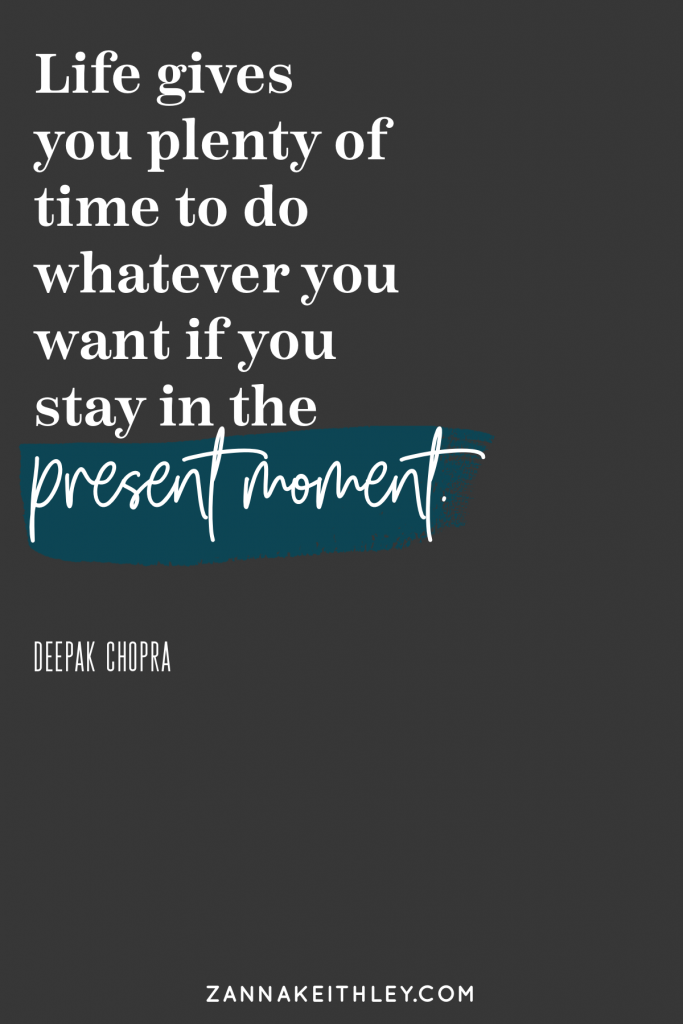
11. “Life gives you plenty of time to do whatever you want to do if you stay in the present moment.” 12. “The whole world opens when we accept this moment, this very moment.”
Deepak Chopra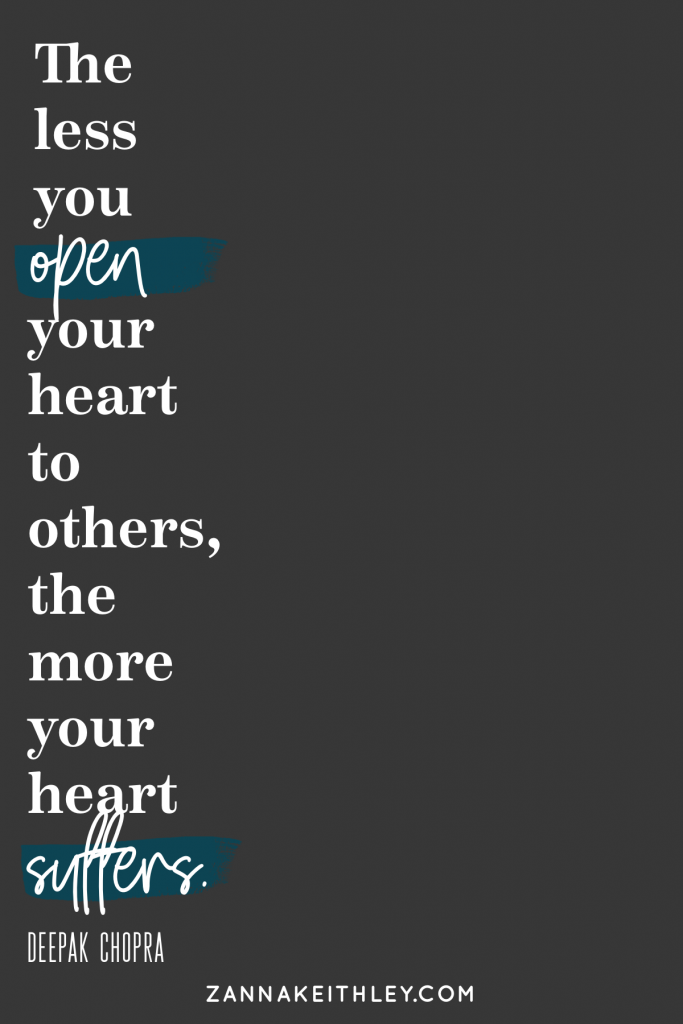
13. “The less you open your heart to others, the more your heart suffers.” 
14. “Nothing is more important than reconnecting with your bliss. Nothing is as rich. Nothing is more real.” 15. “Meditation is not a way of making your mind quiet. It is a way of entering into the quiet that is already there.”
Deepak Chopra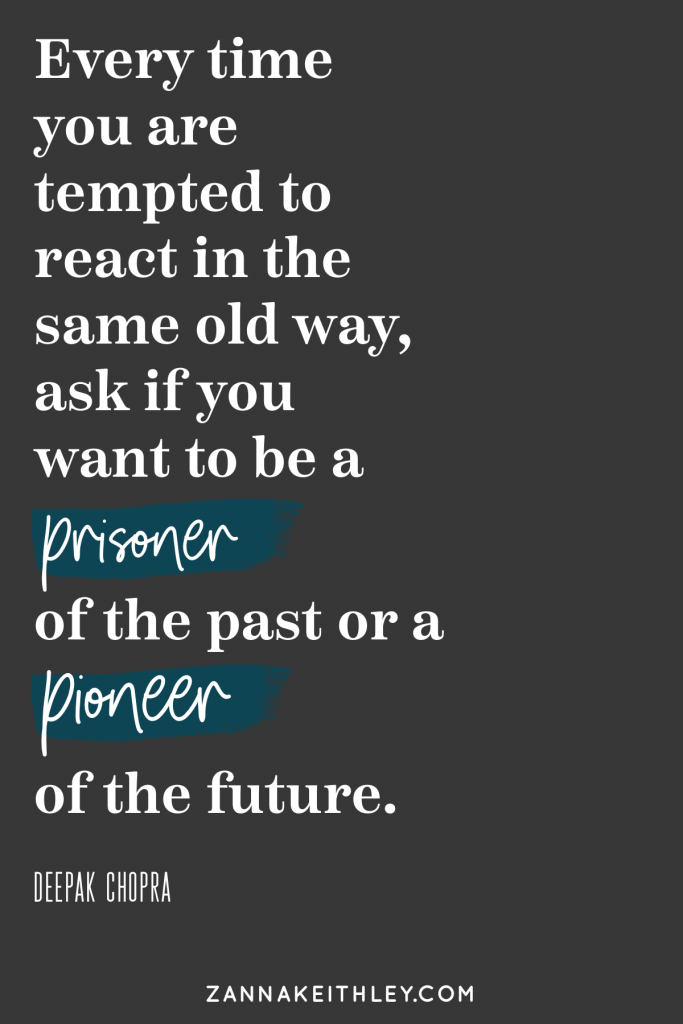
16. “Every time you are tempted to react in the same old way, ask if you want to be a prisoner of the past or a pioneer of the future.” 
17. “The use of love is to heal. When it flows without effort from the depth of the self, love creates health.” 18. “Stop. Take three deep breaths and smile everywhere in your body, observing what’s happening in your body. Proceed now with kindness and understanding.”
Deepak Chopra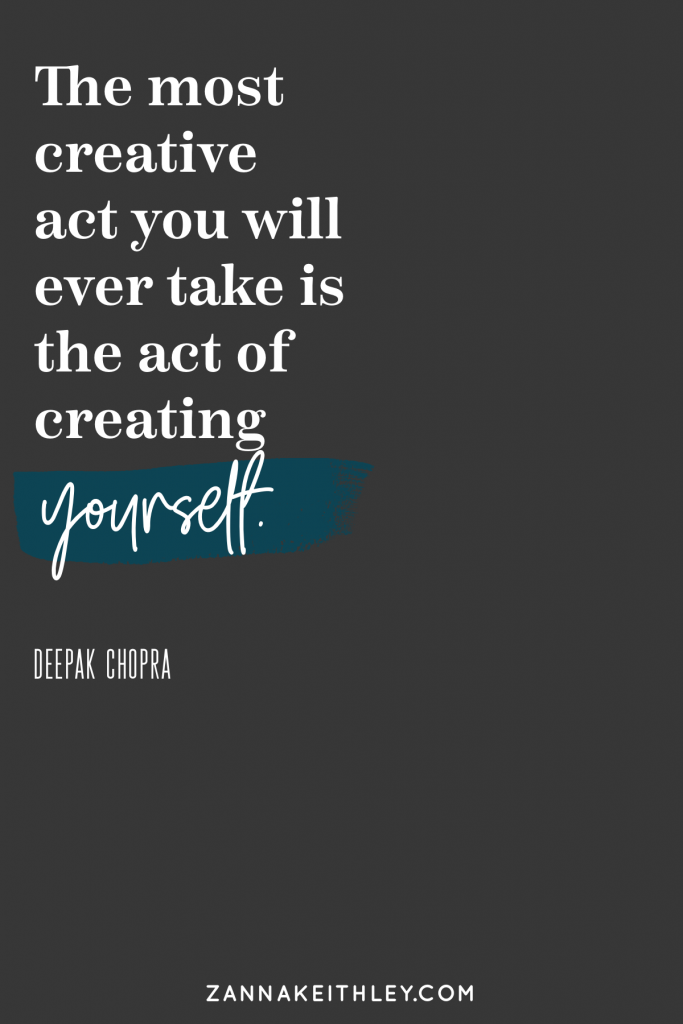
19. “The most creative act you will ever undertake is the act of creating yourself.” 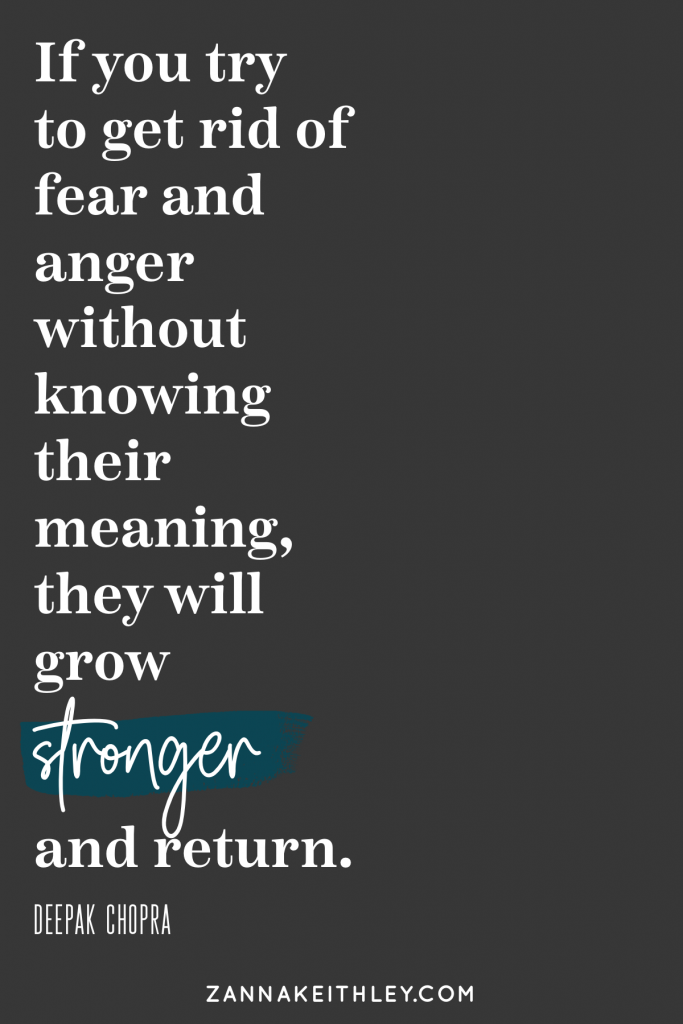
20. “If you try to get rid of fear and anger without knowing their meaning, they will grow stronger and return.” 21. “I teach people that no matter what the situation is, no matter how chaotic, no matter how much drama is around you, you can heal by your presence if you just stay within your centre.”
Deepak Chopra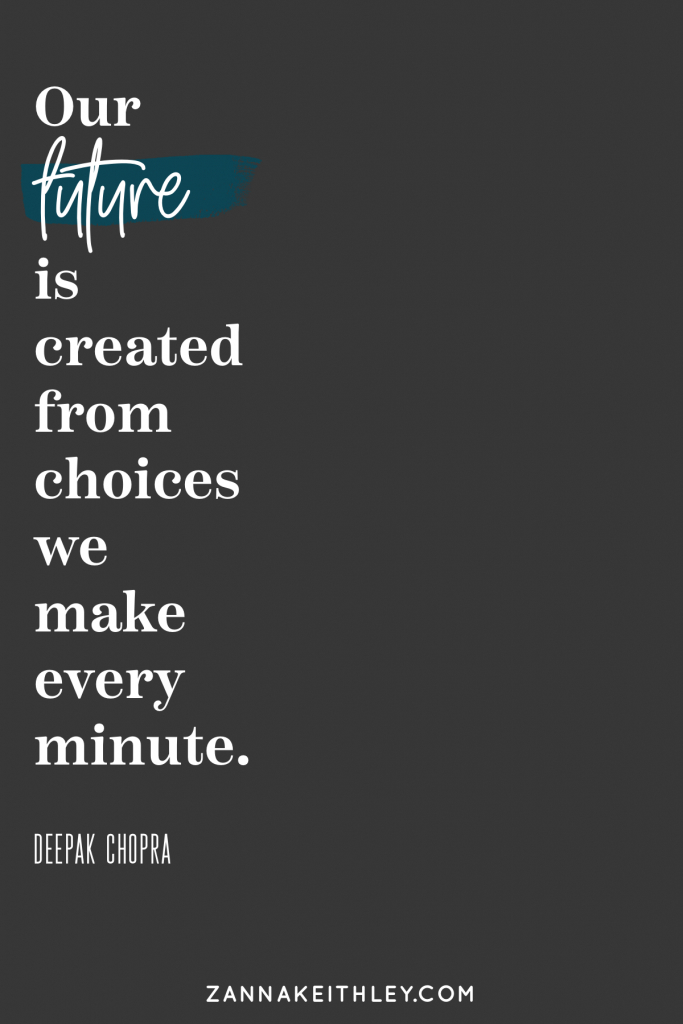
22. “Our future is created from choices we make every minute.” 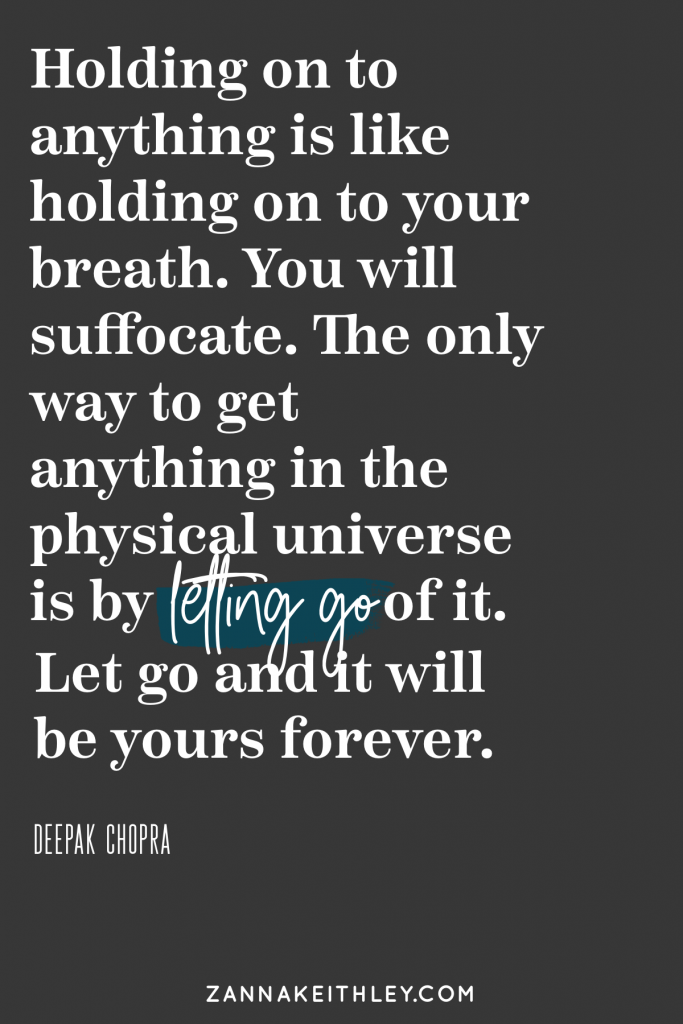
23. “Holding on to anything is like holding on to your breath. You will suffocate. The only way to get anything in the physical universe is by letting go of it. Let go and it will be yours forever.” 24. “To make the right choices in life, you have to get in touch with your soul. To do this, you need to experience solitude, which most people are afraid of, because in the silence you hear the truth and know the solutions.”
Deepak Chopra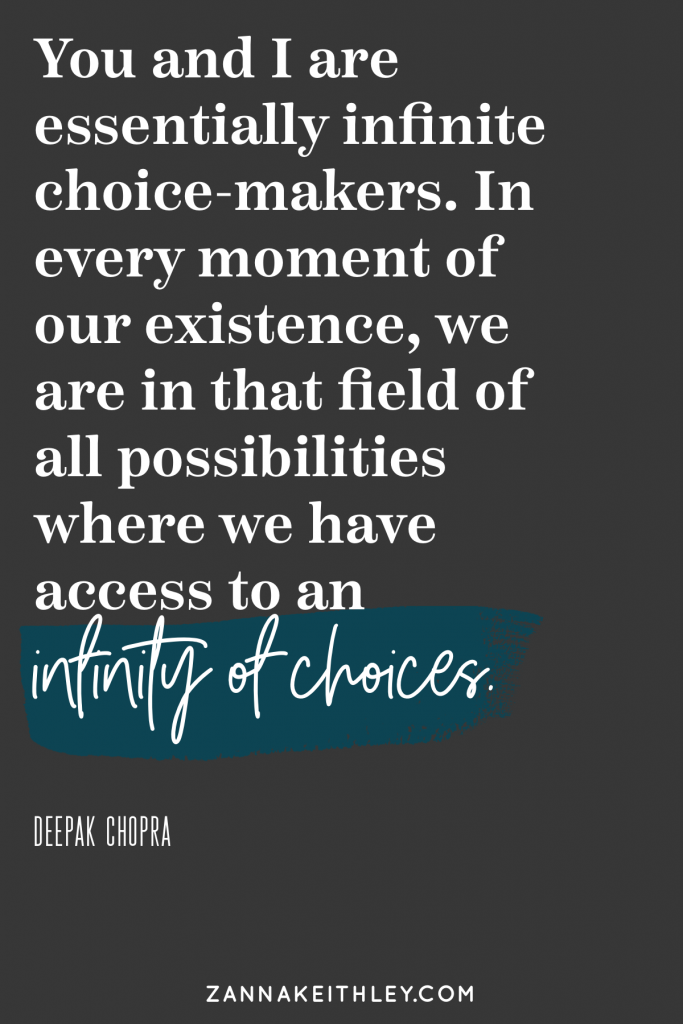
25. “You and I are essentially infinite choice-makers. In every moment of our existence, we are in that field of all possibilities where we have access to an infinity of choices.” 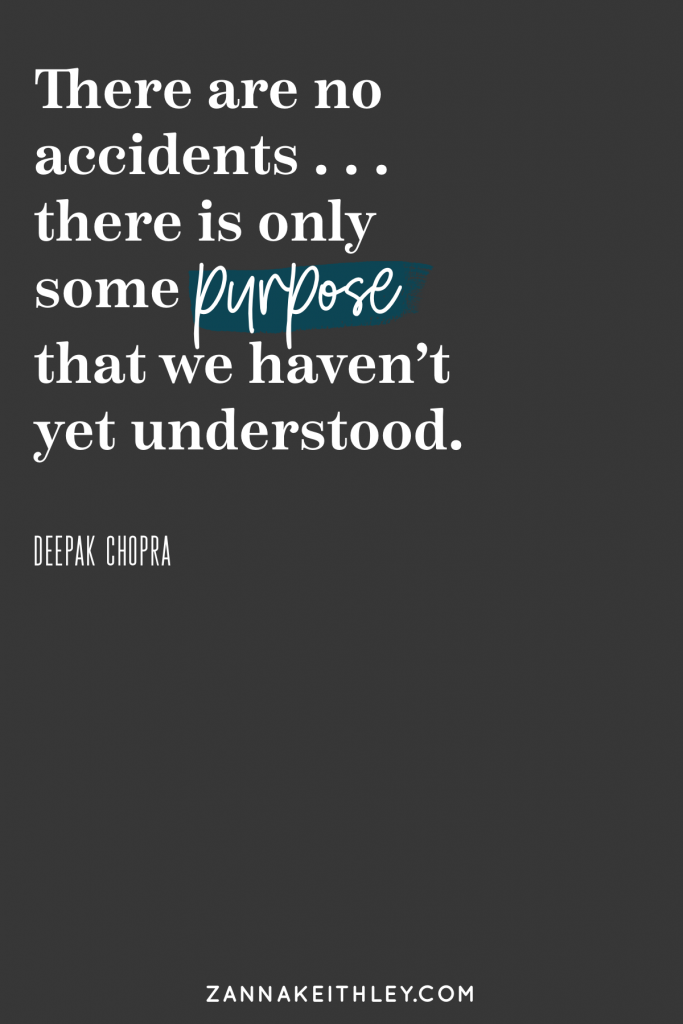
26. “There are no accidents… there is only some purpose that we haven’t yet understood.” 27. “I was very afraid at the beginning, until Master told me that pain isn’t the truth; it’s what you have to get through in order to find the truth.”
Deepak Chopra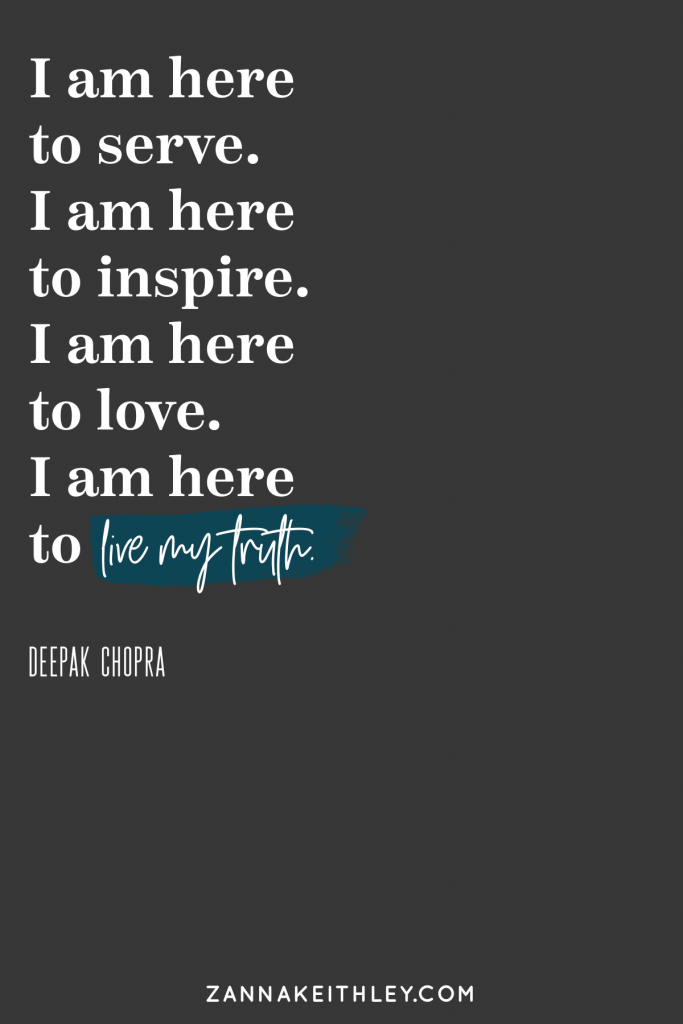
28. “I am here to serve. I am here to inspire. I am here to love. I am here to live my truth.” 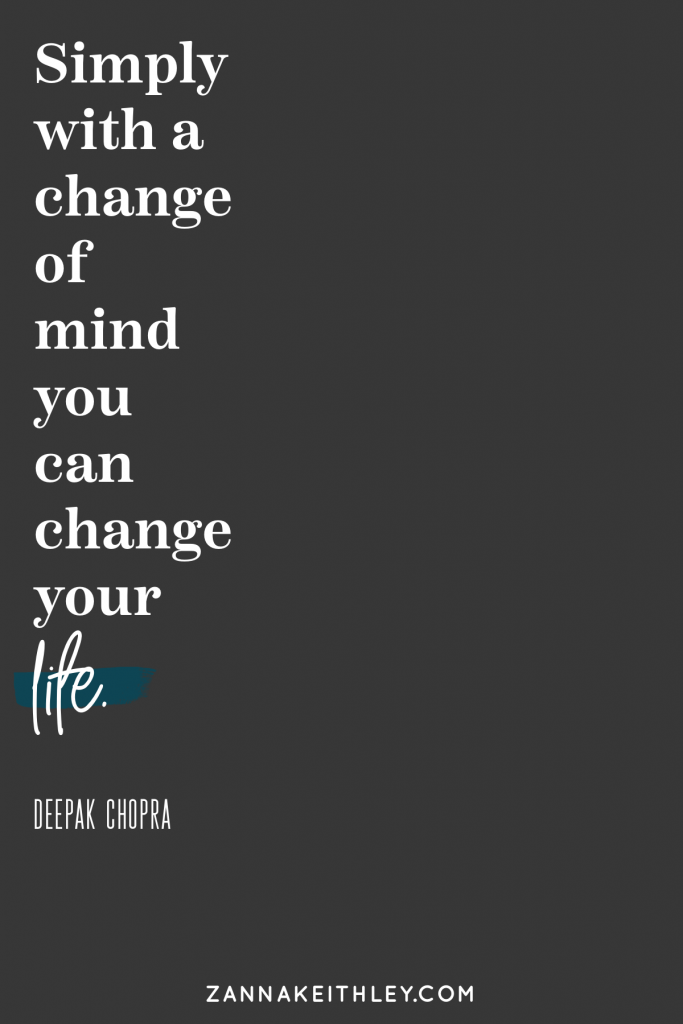
29. “Simply with a change of mind you can change your life.” 30. “You’re a spiritual being having a human experience. You’re not a human being having a spiritual experience.”
Deepak Chopra
Do you have a favorite Deepak Chopra quote that wasn’t on the list? Share it in the comments below! And if you have a favorite writer who inspires you, let me know so I can feature them in a future post!
Discover More Inspiring Quotes
- 10 Inspiring Abraham Hicks Quotes (For Instagram)
- What is Mindfulness? Plus 15 Powerful Mindfulness Quotes
To Learn More About Deepak Chopra

30 Profound Deepak Chopra Quotes 
Zanna Keithley is an author, poet, and social media content creator who writes short prose dedicated to inspiring readers to follow their dreams, trust their intuition, and create beautiful and fulfilling lives. You can find her original writing on Instagram @zannakeithley.
-
35 Positive Night Affirmations to End Your Day
Looking for some positive night affirmations to recite as you end your day? Morning affirmations get all the spotlight, but night affirmations are just as important for your self-care routine! Below, I give you 35 of my favorite night affirmations to help you end your day on a positive note. Plus download your free printable affirmations below!

Pin this for later! 35 Positive Affirmations to End Your Day Updated September 2nd, 2021
Why Use Night Affirmations?
I am 100% guilty of focusing on positive affirmations in the morning and even the afternoon while completely abandoning them at night.
It’s an easy trap to fall into.
For me, I have a morning routine that includes journaling for 30 minutes right when I wake up. And almost always, these journal entries include some high-vibe, uplifting affirmations to help me start the day feeling positive and inspired. My workouts are also done early in the day, which is another time I repeat positive affirmations to myself. And I’m pretty decent at remembering to silently recite affirmations when I’m out and about, or when I get a few seconds to pause during work.
But when it comes to the evening, I’m not the best at reaffirming my worthiness. Or simply reminding myself that everything I did today was enough. And the things I didn’t do? Those things are okay, too.
Because my worthiness is not defined by my achievements.
Recently, I set the intention to be more mindful with repeating nighttime affirmations. When I say this, know that this isn’t for the sake of just mechanically repeating positive words like a robot. The purpose of these affirmations is to be more mindful with my thoughts and the way I speak to myself, while owning my story and telling my own truths (especially when my pesky brain starts to return to bully mode).
Looking for more affirmations? Check out these posts!
- 43 Creativity Affirmations to Inspire Your Limitless Imagination
- 42 Body Positive Affirmations for Total Self-Acceptance
- 50 Positive Affirmations for Entrepreneurs
- 75 Self-Love Affirmations to Celebrate Your Worthiness
- 50 Money Affirmations to Manifest Limitless Abundance
- 50 Positive Affirmations to Remain Calm and Confident During Your Workday
What Are Positive Affirmations?
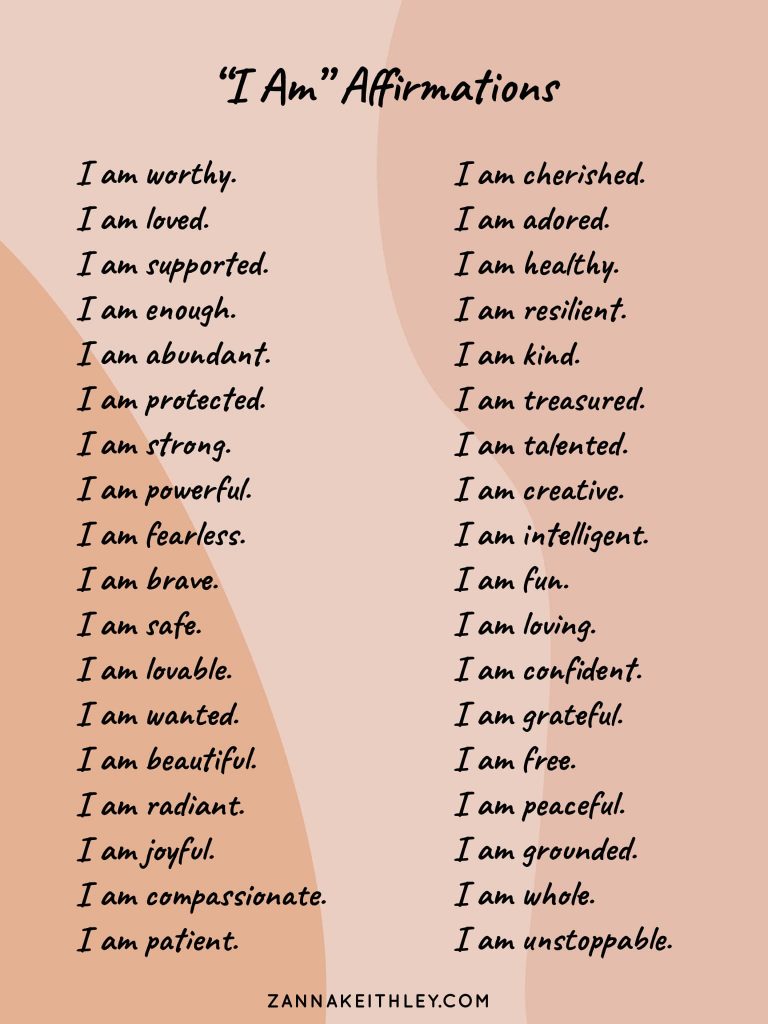
“I Am” Affirmations Positive affirmations are statements (usually made in the present-tense) designed to uplift and encourage while boosting self-belief and supporting your overall wellbeing.
The classic first two words of an uplifting affirmation are, “I am . . .”
However, an affirmation can start with any phrase that fits the context of what you want to affirm.
Here are a couple other common ways you might start an affirmation:
- I can . . .
- I accept . . .
- My (life, heart, body, worthiness) . . .
- I release . . .
- I have . . .
- All is . . .
- Everything is . . .
- I feel . . .
For further insight into affirmations, how to use them, and why they work, check out my post How to Use Affirmations (So They Actually Work).
Positive Affirmations to End Your Day
Below are 35 positive night affirmations to help you ease into the comfort and quiet of nighttime as you settle down for the day. These night affirmations range in their desired effect; some are gentle and calm while others are uplifting and empowering. Feel free to save and share any that resonate with you!
Night Affirmations
- Everything I did today is leading me to a better tomorrow.
- My body is relaxed, and my heart is at peace.
- I offered my very best self today.
- Today wasn’t perfect, but it was beautiful.
- I release any worry or stress I felt today. I know that everything will be okay.
- When I choose to look for them, I can see how so many beautiful things happened for me today.
- I did my best today, and I’m proud of myself.
- I am grateful for every single experience I had today.
- Regardless of what I did or didn’t do today, I know that my worthiness is not defined by my achievements.
- I can see how all experiences I had today brought me either joy or growth.
- I have faith that everything works out for my highest good.
- I’m proud of myself for listening to my inner knowing, even when I felt afraid.
- I feel calm. I feel peaceful. All is really well.
- I surrender to this present moment and release any worries I felt today.
- I’m grateful for all that I learned today.
- I inhale peace. I exhale worry.
- There are so many reasons to be grateful for this day. I choose to focus on my appreciation.
- I feel calm, relaxed, and at peace.
- Instead of wishing I could change the past, I focus on this present moment.
- I release worry and choose to trust.
- A lot happened today, but I choose to live fully in this moment right now.
- I know that good things are always happening for me.
- I have the power to control my thoughts.
- No matter what was left undone today, I know that I am always enough.
- I am enough. I have always been enough. And I will always be enough.
- I am exactly where I’m meant to be.
- Even when things didn’t happen how I wanted, I know I’m on the right path.
- I feel relaxed. I feel whole. This is exactly where I’m meant to be.
- I am grateful for the hardships I experienced today because they allowed me to grow.
- I love myself fully now, just as I am, as I continue to grow.
- Everything is unfolding for me in perfect timing. I release worry and choose to trust.
- I know that tomorrow’s going to be another really beautiful day.
- Everything that happened today is bringing me closer to my dreams.
- My life is really beautiful. I wouldn’t change it for anything.
- I am grateful for every step of this journey and every second of my imperfect, messy, beautiful life.
Bonus – Meditations to End Your Day
As a bonus, here are some of my favorite meditations on the Insight Timer app for ending the day feeling calm, content, and peaceful.
- Liza Colpa’s Manifestation for a Good Night’s Rest and A Meditation for Manifesting a Reset After a Long Day
- Carrie Suwal’s Wash Away Heaviness and Find Peace
- Bethany Auriel-Hagan’s Breathing Into Sleep
What positive affirmations do you use to end your day? And have you found any tips or tricks to help remind you to keep affirming those uplifting words even as the day comes to a close? Feel free to drop a note in the comments below!
And for a daily dose of positive affirmations, be sure to follow me on Pinterest and Instagram!
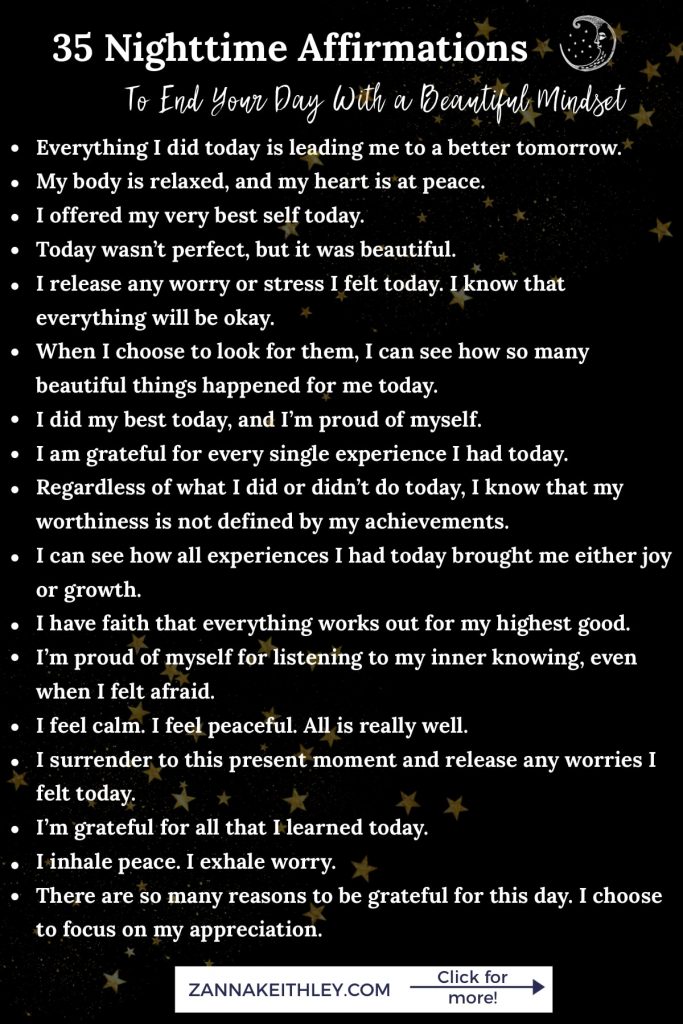
Pin this for later! 35 Positive Affirmations to End Your Day 
Zanna Keithley is an author, poet, and social media content creator who writes short prose dedicated to inspiring readers to follow their dreams, trust their intuition, and create beautiful and fulfilling lives. You can find her original writing on Instagram @zannakeithley.
-
10 Ways to Cultivate Mindfulness Today
As a follow-up to my blog post, What is Mindfulness? Plus 15 Powerful Mindfulness Quotes, I’m giving you 10 effective ways to cultivate mindfulness as you become more conscious of your thoughts and start living in the present moment. The best part? Most of these are simple practices you can start doing at home today.
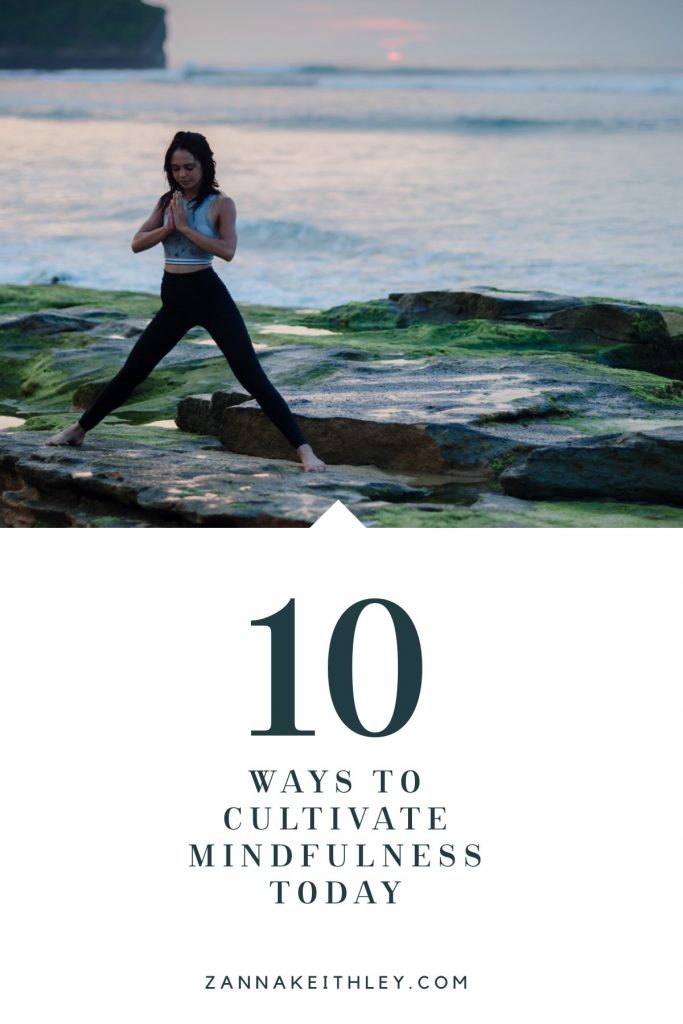
10 Ways to Cultivate Mindfulness Today What is Mindfulness?
In my recent blog post, What is Mindfulness? Plus 15 Powerful Mindfulness Quotes, I gave you my definition of mindfulness, the three components of mindfulness, and a list of powerful quotes from prominent thought leaders on the practice of mindfulness.
To recap, I define mindfulness as non-judgmental, conscious awareness in the present moment.
One of my favorite definitions comes from Jon Kabat-Zinn, the creator of the Stress Reduction Clinic and the Center for Mindfulness in Medicine, Health Care, and Society at the University of Massachusetts Medical School:
“Mindfulness is awareness that arises through paying attention, on purpose, in the present moment, non-judgmentally.”
When we think about mindfulness, it’s likely that the next word that comes to mind is meditation. And while I think meditation has been my most powerful tool in helping me to cultivate mindfulness, you absolutely do not have to meditate in order to live a mindful life.
In fact, anyone can begin a mindfulness practice today, no meditation required. And while you may feel like you’re too busy to start a new mindfulness practice, many of the methods on this list take almost no time at all – just a couple seconds of your conscious thoughts in the present moment.
Below, I’ve written about 10 ways to cultivate mindfulness today. While you definitely don’t have to do all the items on this list, I encourage you to try out as many as possible to see what works for you. To help you out, I listed these in order of practices that take the least amount of time to ones that take the most.
And if you have any questions, don’t forget to post them in the comments below!
Method #1: Phone Notifications/Reminders
The irony isn’t lost on me here. While most of us would say that a little less time on our phones is one of the best ways to cultivate mindfulness, I’m starting out by telling you to spend more time on your phone.
But let me backtrack.
I’m not actually saying to spend more time on your phone; I just think that instead of always focusing on the bad things associated with cell phones, we should focus our attention on the good services they provide.
And one of my favorite ways to use our cell phones for good is to set up positive and uplifting notification reminders that pop up during the day to remind you that you’re doing a great job, that you’re worthy, that you’re capable of doing incredible things – whatever you know you’ll need to hear when you’re in the middle of a chaotic workday.
So how can we use these notifications as a way to cultivate mindfulness?
By setting up reminders to pause in the middle of our day and breathe. These don’t have to be anything dramatic. One of my favorite gentle reminders?
“Breathe.”
Some other reminders you can set up to help you cultivate mindfulness:
- Pause. Breathe. Be.
- Notice your surroundings.
- Pause and look around you. Then, look within.
- Inhale. Exhale.
- Where is your mind right now?
- Where are your thoughts right now?
- Come back to this present moment. Don’t judge. Just be.
At most, these notifications may take a minute or two to set up, but once you have them stored in your phone, you can set them to pop up for you as many times as you want during your day.
Method #2: Post-It Notes
Essentially, post-it notes work in the same way as reminders on your phone, but if you don’t like to look at your phone during the day, this might be a less intrusive method for you. (Or, if you don’t want to choose, do both!)
You can use some of the same reminders I wrote above on your post-its. (Or index cards, scrap pieces of paper, napkins . . . anything you want to write on.) Then, place them in spots you know you’ll see them during the day.
Some suggestions for placement:
- Near your work station
- On your bathroom mirror
- In your wallet
- Near your phone charging station
- Next to the coffee pot
- In your pocket
- Next to the car radio or drink holders
The most important thing with the post-it method is not to get so used to them being there that you ignore them. Set the intention to read the post-its when you see them. Switching out the message weekly and/or using bright colors might help with this.
Method #3: Set Daily Intentions
One way to cultivate mindfulness is to set the intention to practice mindfulness throughout the day. I’m big on having a morning routine (more on that below!), but if you don’t have time for a longer routine, spend just one to two minutes every morning setting a purposeful intention.
Now, this intention doesn’t have to just be, “I will practice mindfulness today.“
To mix it up, you can focus on some of the different components of mindfulness each day.
Here are some examples of daily mindfulness intentions:
- Today, I set the intention to practice non-judgment.
- I will step back from my work once an hour to take three deep breaths.
- Today, I pledge to live in the present moment. When I find my mind wandering to the past or future, I’ll gently bring it back to right now.
- I will observe my internal world with objective awareness.
- I will observe my external world with objective awareness.
Again, the key here is to come back to your intention throughout the day. As you start this practice, phone reminders or post-it notes might benefit you. Or, if you have a whiteboard in or near your work space, you can simply write on it, “Remember your intention.” Let those words bring you back to the present moment.
Method #4: Follow Social Media Accounts that Teach, Discuss, and Encourage Mindfulness
Yes, I know.
Social media is just as bad as phones.
But again, I think we can use social media in this instance for good, not evil.
Do you have Instagram? Twitter? Facebook? Do you find yourself checking your social media once, twice, three times or more a day?
While social media detoxes are good for all of us every once in a while, we don’t have to cancel all of our accounts in order to practice mindfulness.
There are a lot of really amazing people on social media talking about mindfulness every day. These people are using their platform to teach and share their knowledge and experiences.
So let’s let them teach us.
We often open our social media apps on autopilot, not thinking twice about what we’re doing, so a powerful practice is to be mindful every time we open up one of our social media accounts. Notice (with objective awareness . . . no judgment) when you’re clicking that little square on your phone. Are you bored? Sad? Avoiding bad or negative feelings? Again, don’t judge yourself here. Just notice.
Then, when you have that account open, add accounts to your feed that talk about mindfulness. This doesn’t mean you have to unfollow your friends or favorite celebrities. Just find a few accounts that speak to you (you can search the hashtag #mindfulness and go through some of the popular pins to get started), and follow them. Every time you open your app, make sure you read through their images and captions.*
I know this one might sound silly or stupid to some, but I think there’s power in seeing examples, thoughts, ideas, and definitions about mindfulness every day.
My Mini-Disclaimer
*To be clear, I very much believe in listening to what other people have to say about a subject and then forming your own opinions and truth. If you follow a mindfulness blogger who says something that doesn’t feel right to you, question it. You don’t have to blindly accept anything that anybody (including me) tells you, especially if it doesn’t feel right.
Method #5: Breathing Exercises
Not sure if you want to start a meditation practice? Or you already do meditate, but you want to enhance your practice? Breathing exercises are a perfect tool to increase mindfulness, and the best part is you can do them anytime and anywhere.
While there are many variations of breathing exercises, your practice can be simple and straightforward.
For example, breathing from your belly, inhale for four seconds. Hold your breath at the top for another four seconds. Then exhale for four seconds. If you’re comfortable, you can try a variation of this, where you inhale for four seconds, hold your breath at the top for seven seconds, then exhale for eight seconds. You can breathe through your nose or mouth, whatever is most comfortable for you.
Even if all you can do is take a couple seconds for a few slow, conscious inhales and exhales, that’s okay.
The key to using breathing exercises to cultivate mindfulness is to focus on your breathing, grounding yourself in this present moment. And when we are continually able to return to the present moment, we allow mindfulness into our experience.
Method #6: Lean Into Frustrating Moments
This one is tough, but if you stick with it, it can be the most worthwhile.
It’s likely that nearly every day, you encounter experiences that cause you to feel annoyed, frustrated, and maybe even a little angry. Your heart rate increases. You feel a tightness in your chest. Or maybe it feels more like heat pulsating through your veins. Whatever it is, it’s uncomfortable and you don’t like it very much.
To cultivate mindfulness, don’t suppress or pretend these moments don’t exist.
Instead, lean in.
I’m not saying, “Let yourself get so angry and upset that the negative energy overcomes your entire body.”
What I’m saying is this: get curious.
To start, set an intention to recognize your moments of discomfort and/or frustration throughout the day. If you already know that your morning commute is going to make you want to smack your head against the steering wheel, decide to approach the commute a little differently today.
Now, you’re stuck in traffic. The cars aren’t moving. Or maybe someone cut you off. To be clear, you definitely don’t have to like these moments. Allow yourself to feel whatever emotions are rising within you.
And then, simply notice.
Now get curious. Ask yourself questions: Why am I frustrated right now? Why does this experience cause me to feel this way? What do I see in my surroundings right now? What would I change if I could?
Become an objective observe of yourself. That means no judgment. Just notice, probe, observe. Let yourself stay grounded in this present moment.
Now, see if you can do the same thing tomorrow. And the day after that. And then see if you might be able to have this same mindset when an unexpected frustration pops up during your day.
It won’t happen overnight, but if you do this consistently day after day, with time, you’ll see a shift in your mindset and how you view your present experience.
Method #7: Get Outdoors
I can’t quantify how much time this will take during your day. It may take seconds. Maybe minutes. Maybe an hour or more. But if you can make time for 15 minutes to go outside, you’ll experience huge benefits to your mindfulness.
Let’s say you have a 15-minute break during work, and you choose to step outside and take a walk during that time. Or maybe you decide to take a short walk outdoors after dinner. Whenever you can fit in this time, set the intention to stay in the present moment as you walk.
Now, as you’re walking, notice your surroundings. Take note of what you see and hear. How does the air feel on your skin? What sensations do you feel in your body? Is there tension in your muscles? Tightness in your chest? How do your feet feel in your shoes, walking against the ground?
Whatever your answers are, don’t judge. There is no right or wrong, no good or bad. And when you realize your mind has drifted away from the present moment, gently bring it back to right now.
The goal here isn’t to keep your mind from drifting.
The goal is to notice when your mind has strayed and to gently return it back to the present, over and over again.
If walking isn’t your thing, you can also perform this mindfulness exercise when gardening, mowing the lawn, or raking leaves. If the weather permits, you might also choose to do it while stretching outside.
And finally, whatever you decide to do, remember to breathe. Anytime your mind strays, remember that you can always return to the breath.
Method #8: Establish a Morning Routine
Depending on your available time, these last three practices can take anywhere from five minutes to an hour. (And you might also be able to combine them with other practices on this list.)
I’m a big proponent of having a morning routine that isn’t just about hurrying to rush out the door. Personally, I like to journal for 30 minutes first thing after I wake up. I do this when the house is quiet and it’s still dark outside. For me, this is my time to write, create, reflect, and uncover my own feelings, ideas, and thoughts. I also usually work out in the morning, either by running, HIIT exercises, yoga, or light stretching on recovery days.
So how exactly does any of this cultivate mindfulness?
A couple ways.
For one, you might choose to add specific mindfulness practices to your morning routine. You might choose mindful journaling, which entails writing about your thoughts, surroundings, and present experience with objective awareness. You can also add other practices on this list, like daily intention setting and breathwork.
I believe there’s also something powerful about having an intentional and conscious morning routine, no matter what it entails. It means that instead of just unconsciously going through the motions, you’re choosing how you greet the day. And when you start the day by consciously choosing your experiences, you’re more likely to continue this practice throughout the day.
Morning Routine Template
Below is the morning routine template I created for my post, How to Design a Morning Routine for Manifestation. If you don’t have time for journaling, utilizing a template such as this one is a powerful way to set your intentions for the day.
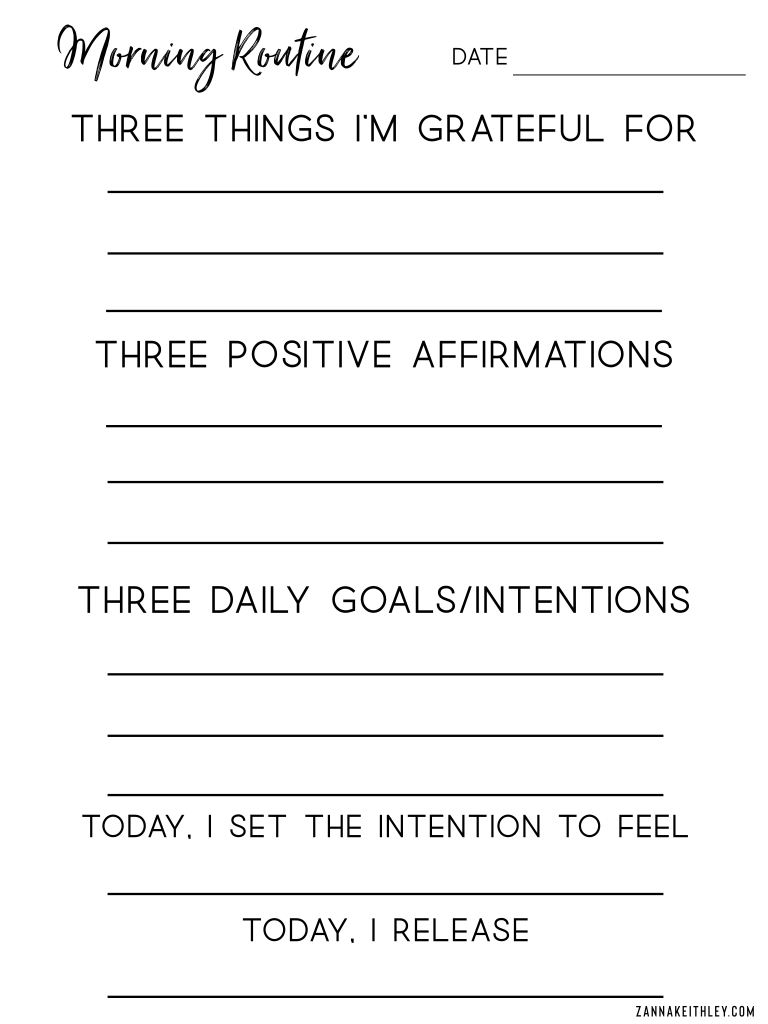
Morning Routine Template Possible Components of Your Morning Routine
- Journaling
- Meditation
- Yoga
- Intention Setting
- Daily Affirmations
- Breathwork
- Reading
- Exercise
- Morning Walk
- Gratitude Practice
Method #9: Meditation
If you’re looking to start a mindfulness practice, it’s hard to find anything that will serve you better than meditation.
First, let’s dig into some myths about meditation.
Meditation is not “clearing your mind of all thoughts.”
And “not thinking” is not the goal of meditation.
Rather, in meditation – mindfulness meditation, specifically – one simply breathes in the present moment, notices when they have a thought with objective awareness, and gently releases it, returning to the present moment.
For instance, imagine you’re laying on the ground looking up at a perfectly blue sky, and a cloud passes above you. “Look, there’s a cloud,” you think. Then it floats out of your vision, and you let it go without attachment.
These clouds are your thoughts. Notice. Release. Come back to the present, over and over again.
If you’ve never meditated before, starting a meditation practice may seem overwhelming at first. To help, I’ve created 7 Meditation Practices for Beginners, which gives you suggestions for how to start as well as links to guided meditations using the Insight Timer app. (No affiliation.)
Just know that even if someone on a podcast says they meditate for two hours a day, or an Instagram influencer swears by meditating for twenty minutes twice a day, you don’t have to start big. When I started meditating, I pledged just ten minutes a day. Sometimes, five. And even now, I often meditate for no more than ten to fifteen minutes.
You can definitely cultivate mindfulness without meditation. The walking exercise I described in the “Get Outdoors” section is a great way to start. But I believe meditation has been my greatest teacher in cultivating mindfulness. If you’re open to it, pledge to meditate for ten minutes a day, ten days in a row. Start small, then see how you feel after that.
Method #10: Yoga
Yoga is another powerful practice that may take ten minutes, an hour, or somewhere in-between. If you’ve never tried yoga before, this one might be even more intimidating than meditation. So let’s make it a little less intimidating by talking about why yoga cultivates mindfulness and how to gently step into a new yoga practice.
First, like we did with meditation, let’s debunk a myth about yoga:
Yoga isn’t about getting into a pose and holding it as long as possible until you can no longer stand the pain.
The beauty of yoga (in my experience, at least) is in the flow: the gentle awareness of the energy flowing through my body. Yoga is when my mind and body become one, and I simply exist in this present moment. The greatest lesson I’ve learned from yoga isn’t to become more flexible; it’s to become one with my breath.
Yoga cultivates mindfulness because it allows us to be in this present moment, at one with our breath, simply noticing the sensations and feelings in our body with non-judgmental awareness.
If starting a yoga practice seems intimidating, YouTube might become your new best friend. There are thousands of videos online dedicated to beginner’s yoga. If you’re not sure where to start, I highly recommend Yoga With Adriene’s Foundations of Yoga series. This series is comprised of 45 separate five to twenty-five minute videos, each dedicated to helping you explore a different yoga pose. I love these because you can take your time with each pose and go at your own pace.
If you want to learn a little more about yoga and mindfulness, here and here are a couple articles that dive a little deeper into the connection between your body and your mind.
And there you have it: ten ways to cultivate mindfulness today. Remember that you don’t have to include all ten practices into your life today. Start small. Choose a few that feel right to you. And if one of those methods doesn’t click, choose again. And remember that every moment in our lives provides us with an opportunity to practice mindfulness. Even right now. Notice the thoughts, sounds, sensations, and feeling of the present moment. No judgments. Just observe.
Other Posts You Might Like
- 10 Science-Backed Health Benefits of Meditation
- A Beginner’s Guide to Understanding and Unblocking Your Chakras
- 25 Epic Morning Affirmations to Create a Beautiful Day

10 Ways to Cultivate Mindfulness Today 
Zanna Keithley is an author, poet, and social media content creator who writes short prose dedicated to inspiring readers to follow their dreams, trust their intuition, and create beautiful and fulfilling lives. You can find her original writing on Instagram @zannakeithley.
-
What is Mindfulness? Plus 15 Powerful Quotes
In this post, I’ll go in-depth on the three components of mindfulness, plus provide you with 15 life-changing quotes about mindfulness that will change the way you think. Be sure to check up my follow-up post, 10 Ways to Cultivate Mindfulness Today, where I provide you with ten simple and effective practices you can do today to cultivate a more mindful life.
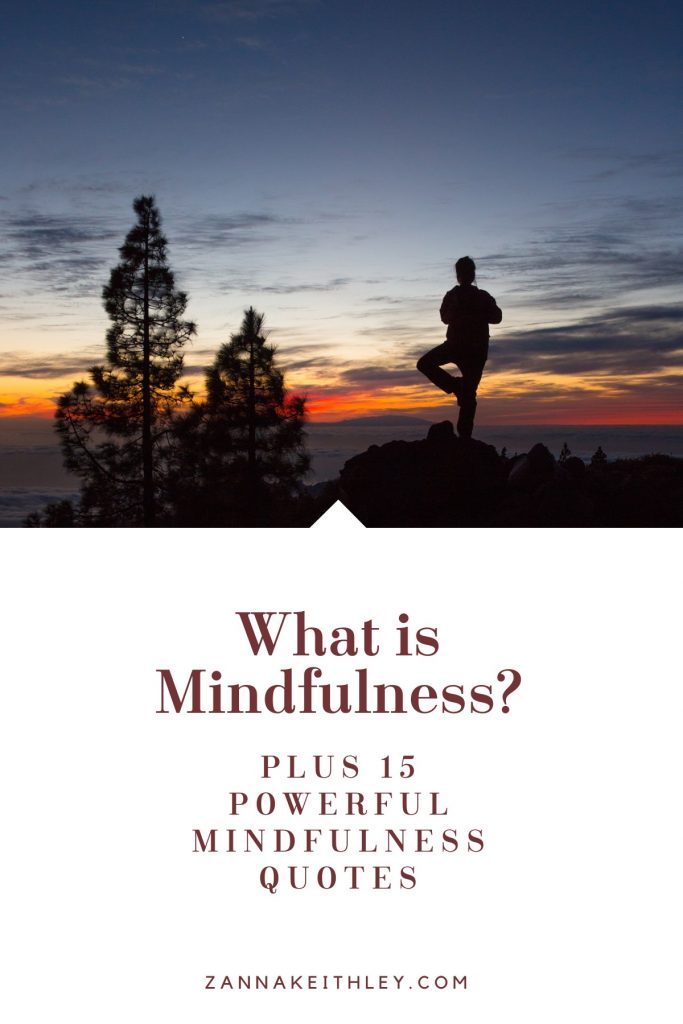
What is Mindfulness? Plus 15 Powerful Quotes Mindfulness
This word has been gaining recognition and popularity over the past several years (for good reason), becoming more than just a concept reserved only for experienced meditators and skillful yogis. From mindfulness coaches to mindfulness bloggers (*raises hand*), we see reminders to be mindful all over social media, blogs, and news sites.
But what exactly does this mean?
I’ll be the first to admit that when I first heard the term mindfulness, I had no idea what it was actually referring to. From what I knew of the word mindful, I had some guesses: it probably had something to do with awareness and maybe having respect for yourself and others, such as to be mindful of your words or to stay mindful of somebody’s personal space. That didn’t seem too difficult. From that fuzzy and uncertain definition, I was pretty sure I already had a solid foundation in mindfulness already built up for myself.
Spoiler alert: I was wrong.
I’m not sure I ever actually sought out an actual definition of mindfulness. Rather, the practice found me, and as I opened myself up and made space for it in my life, more resources and guidance came to me to help me in my journey.
While meditation has been my greatest teacher in helping me discover mindfulness, you absolutely do not have to meditate to cultivate mindfulness. We begin cultivating mindfulness the moment we return our awareness to this present moment (and when our minds inevitably stray, gently bringing it back to the now, over and over again).
In this post, I’ll break down what mindfulness really means, including its three core components, as well as give you fifteen powerful quotes from past and present thinkers and visionaries on what mindfulness is, what it does, and why it’s important.
What Is Mindfulness?
This morning, as I was applying my makeup, I noticed that I chose the exact same eyeshadow from my eyeshadow palette that I’ve been unconsciously choosing for probably a week straight. I pointed my brush right at the little rectangle and dipped it into the neutral, beige-ish powder without even thinking about it, probably just as I had yesterday and the day before. Today, though, I paused for a second. Then I looked at the other colors on the palette. I recognized what I was doing, made the conscious decision to keep using that same eyeshadow again, and then applied my eyeshadow.
As small and seemingly inconsequential as this moment was, this is an example of mindfulness.
We all have unconscious behaviors we engage in every single day. And that’s okay! We don’t need to fight or avoid these unconscious behaviors. To be honest, it’s kind of nice to go on autopilot every once in a while and perform actions that don’t take tons of thought.
Mindfulness is, in many ways, the art of noticing. In my example, choosing the same eyeshadow color I’ve been picking for the past week was an act of simply noticing. I was able to pause in the middle of my unconscious act and simply observe myself.
Going Beyond Just Noticing
Now, if we deepen our definition of mindfulness, we see it as a little more than just noticing: it’s non-judgmental awareness in the present moment.
Here are two reactions I could’ve had when I noticed that I picked the same eyeshadow color for the umpteenth time:
- “Good God, Zanna, what is wrong with you? You should’ve been paying better attention. You’re not mindful. You’re just going through the motions again!”
- “Huh. That’s interesting.”
Mindfulness does not mean you notice and then berate, bully, and judge yourself for your thoughts and actions.
Mindfulness means you notice and observe without any judgment.
(But if you realize that you are judging yourself, that’s okay. This is my absolutely favorite thing about mindfulness: we can stray as many times as we want and always come home to ourselves. So if I had chosen that first reaction above, I could’ve observed my own judgment and then thought, “Huh. Okay. I’m judging myself. That doesn’t align with who I am. I think I’ll choose again.” The important thing is not to let this become a domino effect. If you notice yourself judging, try not to judge yourself for judging. Instead, choose again. Choose differently. Be gentle with yourself. Just the act of recognizing and choosing again is going to be of far greater service to you in your journey than being a perfect mindfulness student all of the time.)
Defining Mindfulness
My favorite descriptor for our individual roles in a mindfulness practice is to be an objective observer. This means I have the power to step outside of myself in the present moment and notice my thoughts and actions without judgment or criticism. And when I see that my thoughts are returning to stories of the past or future, I can gently guide myself back to this moment right now. And I can do that again and again and again, as many times as I need.
So here’s my personal definition of mindfulness:
Mindfulness is non-judgmental, conscious awareness in the present moment.
And to be mindful is to be an objective observer of oneself.
And that’s it. Of course, we can continue to dive deeper as we explore and discuss mindfulness, but for a definition, it’s truly that simple.
The 3 Components of Mindfulness
So from my definition above, we can break down the concept of mindfulness into three components:
- Conscious Awareness: To recognize your thoughts, words, and actions as you’re thinking, speaking, and acting. This is the opposite of the “autopilot” mode we all fall into once in a while. Conscious awareness is taking a step back, recognizing the autopilot mode, and choosing how you think and feel in this moment.
- Lack of Judgment: Autopilot mode is normal. So is letting our minds wander to the past or future. So is anger, fear, sadness, pain, anxiety, worry, boredom, and all kinds of emotions that we label as good or bad. The key to mindfulness is to not judge ourselves for our thoughts and emotions. Simply notice. Observe. Choose again.
- Returning to the Present Moment: I think about the past a lot. I also think about the future a lot. And that’s okay. I can also recognize that the only real thing in the world is this moment right now. We can think about the past and future, but don’t live there. Live in this moment. That’s what mindfulness does for us; it allows us to honor and recognize the beauty, value, and importance of this moment right now.
15 Powerful Quotes
“Mindfulness is simply being aware of what is happening right now without wishing it were different; enjoying the pleasant without holding on when it changes (which it will); being with the unpleasant without fearing it will always be this way (which it won’t).” – James Baraz
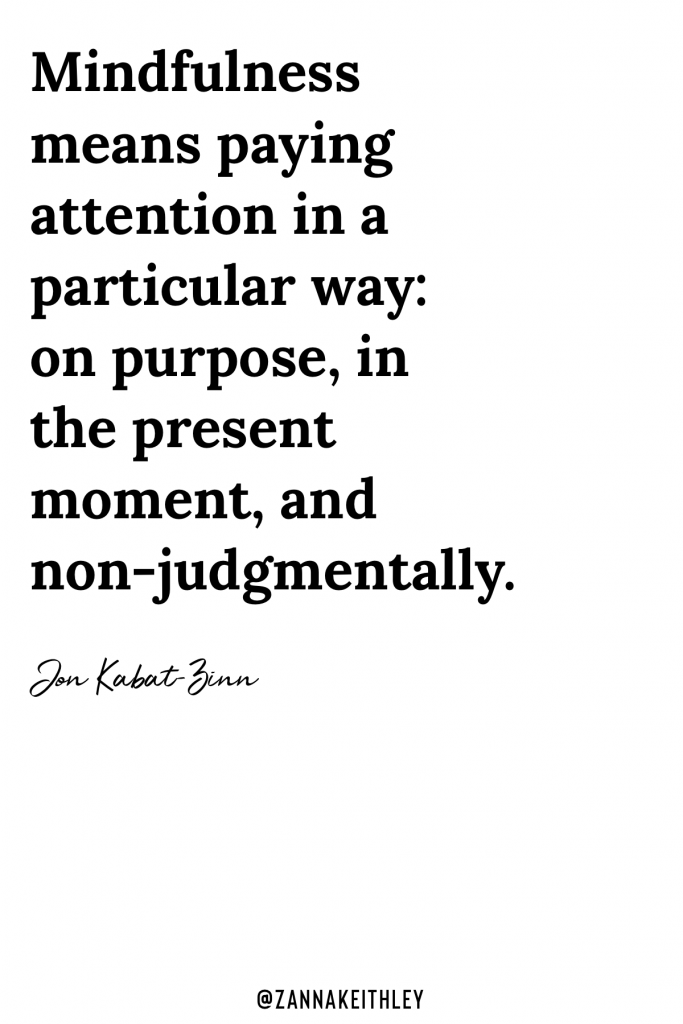
Jon Kabat-Zinn Mindfulness Quote “What would if be like if I could accept life – accept this moment- exactly as it is?” – Tara Brach
“That’s life: starting over, one breath at a time.” – Sharon Salzberg
“If you want to conquer the anxiety of life, live in the moment, live in the breath.” – Amit Ray
“Wherever you are, be there totally.” – Eckhart Tolle
“Feelings come and go like clouds in a windy sky. Conscious breathing is my anchor.” – Thích Nhất Hạnh
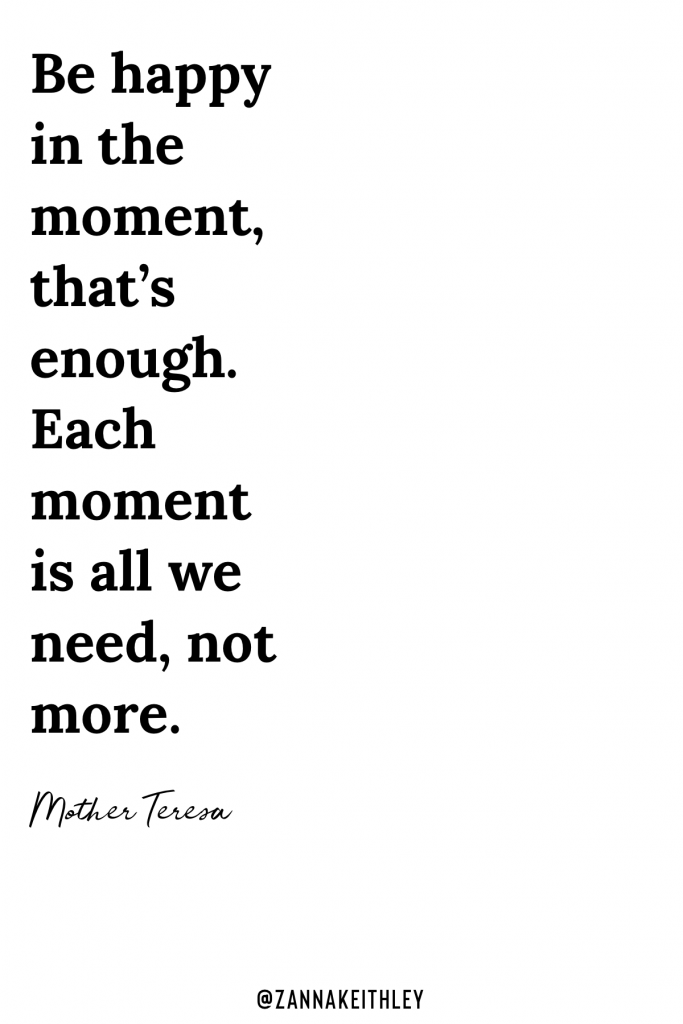
Mother Teresa Mindfulness Quote “Mindfulness is the aware, balanced acceptance of the present experience. It isn’t more complicated than that. It is opening to or receiving the present moment, pleasant or unpleasant, just as it is, without either clinging to it or rejecting it.” – Sylvia Boorstein
“Pure awareness transcends thinking. It allows you to step outside the chattering negative self-talk and your reactive impulses and emotions. It allows you to look at the world once again with open eyes. And when you do so, a sense of wonder and quiet contentment begins to reappear in your life.” – Mark Williams
“We spend a lot of time judging ourselves harshly for feelings that we had no role in summoning. The only thing you can control is how you handle it.” – Dan Harris
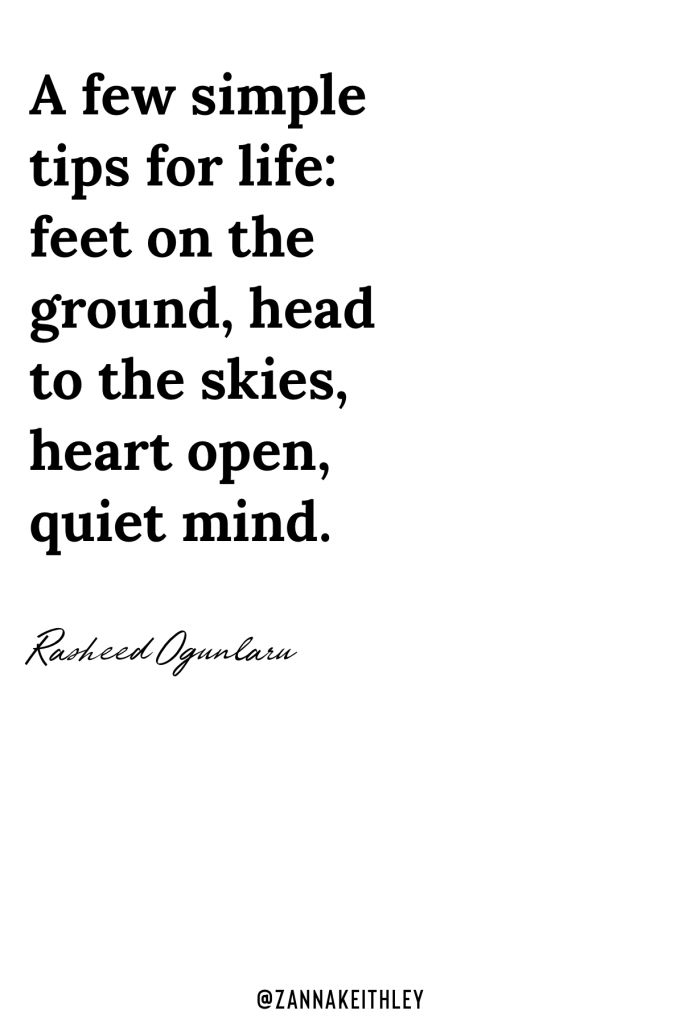
Rasheed Ogunlaru Mindfulness Quote “Whatever state I am in, I see it as a state of mind to be accepted as it is.” – Nisargadatta Maharaj
“Learn to slow down. Get lost intentionally. Observe how you judge both yourself and those around you.” – Tim Ferriss
“Don’t believe everything you think. Thoughts are just that – thoughts.”- Allan Lokos
Want to Learn More About Mindfulness?
Check out these awesome resources!
- mindful.org
- UMass Memorial Health Care Center for Mindfulness
- Awakening Joy
- Short animated video by Happify: Why Mindfulness is a Superpower
If you’re thinking about starting a meditation routine but aren’t sure where to begin, be sure to check out my post, 7 Types of Meditation Practices for Beginners. And if you have any questions about mindfulness or meditation, leave a comment below or connect on social media! I’d love to hear from you!

What is Mindfulness? Plus 15 Powerful Mindfulness Quotes 
Zanna Keithley is an author, poet, and social media content creator who writes short prose dedicated to inspiring readers to follow their dreams, trust their intuition, and create beautiful and fulfilling lives. You can find her original writing on Instagram @zannakeithley.
-
Chakras for Beginners: Unblock Your Chakras Today
Looking for a guide to understanding chakras for beginners? I’ve got you covered with all the essential details you need to know to start understanding, activating, balancing, and unblocking your body’s important energy centers today.
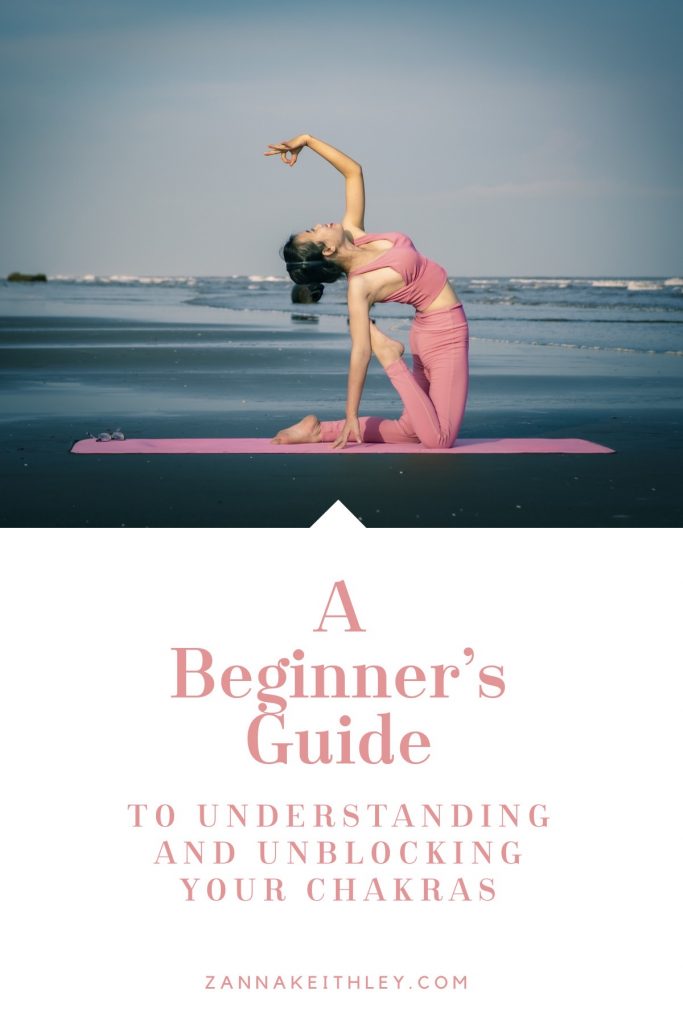
Chakras for Beginners: Unblock Your Chakras Today Discover More About Chakras
Chakras
If you’ve recently started a new meditation or yoga practice, you’ve likely heard the term chakras used by teachers, speakers, and guides. I still remember when I began listening to guided meditations and hearing terms like third eye chakra and crown chakra being used for the first time.
As a meditation beginner, I had a vague, fuzzy idea of what these words meant, but I wasn’t entirely sure on the specifics.
Depending on the teacher’s wording, I wasn’t always sure if my third eye chakra was between my eyes or higher up on my forehead, or if the crown chakra was actually on my head or above my head.
Each chakra has its own intricacies that you’ll want to understand, but before diving into the complexities of the individual chakras, it’s helpful to start with a solid foundation of the basics.
In this post, I provide you with a guide to understanding chakras for beginners. This guide contains a discussion of the seven main chakras and their roles as well as their colors, locations, and other significant details about each energy center.
I also provide you with affirmations related to each chakra, methods to balance and unblock your chakras, and links to some great meditations to help you activate your energy centers.
Chakras for Beginners: Overview
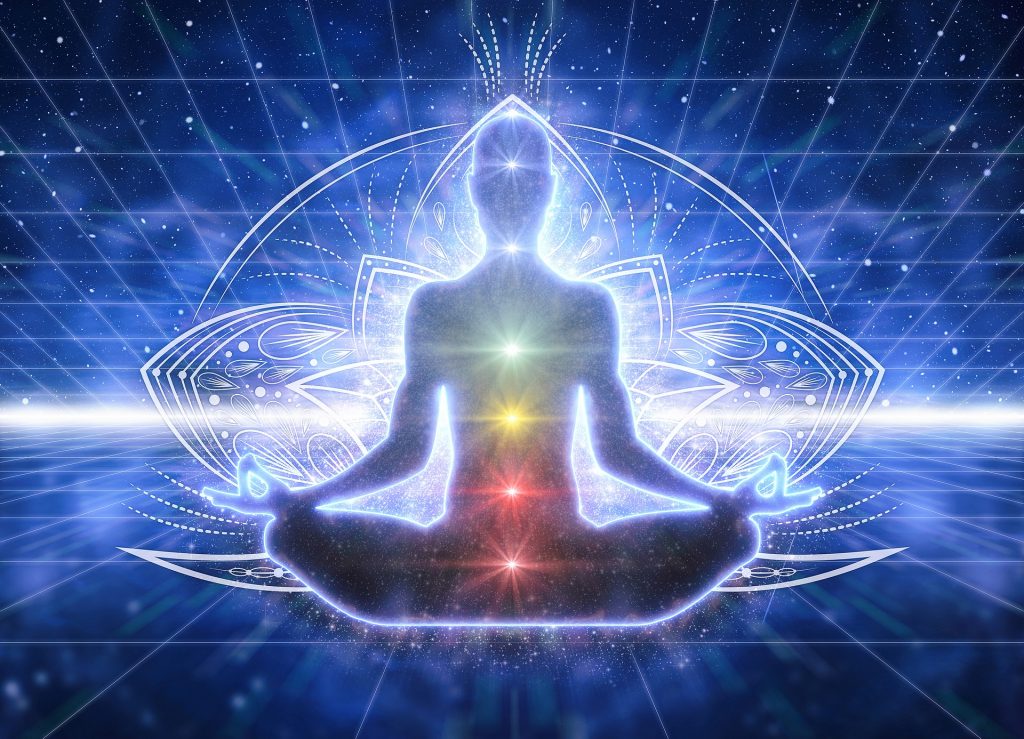
As I mentioned in the intro, there are seven main chakras. Each chakra has its name as well as its Sanskrit name, a specific location in the body, an associated color and symbol, and distinct roles and attributes. (Note that when I say they have specific locations in the body, a chakra is not a physical, tangible thing. Rather, it’s an energy center in the body. More on that in a minute!)
But this isn’t all. Going even deeper, you find that each chakra also has associated foods, gemstones, mantras, body parts, animals, and even essential oils.
But before we get into the details, let’s start with the most fundamental question: what exactly is a chakra?
The word chakra is a Sanskrit word meaning wheel or disk. So when we define what a chakra is, we often go back to this translation: a chakra is a wheel of energy in your body.
Think of it like a vortex of energy within you:


While chakras are often depicted in images as bright, colored light, we can’t actually see these energy centers in our body. Rather, we experience them through feelings and sensations. You might also call it an inner knowing or intuition.
Understanding Chakras: The Flow of Energy
Energy is meant to flow, and ideally, this energy (or prana) is always flowing within you. When our chakras are open, energy is flowing and we feel in alignment with our highest selves.
But when a chakra is blocked, the energy stagnates, and we become misaligned. Often, this manifests in physical, emotional, mental, and/or spiritual blockages. If one chakra is blocked, we may also overcompensate by causing another chakra to become overactive.
For instance, if your root chakra is blocked (your root chakra is associated with helping you feel grounded, steady, and stable), then your solar plexus chakra might become overactive (which could cause you to cling to perfectionistic tendencies and/or a desire for control).
There are seven main chakras that each have their own distinct roles, but it’s important to remember that they act as one whole system. It might help you to think of it like the physical organs inside your body. Even though each organ has a specific role and function, they all work together to keep you in optimum health and alignment. When one organ isn’t functioning correctly, this often negatively affects other parts of your body.
This is the same with chakras: when one chakra is blocked, this affects the energy flowing through our other chakra points.
The 7 Main Chakras & Their Roles
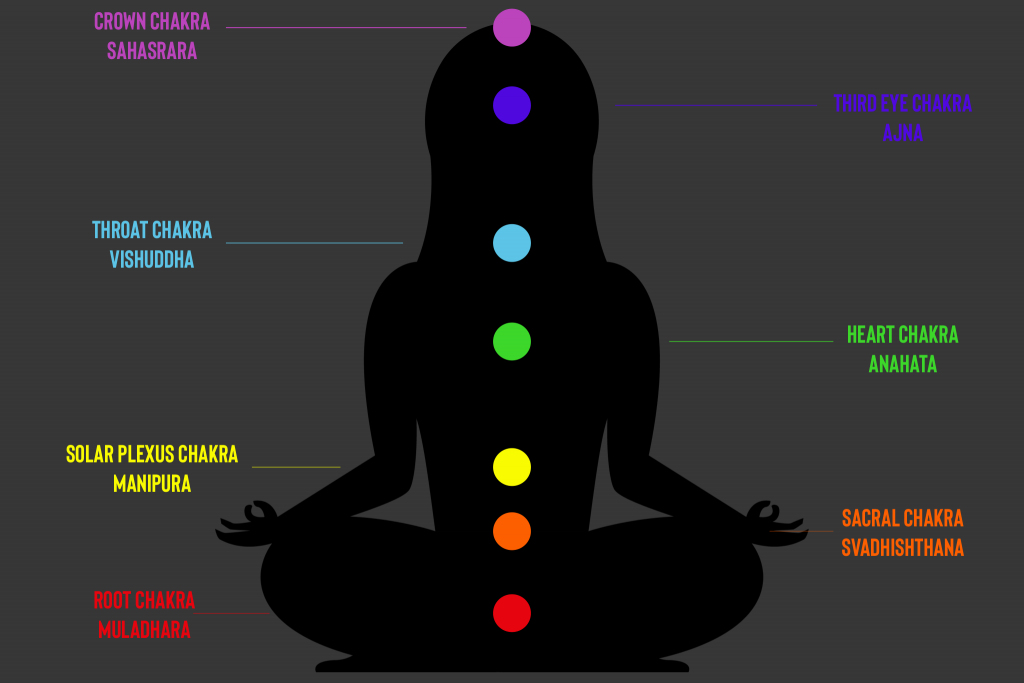
Below is a guide to the seven main chakras and their distinct roles and attributes. You’ll notice that I start with the root chakra and work up through the spine, ending at the crown chakra. If you hear someone refer to first chakra, second chakra, third chakra, and so on, they usually are referring to the root chakra as the first chakra, the sacral chakra as the second, continuing to move upward.
The details below will provide you with a helpful baseline to better understand each chakra as you discover where your energy centers are located and how they function.
Root Chakra
- Sanskrit Name: Muladhara
- Location: Base of the spine
- Color: Red
- Balanced Attributes: Grounded, safe, secure, stable, centered. Like the roots of a tree, this is your foundation. You’re firm in your place in life, and your basic needs are being met.
- Imbalanced Attributes: Anxious, insecure, fearful, excessive negativity, depressed. Energies feel scattered and disorderly. Disconnected and restless.
- Mantra/Sound: LAM
- Gemstones: Onyx, smoky quartz, bloodstone, hematite, obsidian
- Affirmations: I am grounded, centered, and stable. I am rooted and secure. All is really well. I have everything I need. I feel safe in my body.
Sacral Chakra
- Sanskrit Name: Svadhishthana
- Location: Lower abdomen
- Color: Orange
- Balanced Attributes: Creative, joyful, prosperous, sexual, sensual, passionate, energetic.
- Imbalanced Attributes: Withdrawn, tense, insecure, needy, irritable, controlling, manipulative.
- Mantra/Sound: VAM
- Gemstones: Orange calcite, jasper, carnelian, red tiger’s eye
- Affirmations: I am open to the flow of creativity. I am creative, passionate, and inspired. My emotions flow freely in a balanced and healthy way. I live a creative, passionate, healthy life. I deeply respect and honor my sacred body, and I honor my own divine sensuality.
Solar Plexus Chakra
- Sanskrit Name: Manipura
- Location: Stomach/below the chest
- Color: Yellow
- Balanced Attributes: Confident, positive, high sense of self-respect and self-esteem, joyful. This is your source of personal power; you have drive, a positive self image, and feel aligned with your purpose.
- Imbalanced Attributes: Low self-esteem, lack of ambition, lack of purpose, fear of rejection, sensitive to criticism, low energy. If overactive, can also become manipulative, domineering, power-hungry.
- Mantra/Sound: RAM
- Gemstones: Citrine, topaz, yellow tiger’s eye
- Affirmations: I am powerful, strong, and confident. I can achieve anything I set my mind to. Today, I confidently welcome new experiences. I am competent, capable, and strong.
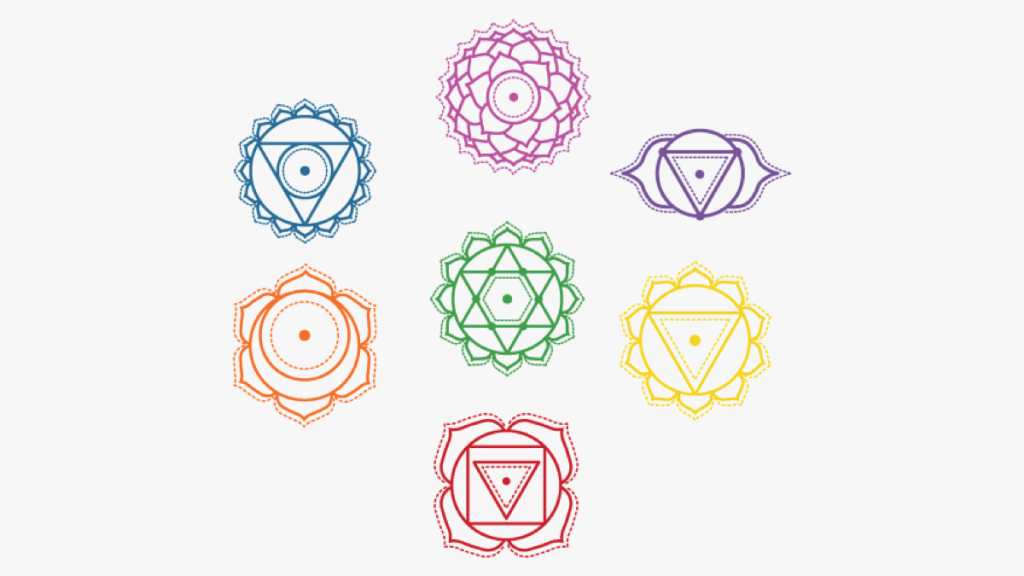
Heart Chakra
- Sanskrit Name: Anahata
- Location: Heart/center of chest
- Color: Green
- Balanced Attributes: Loving, peaceful, compassionate, unconditional love for yourself and others, generous, kind, empathetic.
- Imbalanced Attributes: Depressed, jealous, defensive, judgmental, spiteful. May excessively self-isolate from others. Fearful of intimacy.
- Mantra/Sound: YAM
- Gemstones: Rose quartz, jade, green calcite
- Affirmations: I am loved, loving, and lovable. I love myself unconditionally. My heart is open, loving, and pure. I give and receive love effortlessly and unconditionally. I love and accept myself just as I am.
Throat Chakra
- Sanskrit Name: Vishuddha
- Location: Throat/center of neck
- Color: Light blue
- Balanced Attributes: Able to express yourself verbally and speak your truth. Communicates clearly and effectively. Calm, honest, peaceful.
- Imbalanced Attributes: Shy, withdrawn, dishonest, critical, moody. If overactive, you may interrupt others or not allow others to speak.
- Mantra/Sound: HAM
- Gemstones: Blue lace agate, turquoise, sodalite, aquamarine
- Affirmations: I am able to calmly and effectively speak my truth. I live an honest, authentic, wholehearted life. My voice matters. I express myself clearly and openly. I find creative ways to communicate my self-expression.
Third Eye Chakra
- Sanskrit Name: Ajna
- Location: Center of forehead/between the eyebrows
- Color: Indigo
- Balanced Attributes: Intuitive and connected to your inner knowing. Imaginative, perceptive, openminded, insightful, mentally strong.
- Imbalanced Attributes: Lack of intuition, unimaginative, fearful, unable to focus, close-minded, holding onto limiting beliefs.
- Mantra/Sound: OM or SHAM
- Gemstones: Lapis lazuli, opal, sapphire
- Affirmations: I listen to my inner knowing in the face of uncertainty. I see and think clearly. My mind is strong, open, and clear. I trust my intuition to guide me to making good decisions.
Crown Chakra
- Sanskrit Name: Sahasrara
- Location: Top of the head
- Color: Violet (White is also often associated with this chakra.)
- Balanced Attributes: Spiritual, enlightened, connected to a higher power, connected to oneself. Divine peace and a sense of inner wisdom. Able to surrender to a power higher than oneself. Connected to your soul’s purpose.
- Imbalanced Attributes: Cynical, close-minded, disconnected from yourself, disconnected from a higher power. Lack of faith. Unable to connect with others.
- Mantra/Sound: OM (or silence)
- Gemstones: Selenite, clear quartz, amethyst, diamond.
- Affirmations: I am always divinely and lovingly guided. I release the need to control my life and surrender to a higher power. Today, I trust the path in front of me and allow myself to let go and surrender. I trust my intuition and listen to the wisdom of the universe.
Unblocking and Balancing Your Chakras
Now that you have an understanding of where each chakra is located and their distinct attributes, how exactly do you unblock a chakra?
As you may have guessed, there is no scientific answer here. We all have different methods of unblocking chakras, and what works for one person may not work as well for the other. But at the foundation of these practices, it’s most important to set an intention, lean into the process, commit, and believe.
Also remember that it’s very likely and totally normal to have more than one chakra blocked or unbalanced at a time. While each chakra has a separate location and role, they’re all intertwined and function as one complete system.
Consider this example: If your root chakra is blocked, you may be feeling unstable, insecure, restless, and possibly even unsafe. The root chakra is your very foundation, and without it being open, it would be nearly impossible to feel creative and joyful (sacral chakra) or confident and positive (solar plexus chakra).
Below is a list of several ways you can start balancing your chakras today.
Methods of Balancing Your Chakras
Yoga
There are specific yoga poses associated with each chakra, such as the mountain pose for the root chakra or child’s pose for the third eye. If you want to focus on balancing a specific chakra, you can center your practice on only those poses associated with that chakra. For a more balanced practice, incorporate poses that include all of the chakra points. If you’d like, you can also begin or end your practice repeating the mantra for one of the chakra points. (See the list of Chakras above for each one’s associated mantra/sound.)
Meditation
There are several ways meditation can help with unblocking chakras. You can use a visualization meditation to visualize the energy centers (in each chakra’s corresponding color) brightening, swirling, and glowing. You can also do a mantra meditation in which you repeat the mantras associated with each chakra to clear any blockages and imbalances. See the next section for some links to some powerful guided chakra meditations!
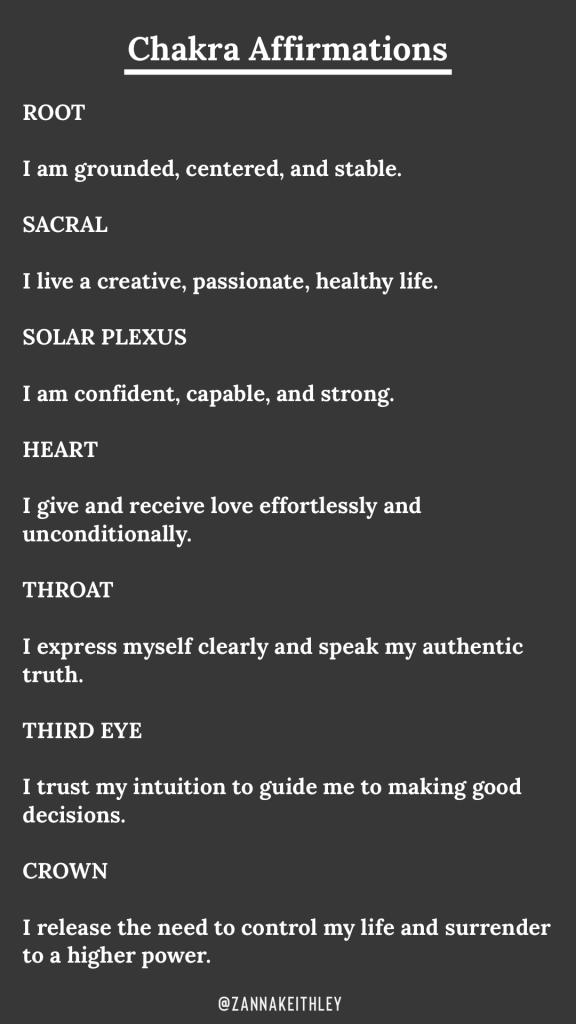
Chakra Affirmations Repeat Affirmations
You can use the affirmations I’ve written for each chakra above or come up with your own powerful affirmations. One of the best things about affirmations is that you can recite them anywhere. Repeat them in the shower, during your morning commute, or even standing in line in the grocery store. You can also combine affirmation practices with other methods on this list, such as meditation, journaling, and even dancing!
Essential Oils
Each chakra is associated with various essential oils that can help calm or stimulate that specific energy center. For instance, you might use cedarwood for your root chakra, lemon for the solar plexus, or peppermint for the throat. To use essential oils to help balance your chakras, apply a small amount of the oil to the chakra point. (While essential oils are generally safe, I would definitely recommend making sure you use a high-quality brand and following the guidelines of the manufacturer before applying anything to your skin. Depending on the type, some oils may require dilution. Definitely do your research and follow up with a health expert if you have any questions before applying.)
Colors
Solar plexus chakra feeling blocked? Wear yellow. Eat a banana. Paint with the color yellow. Make your own homemade lemonade. Find all the yellow items in your home and put them in your line of sight.
Journal
One of my favorite practices is to combine affirmations into my journaling. If you have 10 to 30 minutes to sit down for journaling, write down affirmations that focus on one, multiple, or all of your chakras. Another great practice is to visualize and describe your highest, truest, and most authentic self – the highest version of you when all of your chakras are aligned. The key here is to write in the present tense! Instead of writing, “I see myself as . . .” or “I will be . . .”, write, “I am . . .” Embody that version of your highest self and become that person as you write.
Dance
Dancing is a beautiful way to express yourself and enhance the flow of energy in your body. If you can, try to involve the body part related to any blocked chakras into your dance. For instance, if your heart chakra feels blocked, incorporate more chest movements into your dancing. You can also incorporate colors here as well! Remember to have fun, don’t take yourself too seriously, and surrender to the flow!
Immerse Yourself in Nature
Walk barefoot in the dirt (root chakra, associated with the earth; go swimming (sacral chakra, associated with water); have a (safe) bonfire (solar plexus chakra, associated with fire); take a cleansing walk as you focus on breathing in the fresh air (heart chakra, associated with air). If multiple chakras feel blocked, getting back to your foundations (nature and the earth) is one of the best ways to clear any blockages.
Food
Eat a food associated with the color of the chakra (i.e. a red apple, green spinach, orange carrot). Try to aim for something healthy, unprocessed, and nutrient-dense.
Crystals
You can use crystals associated with each chakra to activate that energy center. Some simple practices are to hold the crystal over the chakra point for three to five minutes, lay the crystal on the body for an extended amount of time, or to meditate with the crystal by either holding it or laying it on the body (if you’re laying down). If you want, you can even place all seven crystals on each chakra point at once while you’re laying down.
Express Your Creativity
Embrace ways to express your creativity, such as drawing, painting, dancing, singing, working with clay, writing poetry, or however you like to unleash your inner creative!
Chakra Meditations
The following meditations can all be found on the Insight Timer app (no affiliation). This is a free app that offers over 55,000 meditations and music tracks (all completely free). You can read more about why I choose this app as well as learn about different meditation practices for beginners here.
- Chakra Waterfall Meditation by Jessie Arielle Smith (6 minutes)
- Chakra Balancing by Kiran Chugani (8 minutes)
- Personal Transformation: Energy Centers Chakra Discovery by Dexter and Alessandrina (12 minutes)
- Guided Chakra Healing Meditation by Healing Haus (19 minutes)
- Sacral Chakra Therapy by Cory Cochiolo (19 minutes)
- Chakra Tune-Up by Gemma Clarke (21 minutes)
And that’s a a guide to chakras for beginners! Be sure to check the links at the top of this post to learn more about the individual chakras. Have any questions about chakras? Or have you discovered any practices that have helped you activate and balance your chakras? Leave a comment below to ask a question or share your experiences!

Chakras for Beginners: Unblock Your Chakras Today 
Zanna Keithley is an author, poet, and social media content creator who writes short prose dedicated to inspiring readers to follow their dreams, trust their intuition, and create beautiful and fulfilling lives. You can find her original writing on Instagram @zannakeithley.
-
Meditation Practices For Beginners
Below, you’ll find seven types of meditation practices for beginners, including mindfulness, body scan, visualization, and chakra meditations. I also provide you with links to guided meditations you can try at your home today.
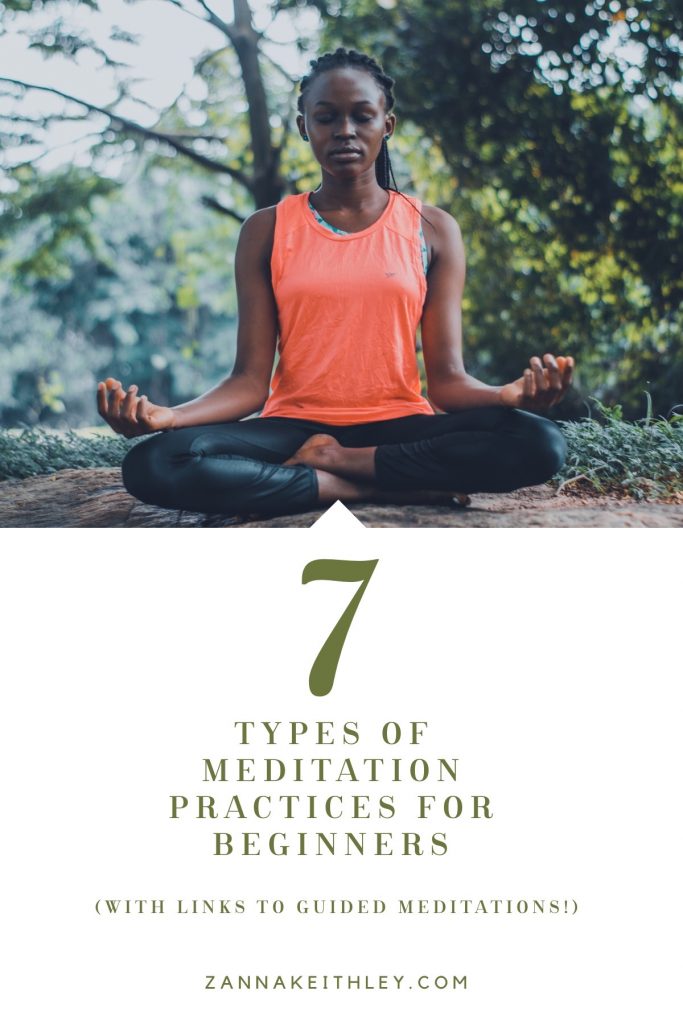
Pin this for later! 7 Types of Meditation Practices for Beginners Meditation
If you’ve never meditated before, the thought of starting a meditation practice can feel kind of daunting. How do you start? When’s the best time to meditate? How are you supposed to sit, and what the heck do you do with your hands?
Here’s my answer to just about every question when it comes to starting a meditation practice: start where you are with what you have.
There will never be a perfect time to start meditating, and yet, it is always the perfect time to start meditating. You don’t need any special equipment. You don’t need to wait for a certain time of day. And you definitely don’t need to cultivate the special superpower of being able to clear your brain of thoughts. At most, you just need yourself and a few minutes of quiet.
Below, I’ve listed seven of the best types of meditation practices for beginners. While you can definitely choose any of these in any order, I’d recommend starting with mindfulness meditation, as that lays the foundation for just about every other type of meditation.
At the end of each section, I link to associated meditations on the Insight Timer app. I have absolute no affiliation with the Insight Timer app; it’s just my personal favorite for meditation. While I’ve linked to the meditations on Insight Timer’s webpage, I definitely recommend downloading the app on your phone for easier access.
Of course, if you find a different app that you want to use, go for it. You can even try multiple apps and see which one you like best. While you don’t need an app to meditate, it’s definitely helpful when first starting out.
Meditation FAQs
Before I get into the different types of meditation practices for beginners, here are some answers to a few more common questions that you may have.
What time of day should I meditate?
When I first started, I thought I needed to meditate as soon as I woke up because that’s what I had read in articles and blog posts. Meditating first thing in the morning is a great practice. But so is meditating an hour after you wake up. Or two hours later, or at lunch time, or before dinner, or after dinner, or before bedtime. Basically, anytime you want.
There is no right or wrong time to meditate. Do it when you have time and when it feels right for you.
How should I sit when I meditate? And what do I do with my hands?
In many of the guided meditations, the teacher will give you some instructions on how to sit, usually giving you a couple options depending on what’s most comfortable for you. If you’re on the floor, you can sit cross-legged with your hands on your knees and your palms facing up or down. If you’re on a chair, you can sit with your back straight, hands on knees, legs uncrossed.
And it may seem weird, but you can even lay down as well. It took me a while to try a meditation laying down, but it truly gave me a different and enriching experience.
Now, I’ll choose different positions depending on how I feel and what kind of meditation I’m doing.
What if I can’t clear my mind of thoughts?
This is one of the biggest misconceptions of meditation and why many people believe meditation isn’t for them. If you listen to just about any meditation teacher, they’ll tell you the same thing: meditation is not about clearing your mind of thoughts. If it was, I’m not sure any of us, not even the most advanced meditators, would ever succeed. The last thing we want to do is suppress or evade our own thoughts.
At its heart, meditation (especially practices rooted in mindfulness) is about non-judgmental observation, conscious awareness, and gently rooting ourselves in the present moment. When you’re meditating and your mind strays, don’t berate or speak down to yourself. You are not “wrong” for having a thought.
When I first started, I’d use the phrase, “Ah, I’m having a thought.” I imagined I was observing something curious and interesting but that I didn’t need to hold onto. Once I recognized the thought, I’d release it and come back to focusing on my breath.
Allow yourself to become an objective observer of your own mind and accept any thoughts you have. Then, gently guide your brain back to the present moment.
7 Meditation Practices For Beginners
Mindfulness Meditation
What exactly is mindfulness meditation? First, let’s look at the word mindfulness. Have you ever gotten so lost in thought that you’ve forgotten where you are or what you’re doing? Do you find yourself thinking about an event from the recent past and going over all the details? Do you replay old scenes over and over again, getting pulled into those past emotions? Or what about making up scenarios and obsessively playing out scenes of the future that haven’t even happened?
Can you imagine living a life where you’re always living in the past or future—never in the present moment?
This is where mindfulness comes in.
Mindfulness is conscious awareness of the present moment through an unattached, objective, and unemotional lens. Mindfulness allows you to notice when your thoughts have strayed and gently return them to this present moment. The key here is that you don’t judge yourself for your straying thoughts. You can simply notice that you’re having a thought and then release it without judgment.
A common analogy is to think of it as clouds passing over you in the sky. Imagine you’re lying on the ground looking up at a perfectly blue sky, and a cloud passes over you. “Look, there’s a cloud,” you think. Then it floats out of your vision, and you let it go without attachment.
That’s kind of how it works with your thoughts. In mindfulness meditation, you’re not trying to rid your head of thoughts; you simply notice with objective awareness when you’re having a thought, and then you let it pass over you and return to this present moment.
So how exactly do you stay grounded in this present moment?
Most often, it’s through your breath. In many mindfulness practices, you simply keep your focus on your breath coming in and going out of your body. And when you find your thoughts going astray, you return your focus to your breath.
In the beginning, it might help you to use numbers or a counting system. For example, for every inhale, you may think a silent one, and for every exhale, you think two.
Or you can count to ten: every inhale is an odd number and every exhale is an even number. When you get to ten, you return back to one and start all over again.
Insight Timer Guided Meditation Practices for Beginners:
Kate James’ Mindful Awareness Meditation (just under 10 minutes) gently guides you through the act of bringing mindful awareness to your present experience. This is a really wonderful meditation for guiding you through the process of becoming an objective observer of yourself.
Laurie J. Cameron’s Mindful Breathing With Compassion is a beautiful 10-minute practice that combines mindful breathing with a loving-kindness practice.
Body Scan Meditation
Body scan meditation is an extension of mindfulness in that it allows you to consciously notice how different parts of your body are feeling in the present moment without judgment.
In a body scan meditation, you start at your feet and make your way up, paying attention to the way each body part feels. (If you prefer, you can start at your head and move downward.)
Are you carrying tension in this particular body part? Are there any feelings or sensations? Don’t attach any value to your answers. For instance, if you’re feeling tension in your shoulders, don’t label this as bad. Just notice.
Now, there are differing beliefs on what a person should do next.
For some, the act of simply noticing is the goal of this meditation. The reason is that this grounds you in the present moment and cultivates a sense of mindfulness.
Others go one step further by consciously releasing the tension they perceive. One way to do this is by breathing into the tension. As you exhale, visualize the tension leaving your body and evaporating into the air. Another technique is to tense up your muscles and then relax them. You might also visualize a wave of relaxation flowing through your body.
While a body scan meditation can be done anytime, it’s especially beneficial in helping you to relax at nighttime. If you find yourself lying in bed at night unable to fall asleep, don’t try to suppress your thoughts. Instead, you can do a body scan meditation right there in your bed. Simply relax your muscles and release the tension from each part of your body.
Insight Timer Guided Meditation Practices for Beginners:
Wendy Chan’s Mindful Body Scan (just under 11 minutes) is a simple but powerful meditation that gently guides you through noticing the different sensations in your body without any judgment or labeling the sensations as good or bad.
Tara Brach is one of the most well-known meditation teachers both on and off the Insight Timer app. Her Basic Body Scan & Breath Awareness (11 minutes) is a perfect meditation for beginners.
Loving Kindness Meditation
The goal of a loving kindness meditation is to extend kindness toward yourself and others in your life. In the first loving kindness guided meditation I ever tried, I was instructed to visualize I was standing in front of myself. I looked myself in the eyes, and I repeated these words:
May you be well . . . may you be happy . . . may you live with ease . . . may you know you’re always loved.
Then, I was instructed to picture someone I loved and cherished deeply standing in front of me and to recite those same words.
Next, I visualized someone who I sort of, kind of knew but who I didn’t have any positive or negative feelings toward, such as a grocery store cashier or a neighbor down the street. Again, I envisioned looking them in the eyes and repeating those words. T
hen, I was guided to envision someone I felt negative feelings toward, to look this person in the eyes, and to recite these same kind and loving words as well.
And finally, I extended these words to the entire universe in which I am connected.
There are many variations of a loving kindness meditation, but at their core, they all promote deep feelings of love and compassion.
One great thing about this practice is that you don’t have to be sitting alone in a dark room to practice loving kindness. If you’re a beginner, it helps to do a few guided loving kindness meditations to understand the process and follow some of the different variations of this meditation. Soon, though, you may find different opportunities to engage with these practices.
For instance, when you’re getting ready in the morning and find yourself feeling stressed about the day ahead, you can look at yourself in the mirror and repeat words of loving kindness. If you have a boss who causes you to feel negative emotions, you can visualize looking them in the eyes and repeating these same words. This doesn’t mean that you agree with or accept the things you may not like about them. What it means is that you have the power to realign with your highest self and to choose love over resentment, anger, or pessimism.
Insight Timer Guided Meditation Practices for Beginners:
I love Vanessa Michele’s Loving Kindness For Yourself & Others (10 minutes) to cultivate a sense of love and compassion for yourself and the world around you.
Camilla Sacre-Dallerup’s Loving Kindness and Compassion (10 1/2 minutes) meditation is a beautiful variation of a traditional loving kindness meditation.
Visualization/Guided Imagery Meditation
In a visualization meditation, you focus on a specific visual in your mind’s eye. If you’re doing a guided meditation, your instructor will gently guide you through a series of visuals that you follow in your mind.
At its foundation, visualization meditations are still rooted in mindfulness. When you’re practicing a visualization meditation, you may find your mind wandering, thinking about the day ahead or noticing the very loud garbage truck outside your house. It’s okay if your mind wanders. Just notice, then allow yourself to return to the visualization.
So in a visualization meditation, what exactly are you visualizing? This is where, if you’re someone who likes concrete directions and specific answers, you may get frustrated. Because the truth is, there’s an infinite amount of scenes you may visualize in your mind’s eye.
For instance, I’ve done a lot of manifestation visualizations. Some of these guide me through visualizing a perfect day in my dream life, while others have taken me to golden waterfalls where abundance is infinite and always flowing. I’ve also done visualizations where I’ve floated down a gentle river and allowed myself to flow effortlessly with the water, trusting where the water takes me. I’ve visualized journeys into my own heart where I explore all of the dark and light inside of me. And I’ve also visualized standing in front of a beautiful ocean and releasing all of my hopes and dreams into the sea, entrusting the water with all of my heart’s desires.
A key for many visualization meditations is to not only see these scenes playing out in your mind but to experience them with all of your senses. If you find this to be difficult at first, it’s okay. This doesn’t mean you’re doing anything wrong or that you’re not “cut out” for this type of meditation.
I encourage you to open yourself to the process and simply let it be whatever it is. It doesn’t have to be a big or overwhelming thing; I’ve experienced many incredible guided visualization meditations that were only ten minutes long.
- Related: How to Visualize (For Meditation)
Insight Timer Guided Meditation Practices for Beginners:
Carrie Suwal’s Attracting All That You Desire (10 1/2 minutes) is a powerful meditation for manifestation that includes both visualization and affirmations.
My overall most-played meditation on the Insight Timer app is Rishika Anya’s Breaking Through Limiting ThoughtForms (just under 11 minutes). This is a powerful visualization meditation to help you break through limiting thoughts that no longer serve your ultimate wellbeing.
Affirmations Meditation
Affirmations meditations are generally pretty straightforward. These are guided meditations in which a teacher recites a series of affirmations, and you repeat these affirmations, either silently or aloud.
Often, a meditation dedicated to reciting affirmations will focus on a specific topic. Some of the guided affirmation meditations you may find include affirmations for abundance, self-love, worthiness, and health. You can also find morning affirmations specifically dedicated to cultivating a positive mindset for the day ahead. There are even affirmation meditations dedicated to specific topics such as job interview or giving a big speech.
Usually, the teacher will advise you on how to follow along with these affirmations. Sometimes, instead of repeating them, you simply breathe into each one and feel them into your being.
Note that you may encounter affirmations in other types of meditations as well. For instance, in a guided visualization meditation for manifestation, the teacher may include affirmations to affirm your worthiness of beautiful abundance in your life.
Insight Timer Guided Meditation Practices for Beginners:
Liza Colpa’s Manifestation & Affirmation Practice To Gain Confidence (12 minutes) is a perfect one for utilizing both visualization and affirmations to guide you in your personal growth. I absolutely love all of Liza’s meditations, so if you like this one, I’d definitely recommend checking out her others as well.
Karen Wang’s Words of Affirmation (10 minutes) beautifully guides you through a series of affirmations for self-confidence and empowerment.
Chakra Meditation
Chakras are your body’s spiritual energy centers. When our chakras are unblocked, energy flows freely within our body, mind, and spirit, and we feel a sense of alignment and peacefulness. When a chakra is blocked, we feel imbalanced, and this often manifests in negative physical, emotional, and spiritual symptoms (anxiety, creativity blocks, and digestive issues, for instance).
Chakra meditations usually focus on unblocking any blocked chakras so energy can flow freely. Some meditations will focus on increasing awareness and unblocking one specific chakra, while others do an overview of all the chakras. Below is a list of the chakras, their associated colors, and their locations within your body.
If this is your first introduction to chakras, I’d recommend starting with a meditation that guides you through all of the main chakras. Once you feel like you have a good foundational understanding of chakras, you can search for guided meditations that focus on unblocking a specific chakra.
Insight Timer Guided Meditation Practices for Beginners
Dexter and Alessandrina’s Personal Transformation: Energy Centers Chakra Discovery is a 12-minute guided meditation that leads you through each chakra in your body and its associated color. It’s a really great one for beginners!
Carrie Suwal, who I mentioned above in the Visualization Meditation section, has some beautiful chakra meditations that focus on trauma, depression, healing the heart, anxiety, and overall balancing. Note that most of these are a little longer than the others that I’ve listed, but if you’re drawn to gentle voices like I am, I think you’ll really love Carrie’s soft and tenderhearted guidance.
Mantra Meditation
In a mantra meditation, you focus on a word or a single syllable (or sometimes a phrase) for the entirely of the meditation. If you focus on a word, this word has no meaning. You wouldn’t say something like love, kind, peace, or any other word you have a connection to. Often, this word may not even be in the same language you speak. Some common examples of syllables or words you may repeat include om and ram.
(Okay, because I’m one that doesn’t like labeling anything in meditation as “right” or “wrong,” I concede that there are mantra meditations out there that will use a word that holds meaning to you, such as love or peace, and while you may receive a different type of experience, there is nothing inherently bad about this.)
During your meditation, you’ll repeat your chosen mantra (or the one your instructor has provided for you) over and over again. There is no rush here. Keep a smooth, relaxed, even tone. Focus on the sound of the mantra, and when your mind wanders, bring yourself back to the sound, just as you would in a standard mindfulness meditation practice.
As in all of the types of meditation listed here, you’ll likely find variations of this practice depending on the teacher. I’d recommend starting out with a guided meditation for this one, but after a couple times, this is one type of meditation that you may feel more comfortable trying without guidance.
Insight Timer Guided Meditation Practices for Beginners:
One of the first mantra meditations I ever tried was Dexter and Alessandrina’s Ganesha Mantra Meditation for Removing Obstacles (14 minutes). I’d recommend trying out some of the other meditation practices I’ve listed above before this one, but when you’re ready to try something different, this offers a really unique and powerful experience.
Hannah Leatherbury’s Mantra of Peace is nine-minute meditation that uses a phrase in the Sanskrit language that translates to “Lead me from the unreal to the real; Lead me from darkness (ignorance) to light (wisdom); Lead me from death (limitation) to life everlasting (freedom).” She also has a beautiful five-minute Mantra of Wholeness.

Pin this for later! 7 Types of Meditation Practices for Beginners 
Zanna Keithley is an author, poet, and social media content creator who writes short prose dedicated to inspiring readers to follow their dreams, trust their intuition, and create beautiful and fulfilling lives. You can find her original writing on Instagram @zannakeithley.
-
10 Science-Backed Health Benefits of Meditation
If you’re thinking about starting a meditation practice or interested in finding out how your current practice is benefitting you, read below for the science on 10 of the most significant health benefits of meditation.
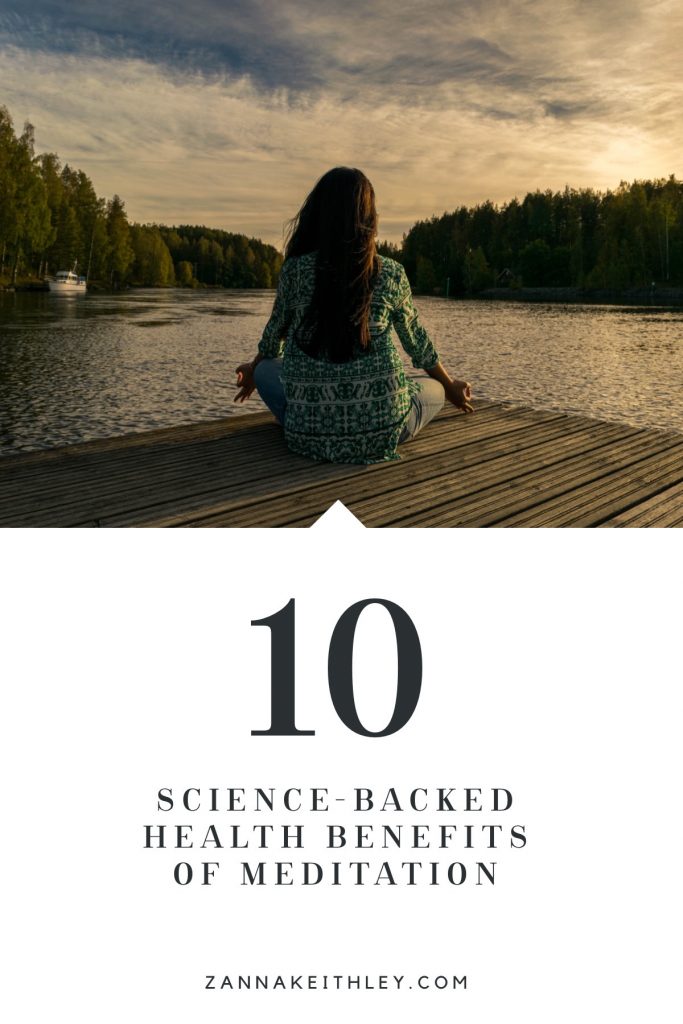
Pin this for later! 10 Science-Backed Health Benefits of Meditation Meditation
When I decided to try meditating for the first time, I was skeptical. Like many others, I was filled with doubts about whether I was even capable of meditating.
No way can I empty my brain of thoughts.
I’ll try it, but I’m not actually going to be good at it.
So I’m just supposed to do . . . nothing?
But through my meditation journey, I’ve learned that the goal of meditation isn’t to empty my brain of thoughts; the goal of meditation (mindfulness meditation, specifically) is to recognize (without judgment) when my thoughts have strayed and gently return to this present moment, over and over again.
Through this practice, I have learned how to become an objective observer of myself.
Which is a pretty big deal, after spending most of my life being a brutal self-critic.
To transform my default thoughts from inner bully to non-judgmental onlooker has been, well, pretty incredible.
In fact, these days, when I step out of my objective observer role, it’s to bring out my inner cheerleader. You see, most of my thoughts about myself now revolve around my own inherent worthiness. I now know I’m capable and deserving of living most honest and beautiful life I envision for myself.
I never imagined this path for myself when I reluctantly meditated for the first time several years ago.
However, I know that emphatic claims from family, friends, bloggers, and Instagram influencers can only go so far. Most of us need proof that meditation is so much more than just 10 minutes of sitting in silence.
That’s where the science comes in.
When I decided to tackle this subject, I had no idea what I’d find. Are there actually legitimate studies on the science-backed health benefits of meditation?
Yes, it turns out. Lots of them.
To say that I was blown away by the results would be an understatement; there are 1000s of studies and articles out there on the subject. (If you type “meditation benefits” in Google Scholar, you’ll get nearly 600,000 results.)
Below, I’ve compiled a list of 10 of the most compelling science-based health benefits of meditation.* These benefits come from multiple peer-reviewed studies and scholarly articles, and I’ve included links if you want to read deeper into each benefit.
*Please note that this content is for informational purposes only. It is not meant to substitute for medical advice, diagnosis, or treatment. If you have any questions regarding meditation and your personal health, please consult your doctor.
Health Benefit #1: Decreases Stress
This is a big one, and I list it first because decreased stress itself results in so many positive health benefits: improvements to your immune system, sleep quality, and weight management, to name a few.
First, I actually want to take a step back for a moment and say this: a little bit of stress in our lives isn’t actually such a bad thing.
Not that long ago, stress prompted our ancestors to run from the saber-toothed tigers. And now in our current world, stress propels us to swerve out of the way from that ongoing car. At its foundation, stress is meant to keep us alive.
But our bodies aren’t wired for the persistent stress we encounter today in work and our personal lives. And that’s why stress has become synonymous with a four-letter word in western culture.
But meditation can help.
Numerous studies have produced findings showing that meditation has a positive impact on a person’s stress levels.1 2 3 Studies even show that the use of a meditation app on your smartphone can significantly improve one’s stress levels. These apps may also generate an overall improvement in well-being, job strain, and perceptions of workspace social support.4 (Note that the meditation app Headspace offered free use of the app over the eight-week period in which the study occurred. However, it did not have any involvement in the actual study or conclusions formed.)
One study evaluated 351 full-time working adults with varying levels of meditation experience. The researchers found that those with more experience had higher levels of emotional intelligence, less stress, and better mental health.5
Health Benefit #2: Improves Mental Health
“Mental health” is a blanket term for one’s overall well-being, including our psychological, behavioral, and emotional states. Often, studies on the mental health benefits of meditation specifically focus on depression and anxiety.
One review that assessed 47 clinical trials and 3,515 total participants found evidence of improved anxiety and depression in patients over a period of just 8 weeks.6
Another study showed that meditation retreats resulted in reduced depression and anxiety as well as improved overall quality of life in its participants.7
Another two-year study followed 311 bipolar disorder II patients and found that meditation had positive effects on participants’ guilt, mood, and and feelings of helplessness.8
And lastly, another review found that meditation practices have been shown to be effective in reducing one’s anxiety symptoms.9
Health Benefit #3: Improves Immune System
A study published in the peer-reviewed journal Psychosomatic Medicine found that a mindfulness meditation practice can positively change immune function.10 Various other reviews and studies support these findings.11 12
One reason why meditation positively affects the immune system links back to #1 on this list: stress. Stress is known to suppress the immune system and can wreak havoc on the body. This results in chronic fatigue, metabolic disorders, and increased risk of heart disease, among other physical issues. By decreasing stress, a regular meditation practice can help your immune system work properly.
Health Benefit #4: Improves Brain Health
When it comes to our brain health, there’s promising evidence showing that meditation can have a significant positive impact.
One study found that meditation increased overall brain network integration. 13 And good news if you’re a non-experienced meditator: another study found that non-experienced meditators practicing just 13 minutes of meditation every day showed increases in mood and focus as well as increased working memory and recognition memory. And to top it off, these short meditation sessions produced similar positive behavioral effects as longer sessions. 14
Finally, another review assessed 13 separate studies, which all reported evidence of significant increases in grey matter in meditators’ brains.15 Grey matter is the outermost layer of the brain. It plays a vital role in how we function normally every day. While there’s still a lot of research to be done, this is compelling and hopeful evidence that meditation may positively impact and even offset neurodegenerative diseases.
Health Benefit #5: Decreases Blood Pressure
Interestingly, transcendental meditation often gets the spotlight when it comes to showing positive impacts of meditation on one’s blood pressure. One study looked at nine clinical trails and found evidence that transcendental meditation could significantly reduce systolic and diastolic blood pressure in a “clinically meaningful” way. 16 Another study found that a transcendental meditation practice can result in decreased blood pressure. The researchers noted these findings to be comparable to weight loss and exercise. 17
But it’s not just transcendental meditation that provides these positive results: another study found that non-transcendental meditation can also produce positive effects on blood pressure. 18
Health Benefit #6: Lengthens Attention Span
If you’re in school or have a highly attentive job, this one’s a big deal. One study found that a meditation practice helped to enhance nursing students’ attention span. It also reduced stress and increased mindfulness.19
There’s also good news if you’re unsure whether you want to commit long-term to a meditation practice. Another study followed participants for just five days and found they showed significantly improved attention spans (as well as decreased stress) when they incorporated a meditation practice into their routines. 20
Health Benefit #7: Improves Chronic Pain
Multiple studies provide evidence that mindfulness meditation can improve a person’s chronic pain symptoms.21 22 Additionally, meditation has shown to improve the psychological effects associated with chronic pain. This includes depression and overall quality of life. 23
Side note: If you suffer from chronic pain, check out the meditations on the Insight Timer app specifically created for those who are experiencing constant and extreme pain. Often, the teachers who release these meditations have experienced or are experiencing similar hardships. I know it seems impossible that meditation can make this pain go away, but know that these teachers see and feel your suffering. They’re there to guide you to a place where this pain no longer becomes your identity, and you can live in a space of deep calmness.
Health Benefit #8: Improves Sleep Quality
If you’re someone who struggles with getting a restful night’s sleep, meditation may help. One study looked at adults with moderate sleep disturbances and found that mindfulness awareness practices produced better results in improving the participants’ sleep than sleep hygiene education and suggests that these practices could be used to help remediate sleep problems and thus improve overall quality of life. 24
If you experience more prominent sleep problems, there’s some promising news for you, too: the American Academy of Sleep Medicine released findings showing that a meditation practice can be an effective treatment for insomnia. 25
Health Benefit #9: Increases Lifespan
Researchers at UC San Francisco found evidence that meditation may slow the rate of cellular aging. 26 But how exactly does that work? First, we need to understand the function of telomeres. Telomeres are the cap at each end of a chromosome that protects our chromosomes from deterioration. Over time, telomeres shorten and cause our cells to age. This is where you might have heard the concept of biological aging. When you hear that a 50-year-old is biologically only 30 years old, this is because the length of their telomeres is more aligned with what you would typically expect to see in a 30-year-old.
Constant stress is known to impact telomere length negatively. However, the researchers at UC San Francisco found that certain forms of meditation can have beneficial effects on telomere length and increase positive state of mind, thus preventing factors such as stress and depression from shortening telomere length.
Health Benefit #10: Enhances Self-Awareness
While my personal experience is only anecdotal, this is one that I can wholeheartedly speak to. As I mentioned in the intro, meditation has helped me to become an objective observer of myself. Do I still have negative and self-defeating thoughts? Absolutely. But instead of letting myself become consumed by those thoughts, I’m able to step back and notice when they’re happening. And then, after I notice without judgment, I have the power to redirect my thoughts to a more positive place.
The science on this topic suggests I’m not completely off-base for crediting this newfound self awareness to my daily meditation practice. There have been numerous studies and reviews that speak of the positive effect meditation has on one’s own self-awareness. 27 28 29 Another study shows that a mindfulness practice may help reduce “cognitive rigidity,” which allows for more creative problem solving. 30 By becoming more self-aware, you’re able to step back and see the bigger picture, thus allowing you to form different, more creative solutions rather than being blinded by your own past experiences.
Conclusion
While the list above includes ten of the most significant health benefits of meditation, there’s even more evidence out there showing that meditation has the potential to improve our overall mental, physical, and emotional well-being. On top of this (and something I can personally vouch for), it can also enhance one’s own self-image and self-worth. There’s still a ton of research to be done, but the research on the health benefits of meditation that has been done has been extremely promising and overwhelmingly positive.
Discover More About Meditation
- 7 Types of Meditation Practices for Beginners
- What is Mindfulness? Plus 15 Powerful Mindfulness Quotes
- A Beginner’s Guide to Chakras

Pin this for later! 10 Science-Backed Health Benefits of Meditation 
Zanna Keithley is an author, poet, and social media content creator who writes short prose dedicated to inspiring readers to follow their dreams, trust their intuition, and create beautiful and fulfilling lives. You can find her original writing on Instagram @zannakeithley.
-
10 Journal Prompts for Manifestation
Below are ten powerful journal prompts for manifestation, designed to aid you in creating your dream life. These prompts are filled with visualization, affirmations, gratitude practices, and lots of self-love. Keep an open mind and an open heart as you start each journaling entry, and remember that you are worthy and deserving of living the joyful and abundant life of your dreams.

Pin this for later! 10 Journal Prompts for Manifestation Getting Started With Journaling
Journaling is one of the most powerful and underrated tools we have in our toolkit to create the lives of our dreams.
While it’s not a requirement for manifesting, it’s a profound tool for setting intentions, visualizing your dream life, and aligning your energy your highest and most authentic self. Using journal prompts can be especially helpful for sparking new ideas and helping you to explore your inner world in a deeper and more profound way than you ever have before.
Manifestation journal prompts can be rooted in visualization, affirmations, gratitude, and anything that helps you to align with the thoughts, feelings, and beliefs of your highest, most authentic self. You’ll find a bit of each in the journal prompts below.
But journal prompts are really just the start when it comes to manifestation journaling. I have a ton of journaling resources across this site, so if you want to try out some other types of journaling practices, here are some resources to help you get started:
- For beginners, you can start with my in-depth guide on how to manifest in a journal. You can also download a free manifestation journal template and check out these manifestation journal examples for inspiration.
- For more specific practices, you can try out the 369 Method and 55×5 Manifestation Method.
- I also have lots of resources for scripting, which is a method that combines journaling with visualization to experience what it’s like to live your dream life in the present moment. You can get a free Law of Attraction scripting template and scripting examples to help you get started.
- Finally, I go deeper into how to manifest on paper in five easy steps, with bonus tips to help you get started.
That’s really just the beginning of all the manifestation guides you can find on this site, so I definitely encourage you to check out the rest of my manifestation blog posts and resources to help you on your journey.
Download 30 Perfect Days: A 30-Day Manifestation Journal Today!
Are you looking for a manifestation journal you can start using today? Check out 30 Perfect Days, a digital manifestation journal available in my online shop! This 30-day manifestation journal is designed to help you align with the emotions of having your dreams and desires in the present moment. Each day, you’ll receive a unique scripting prompt that will help you to live as if you already have your dreams and desires right now. Additionally, you’ll find space for daily gratitude, acknowledging the miracles that appear in your everyday world, uplifting affirmations, and more. Comes with editable text fields so you can choose to either type directly into the journal or print and hand write! Click here to learn more!
Manifestation Journal Prompts
Below are 10 powerful journal prompts for manifestation, designed to help you create the beautiful, joyful, and abundant life of your dreams. These journal prompts for manifestation can be completed in any order you want, and you can even choose the ones you like best to do multiple times.
Journal Prompt: Visualization of Your Dream Life
Write the details of a full day in your dream life. Use the present tense. (“I am . . . “; “I wear . . .”; “As I walk through my home, I notice . . .”) Where do you wake up? Who are you with? What does your morning routine look like? Describe the details of your home. Where is it located? What do you do during your day? What do you wear? Where do you go during the day? If you work, what kind of job do you have? What are the predominant emotions you feel throughout the day?
Use all your senses; describe what you see, hear, smell, taste, and touch. How do you feel when you go to sleep? What are your last thoughts before falling into a peaceful slumber?
Be as detailed as possible, and remember to keep an open mind to any and all possibilities. This is your dream life. You’re the creator. Let your inner knowing guide you through your vision.
Why It Works: The first step of manifesting is to set an intention. In order to create the life of your dreams, you first have to get clear about what you want. In manifestation, you don’t need to know how you’re going to achieve your dream. Rather, you just need to know what it is that you want. This practice will help you to gain a clearer vision of exactly what your dream life looks like. It will also help you to feel all of the positive vibrations of having your dreams in the present moment, allowing you to become a magnet for your desires.
Journal Prompt: Gratitude
Write down everything you’re grateful for today. There is nothing too small or too offbeat to write about. If it helps, you can use the prompt, “I am grateful for ___ because _____” to discuss each item in detail. If you get stuck, consider writing about different people in your life. You can also discuss various objects in your home or moments of your life that you’re grateful for. Nothing’s off limits here. You can even discuss adversity and hardships that brought you growth.
Why It Works: Gratitude is the foundation for all abundance. When I began consciously cultivating a daily gratitude practice and shifted my default perspective from one of lack to one of appreciation for all that I have, my life completely transformed. All of the things I’d written on my vision board that once seemed so far away were suddenly in my grasp. The quickest and easiest (and most joyful) way to receive abundance is to just love and appreciate all that you already have.
As Rumi wrote, “Wear gratitude like a cloak and it will feed every corner of your life.”
Journal Prompt: Body Appreciation
Write down a list of everything you’re grateful for about your body. Consider each body part: each muscle, limb, organ, and system that keeps you going throughout your life. If you’d like, you can choose a few body parts to write several sentences on (such as the mouth that shows your radiant smile and allows you to taste yummy food). Here are some examples:
- “I am grateful for my eyes because they allow me to _________.”
- “I am grateful for my heart because it is __________.”
- “Today, I really appreciate my legs because they __________.”
Why It Works: Same as #2, but this time, we’re focusing solely on your body. Why? Because your body is your home. It’s where you live every single day. It’s an incredible gift to have these bodies. To have working lungs and a beating heart. Yet, so many of us tear our bodies apart. Whether or not your intended manifestation relates to your body, cultivating a deep love and appreciation for your body (and treating it like an ally, not an enemy) will only serve to open up space for your manifestations to happen faster. Here are 42 body-positive affirmations to help you get started.
Journal Prompt: Speak to Your Younger Self
Imagine that the five-year-old you is standing in front of you, and in your mind’s eye, envision looking into the eyes of your younger self. Now write positive affirmations to this younger version of you as if you’re speaking directly to them. Tell them how worthy, deserving, and loved they are. Deliver them positive and supportive messages. Speak with wholehearted love, kindness, and compassion. This entire journal entry is dedicated to affirming your worthiness.
Why It Works: In order to manifest your desires, you have to truly believe in yourself. And most importantly, you must believe that you are worthy and deserving of your dreams. Speaking to your younger self helps you to let down your guard. Sometimes, we have a hard time telling ourselves that we deserve joy, but when you look into the eyes of your childhood self, it becomes easier. (But if you’d rather look into your own eyes as an adult, or choose a different age, definitely do whatever feels best for you.)
Journal Prompt: Passion and Purpose
What drives you? What lights up your heart? Where are you happiest? What activities make you feel most joyful and alive? Write about the things that you feel passionate about. These can be dreams, causes, groups of people, or important messages you want the whole world to know. Write with passion and conviction. What’s important to you? Only you know what makes your soul feel alive. There’s no right or wrong answer. As you write about your passions and dreams, consider ways you might be able to combine these different passions into a career or pastime that will make your heart soar.
Why It Works: You have a unique set of skills and passions that make you you. Do you love to write? Are you passionate about fitness? Does it light up your soul to help others? When you write about your passions, you open yourself up to inspired ideas. Allow the words to flow without self-judgment. See where it takes you.
Journal Prompt: New Perspectives
Write in detail about your day yesterday (or a recent day that you can remember vividly). Who did you see and speak to? What did you eat? Did you drive anywhere? What movies, TV shows, or sports events did you watch? What moments brought you joy? Discuss any obstacles or hardships you encountered throughout the day. How can you reframe these negative experiences positively? What did you learn from these moments? How did you grow?
Even if yesterday felt like a crummy day, write about it as if it was actually a really great day. This isn’t asking you to suppress the bad. Rather, consider choosing a different perspective when possible. For instance, maybe standing in line at the grocery store for what felt like an eternity or hitting all those red lights were really opportunities to pause and breathe.
What happened during this day that you’re grateful for?
Why It Works: This ties back to gratitude. Our lives are the sums of stories that we tell ourselves. And in manifestation, you attract what you put out in the world. So if you believe that you’ve had bad day after bad day after bad day, you know what you’ll attract? More bad days. But if you shift your perspective and choose to view these days as positive opportunities and experiences that you feel grateful for, you know what’ll happen then? You’ll receive more positive opportunities and wonderful experiences to feel grateful for. You don’t have to suppress the bad stuff. Rather, consider all the ways these “bad” things helped you to grow.
Journal Prompt: Your Highest and Most Authentic Self
Envision your highest and most authentic self. This is the real you—the truest, most authentic version of you. What is your highest and most authentic self like? How do you make other people feel? How do you move about your day? Are you energetic or calm? How do you speak? How do you walk? What’s your aura like when you walk into a room? What kinds of activities do you do? Do you move fast or slow? What types of clothes do you wear that make you feel good? If you’d like, you may envision a typical day in your life, and imagine how your highest self would react to the various ups and downs of your day.
Why It Works: This helps you get clear on what you want and who you want to be. Aligning with your highest self will serve you in your daily life as you make important decisions and choose how to spend your day. Whenever you’re unsure about something, you can ask, “What would my highest and most authentic self do in this situation?”
Your highest self is the person living your dream life, so by making the same decisions that this version of you would make, you’re choosing the path that leads directly to your dreams (and becoming the person you dream of being).
Journal Prompt: Celebrate You
What are your favorite things about yourself? What are your talents? In what ways are you an awesome friend? What makes you a good employee and/or manager? What makes you a good partner? List some of your superpowers. This is the day to celebrate you. Compliment yourself. Write about the compliments other people give you. And accept those compliments! If you get stuck, write down some positive affirmations. Affirm your worthiness completely.
Why It Works: When you believe in yourself, the rest of the world will have no choice but to believe in you, too. You deserve to be loved, and you deserve to be celebrated. One of the biggest obstacles to manifestation is simply not believing in yourself. After all, most of us are our own biggest critics. Starting self-love practices like saying positive affirmations and affirming your worthiness will help you begin your manifestation journey with a foundation of love, compassion, and an open heart.
Journal Prompt: Envision Your Success
What would you do today if you knew you wouldn’t fail? List out all of the things you would do today if you knew undoubtedly that you would succeed. As you write, visualize your success. Imagine how this will feel and write out these feelings. Don’t limit yourself, and don’t hold back.
Why It Works: More visualization, but this time, it’s a little closer, as these are all the things that you would do today if you knew you couldn’t fail. As I said earlier, you don’t need to figure out the how when it comes to manifesting. The universe will always guide you to the next step when the time is right, and you’ll always know that it’s right by the way it feels. Notice how you feel as you write. Do any of these fearless steps feel really good? One of my all-time favorite quotes is by Jack Canfield: “Everything you want is on the other side of fear.” Our fears sometimes prevent us from taking the next step, but if you knew you couldn’t fail, what would you do?
Journal Prompt: Letting Go
In what areas of your life are there things you can let go of in order to make room for new opportunities and exciting possibilities? What things are you justifying keeping, and why? When you let go of a job, person, belief, or another aspect of your life that may be holding you back, it’s easy to see what you’ll lose but hard to see what you might gain. Focus on the possibilities and experiences you might gain by letting go of the things that are holding you back.
Why It Works: In order to allow new people, experiences, opportunities, and resources into our lives, we need to make space for them. Sometimes, there are people, experiences, or things that once served our growth, but now they no longer contribute to our total well-being. Identifying these things is the first step. Letting go is the next, often more difficult step. I’ve let go of friendships, jobs, and even entire cities during my journey, and while it was never easy, it opened up space for new incredible people and experiences to enter my life. It isn’t always easy, but when you know in your heart that it’s the right choice, it’s always worth it.
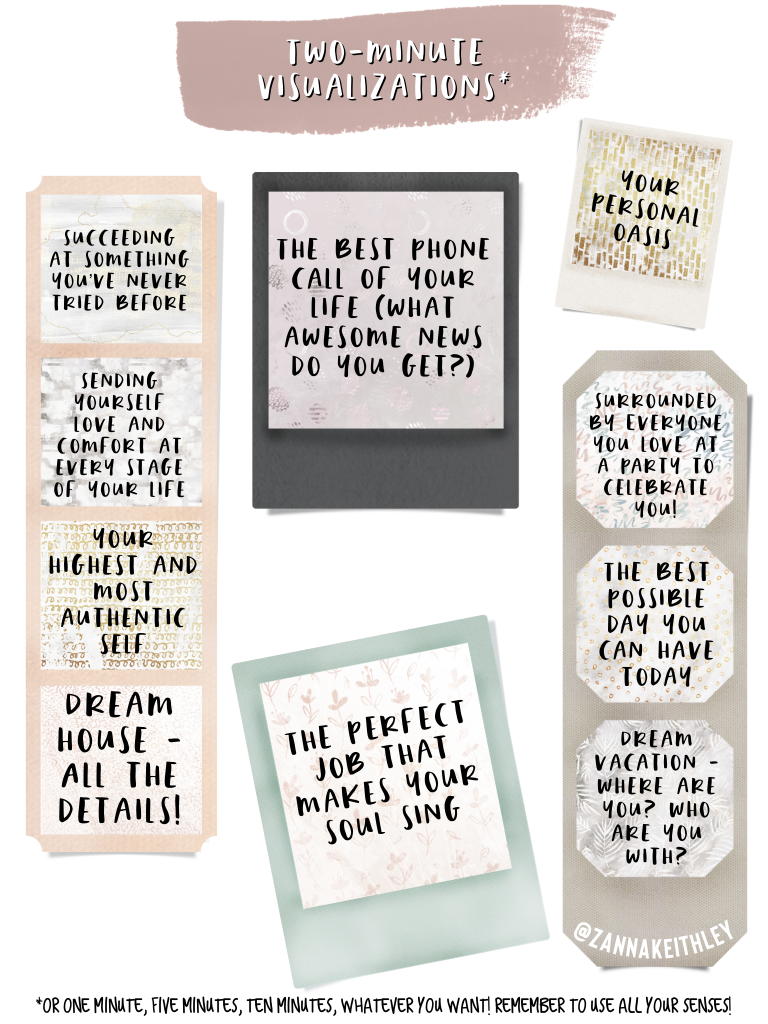

Pin this! 10 Journal Prompts for Manifestation 
Zanna Keithley is an author, poet, and social media content creator who writes short prose dedicated to inspiring readers to follow their dreams, trust their intuition, and create beautiful and fulfilling lives. You can find her original writing on Instagram @zannakeithley.
-
10 Inspiring Abraham Hicks Quotes (for Instagram)
Below are 10 inspiring Abraham Hicks quotes created on beautiful graphics designed especially for Instagram. Feel free to use and share on any social media platform or save to your devices when you need an extra dose of inspiration!
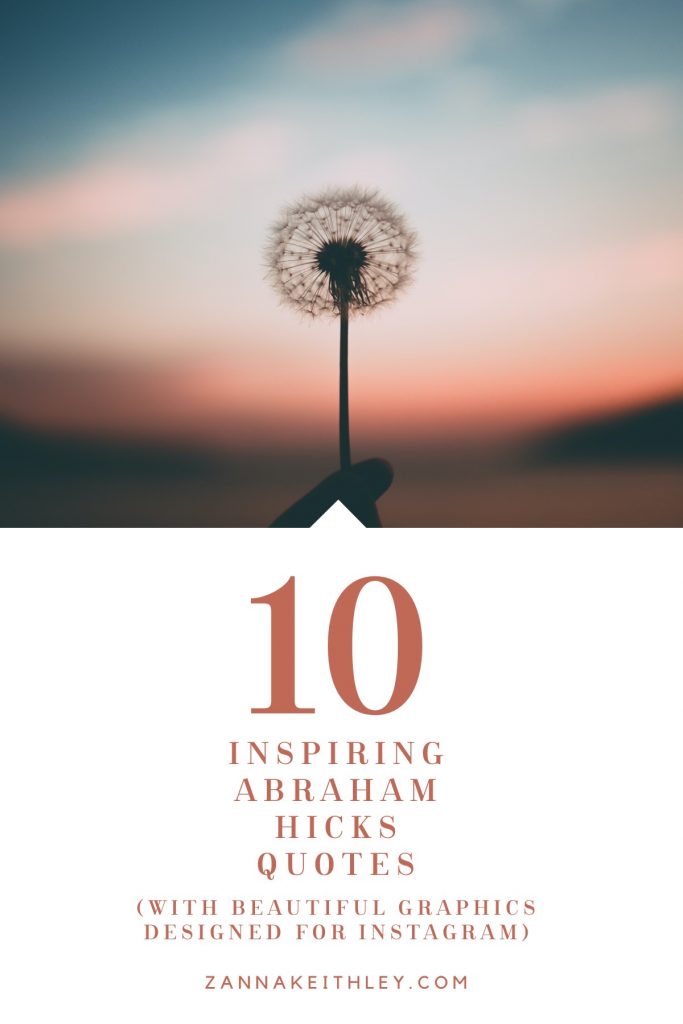
Pin this for later! 10 Inspiring Abraham Hicks Quotes (For Instagram) Updated December 9th, 2021
Abraham Hicks
Abraham Hicks is a powerhouse in the Law of Attraction space. Major figures such as Gabby Bernstein often draw inspiration and credit Abraham Hicks (and Esther Hicks) for shaping their thinking and influencing their work.
It’d be easy to create an Instagram page solely dedicated to Abraham Hicks’ quotes (and many do!) In honor of these inspiring and uplifting words, I’ve created ten graphics of powerful Abraham Hicks quotes for you to use freely on Instagram (or any social media platform). These can also be used as your own personal inspiration by saving them to your laptop, tablet, or phone or hanging them around your workspace. You can also share with a friend who may need an extra dose of inspiration!
If you use these on social media, I’d love it if you tagged me so I can like, comment, support, and cheer you on in your journey as you follow your passions and create the life of your dreams!
And be sure to check out 44 inspiring Abraham Hicks affirmations for joy and manifestation. In this article, I’ve chosen 44 of my favorite Abraham Hicks quotes that you can use daily as uplifting affirmations.
You May Also Like: Abraham Hicks’ Emotional Guidance Scale Explained
More Articles You May Like
- 369 Manifestation Method: What It Is & How To Do It
- How To Practice Gratitude (For Law Of Attraction)
- How To Manifest On Paper In 5 Easy Steps
- Morning Routine Checklist For Manifestation (Free Printable PDF)
- Manifestation Challenge: Free 30-Day Manifestation Calendar
- Candle Colors For Manifestation (A Complete Guide)
10 Inspiring Abraham Hicks Quotes
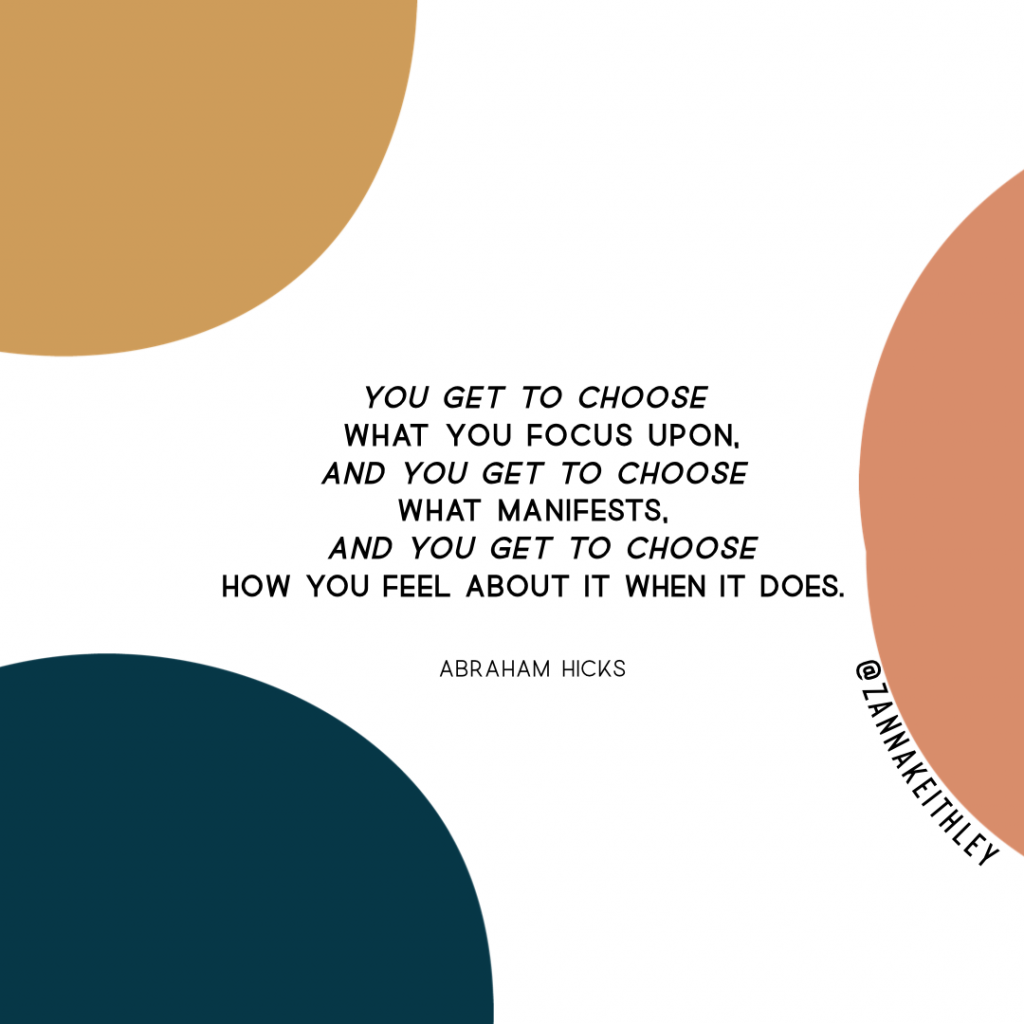
“You get to choose what you focus upon, and you get to choose what manifests, and you get to choose how you feel about it when it does.”
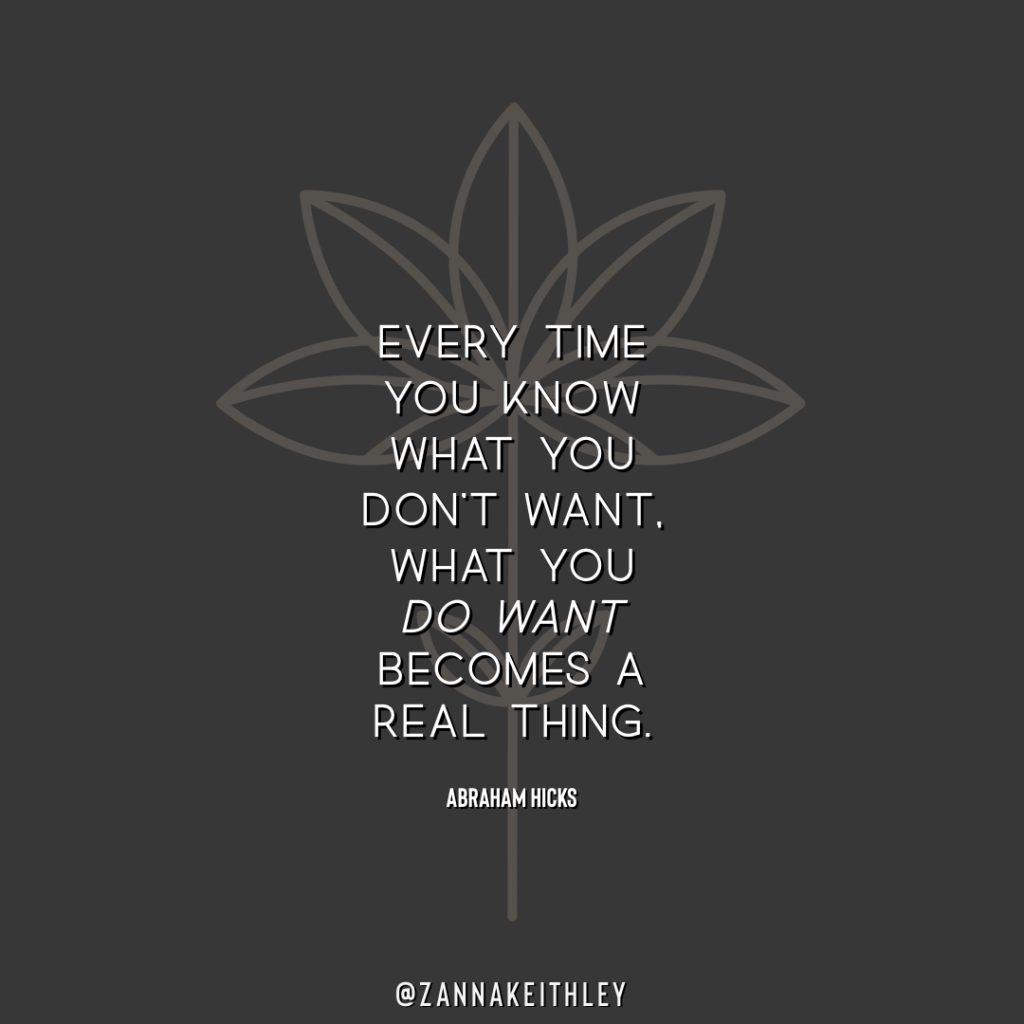
“Every time you know what you don’t want, what you do want becomes a real thing.”
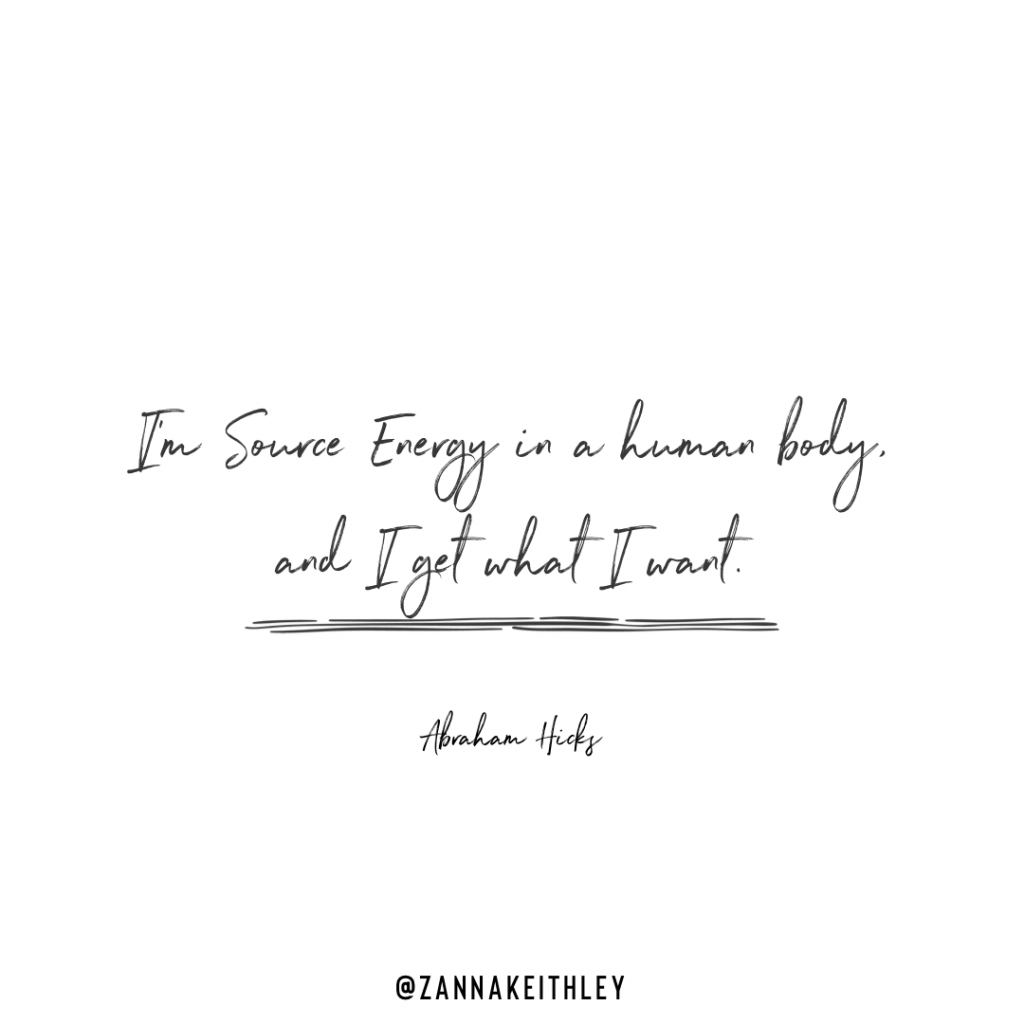
“I’m Source Energy in a human body, and I get what I want.”
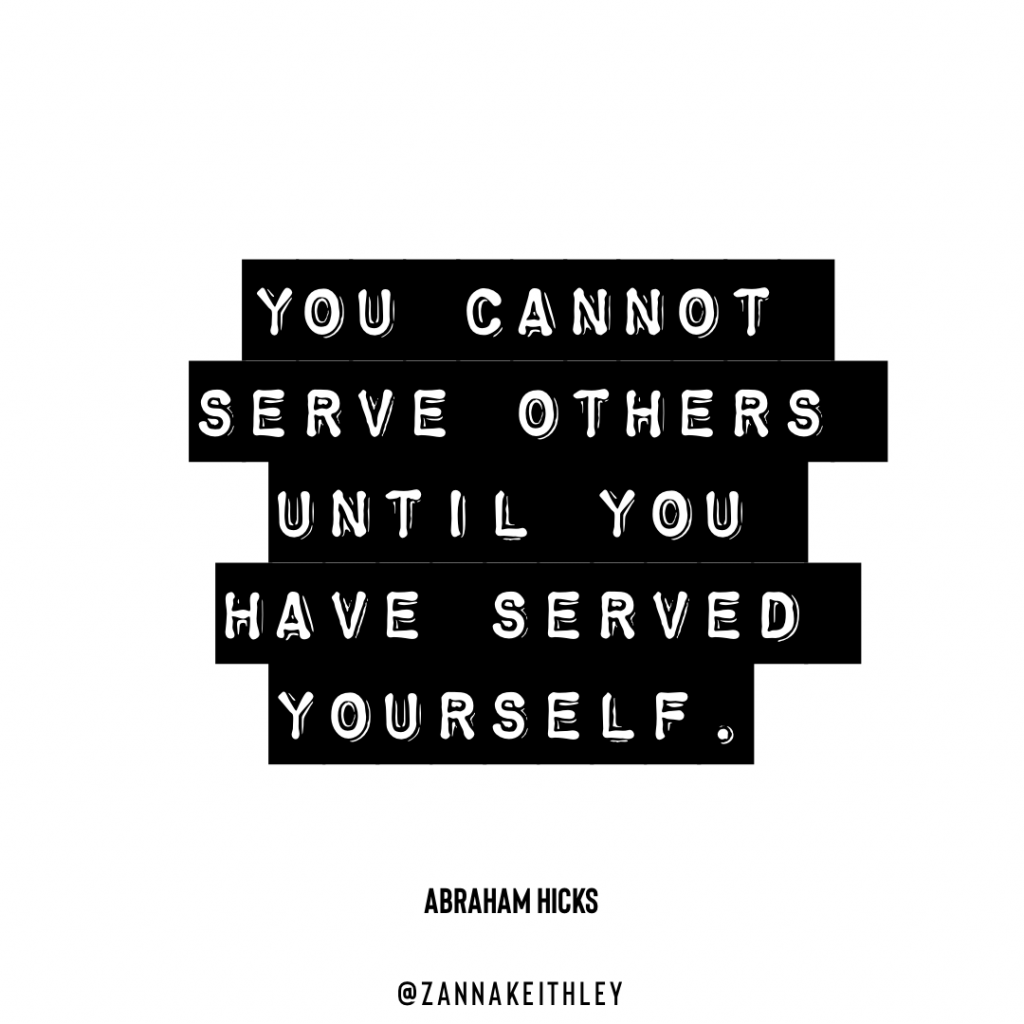
“You cannot serve others until you have served yourself.”
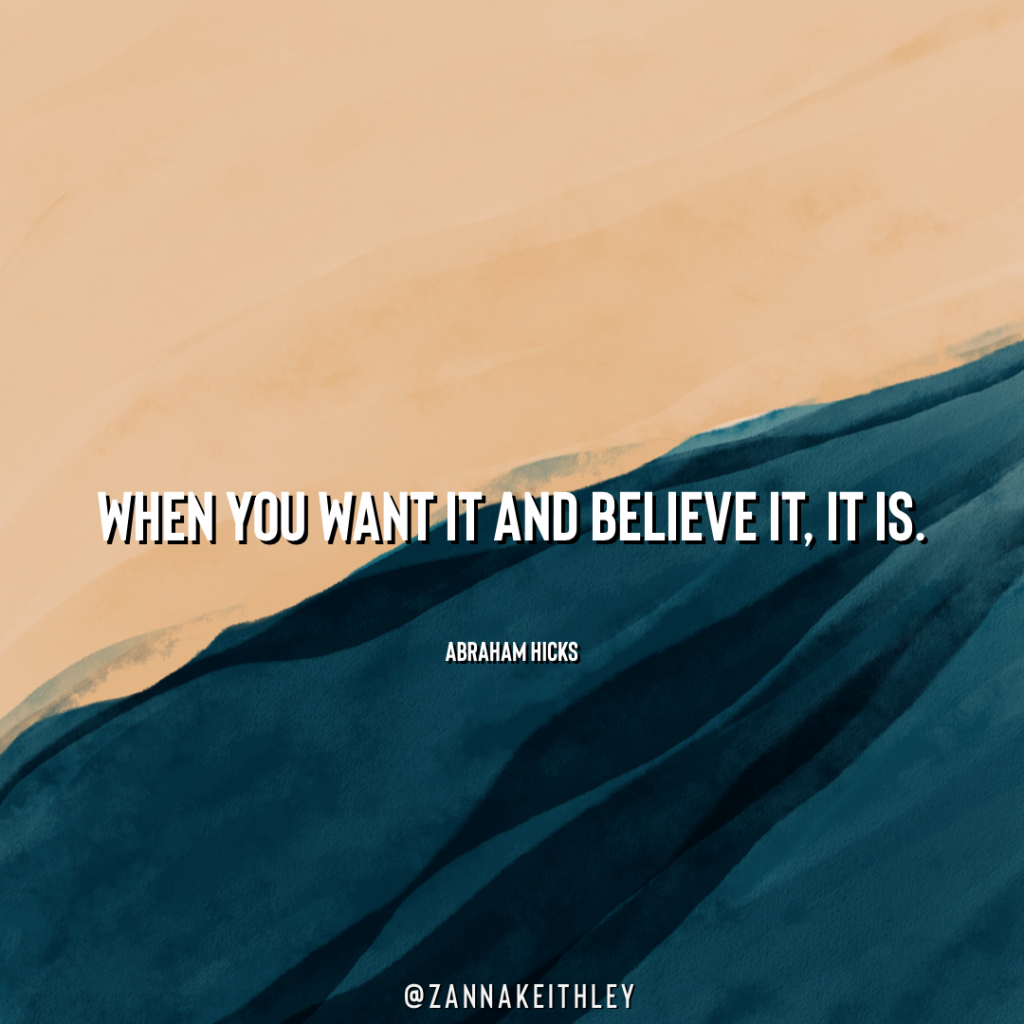
“When you want it and believe it, it is.”
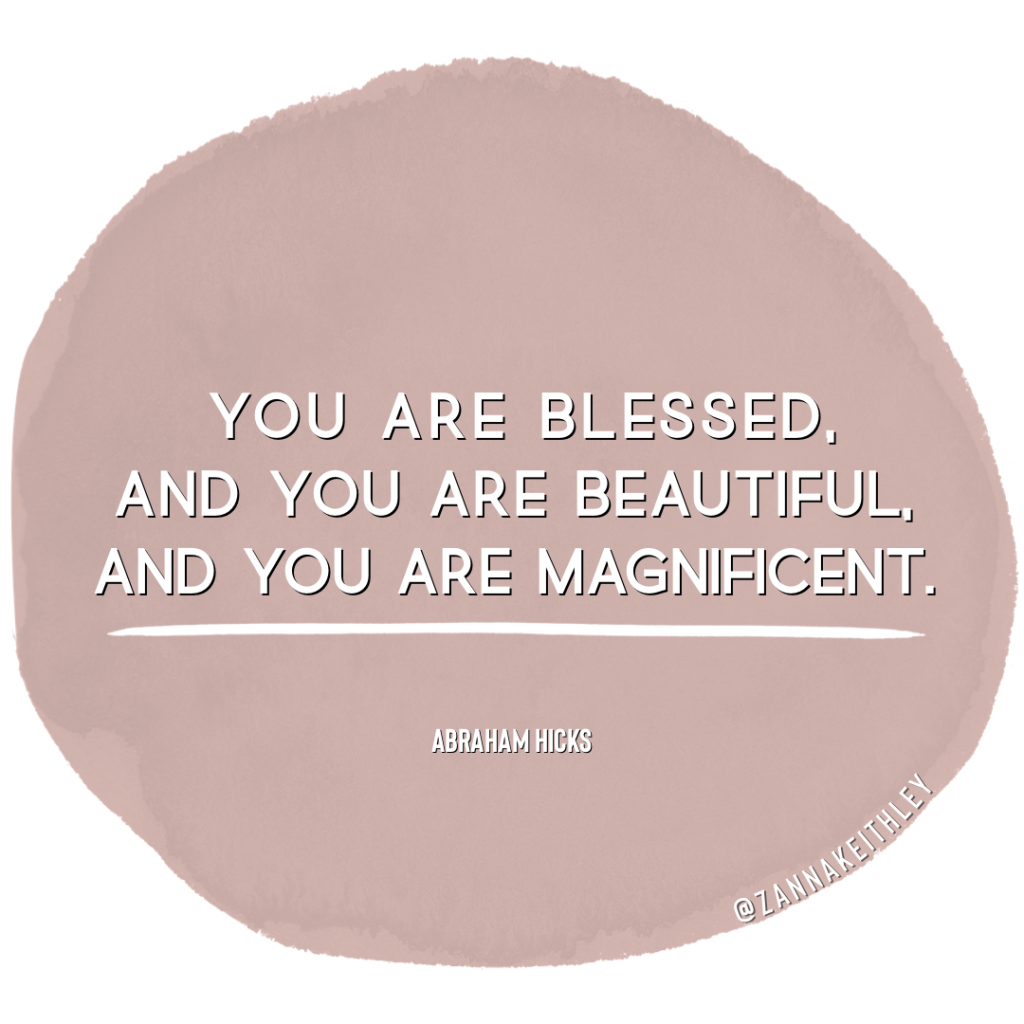
“You are blessed, and you are beautiful, and you are magnificent.”

“You are more powerful than you know.”
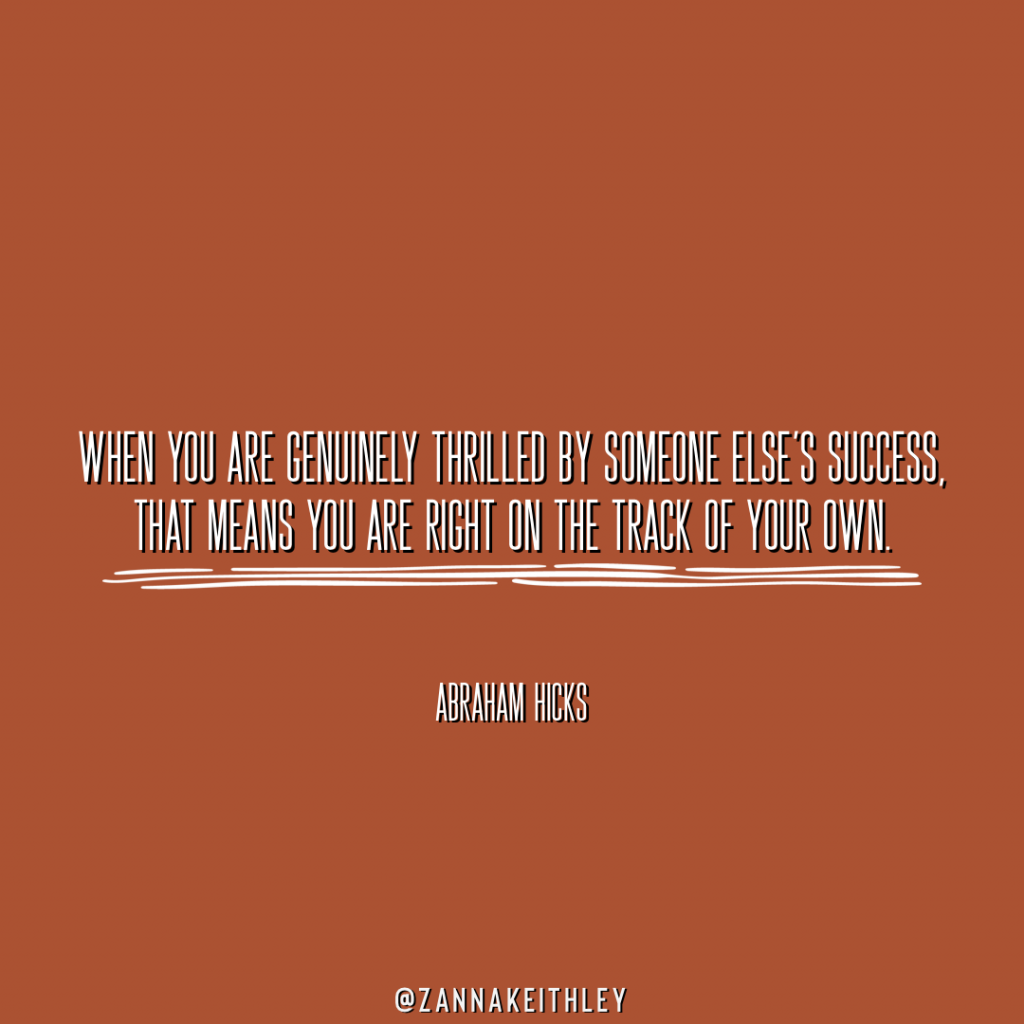
“When you are genuinely thrilled by someone else’s success, that means you are right on the track of your own.”

“There is so much love here for you.”
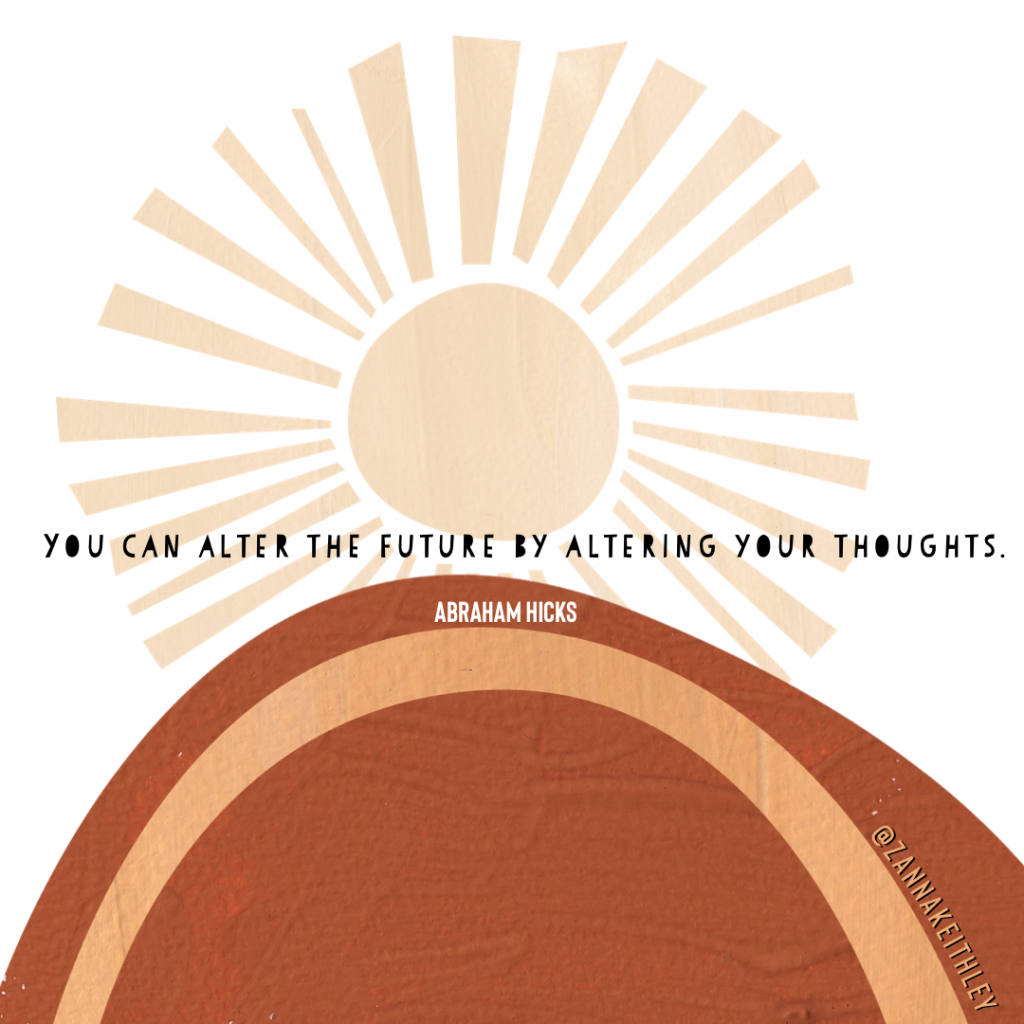
“You can alter the future by altering your thoughts.”
Do you want a daily dose of self-love, positivity, and uplifting affirmations to affirm your worthiness? Be sure to connect with me on Instagram, where I post daily affirmation stories every single morning. And don’t forget to follow me on Pinterest where I’m pinning positive affirmations and empowering quotes every day!
More Articles For You
- 4 Undeniable Reasons Why You Are Not Broken
- 30 Journal Prompts For Self-Growth & Deeper Self-Love
- 50 Positive Affirmations To Fall In Love With Yourself
- 11 Beautiful Poetry Books About Self-Love & Acceptance
- 44 Spiritual Growth Quotes For Your Spiritual Journey
- 100 Wholehearted Promises To Make To Yourself Today

Pin this for later! 10 Inspiring Abraham Hicks Quotes (For Instagram) 
Zanna Keithley is an author, poet, and social media content creator who writes short prose dedicated to inspiring readers to follow their dreams, trust their intuition, and create beautiful and fulfilling lives. You can find her original writing on Instagram @zannakeithley.
